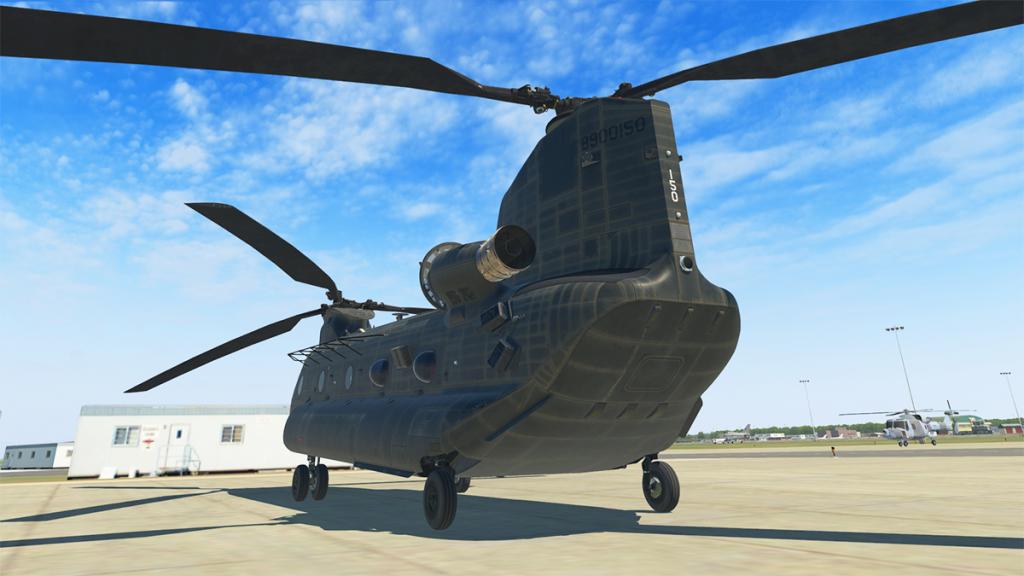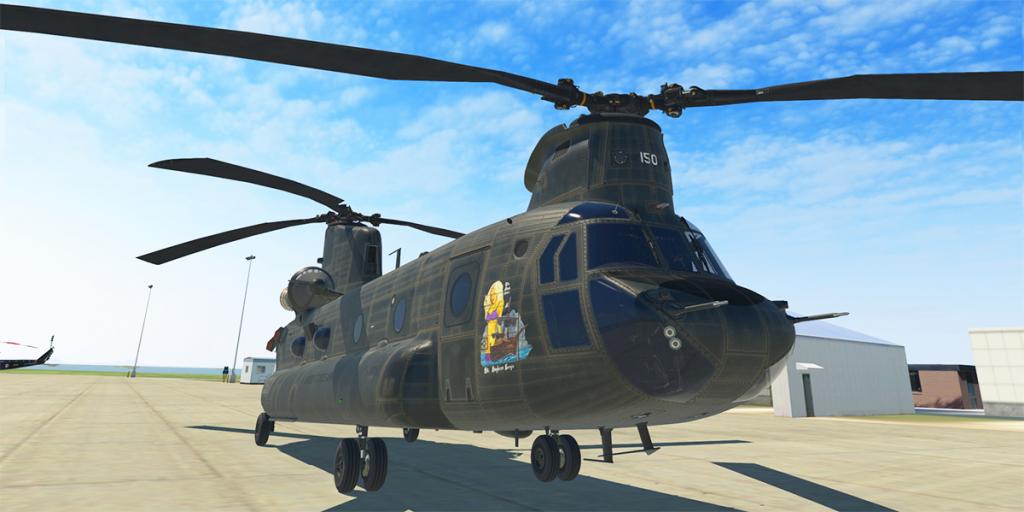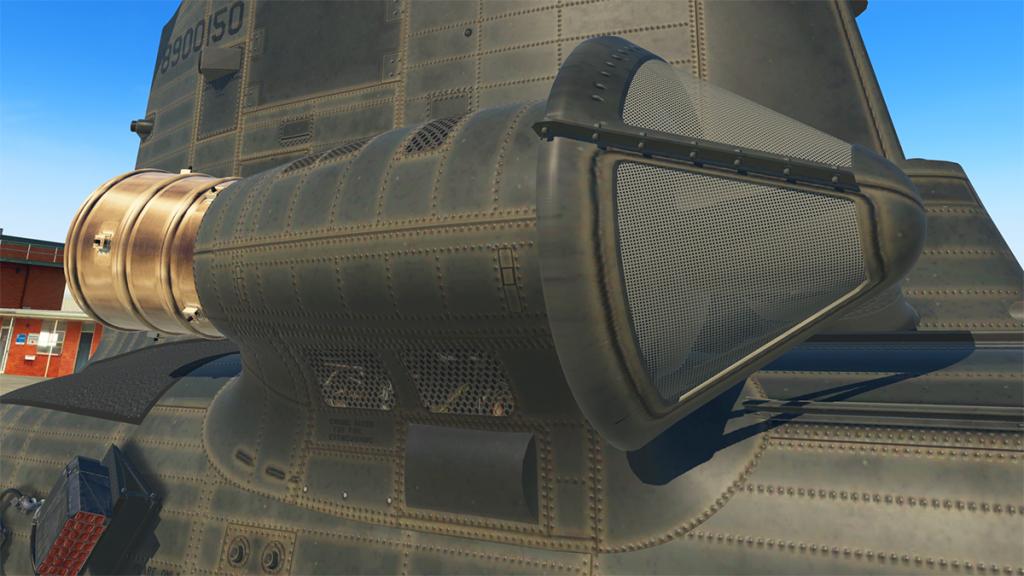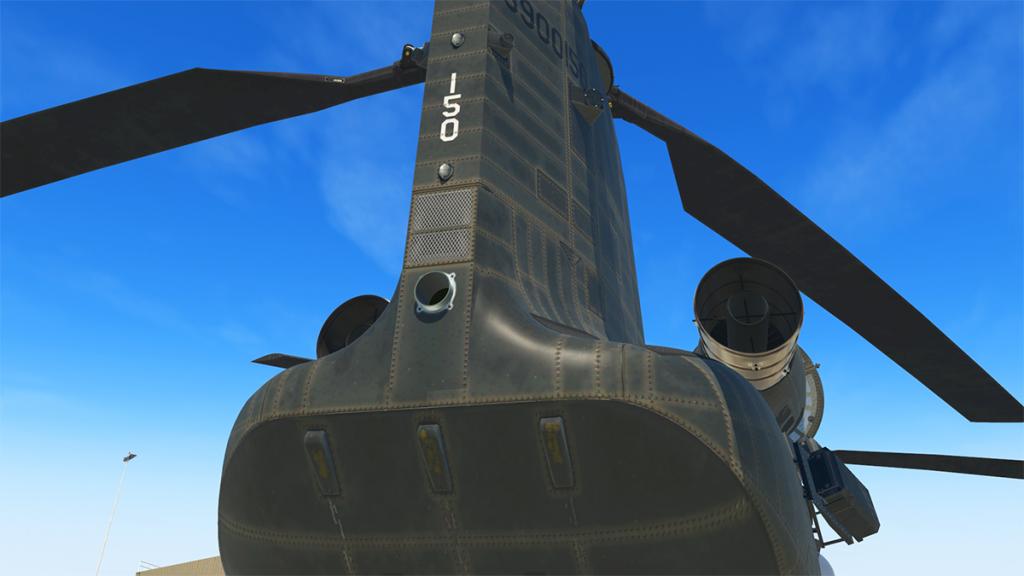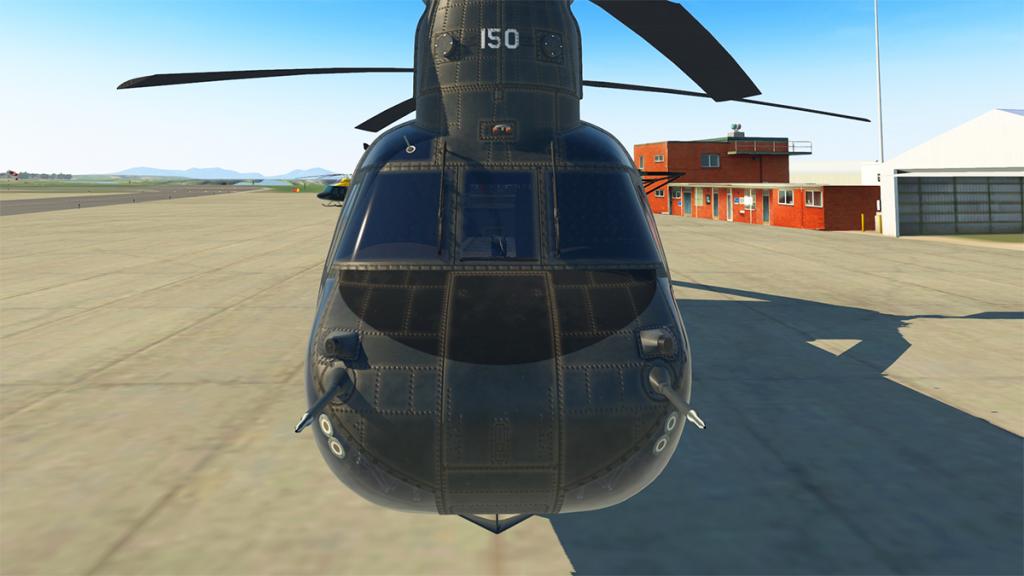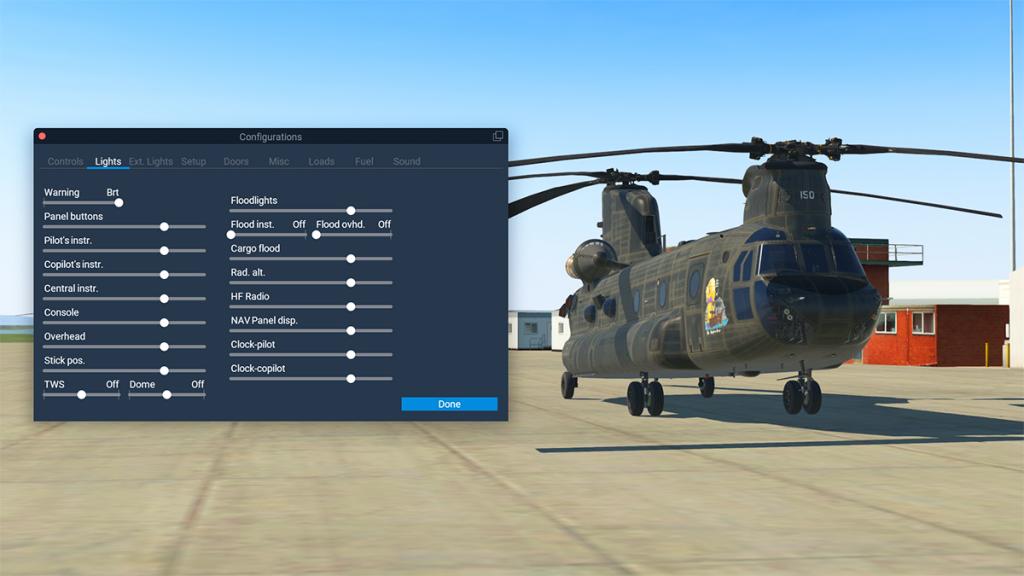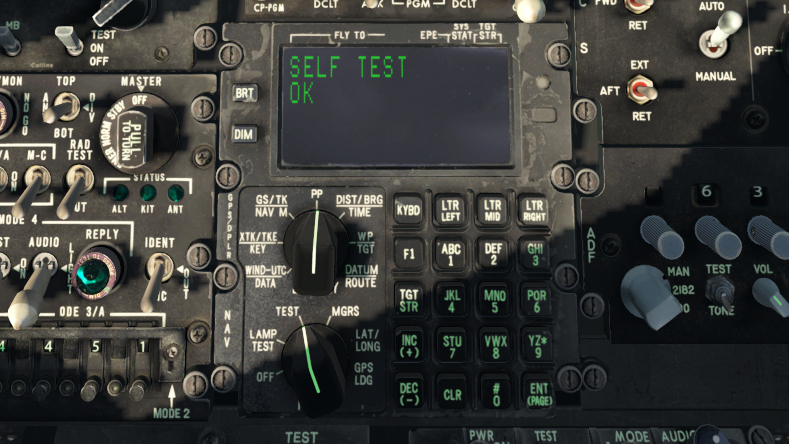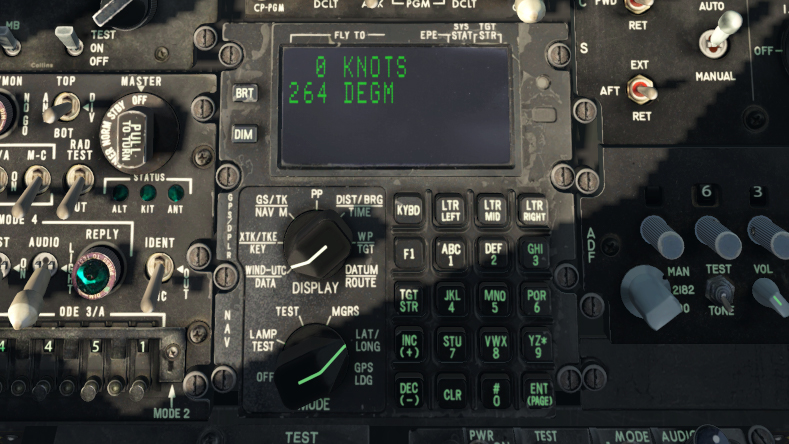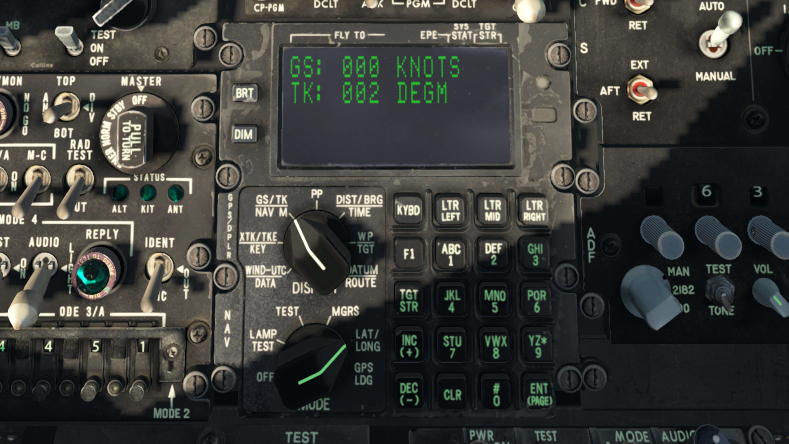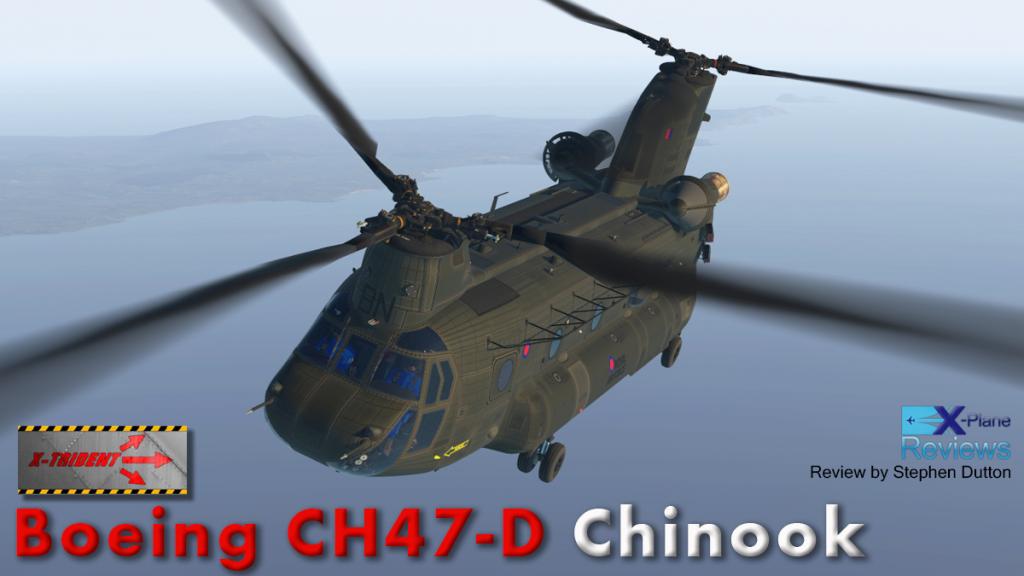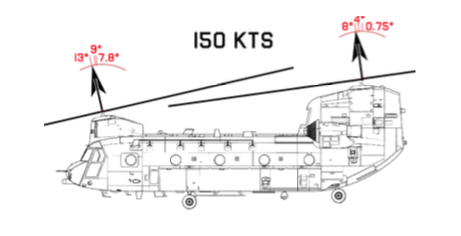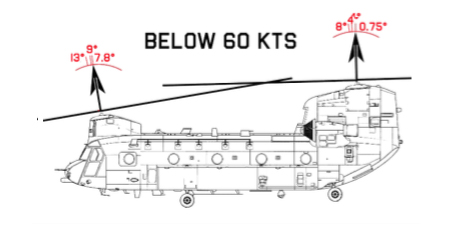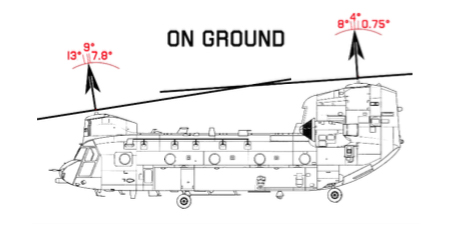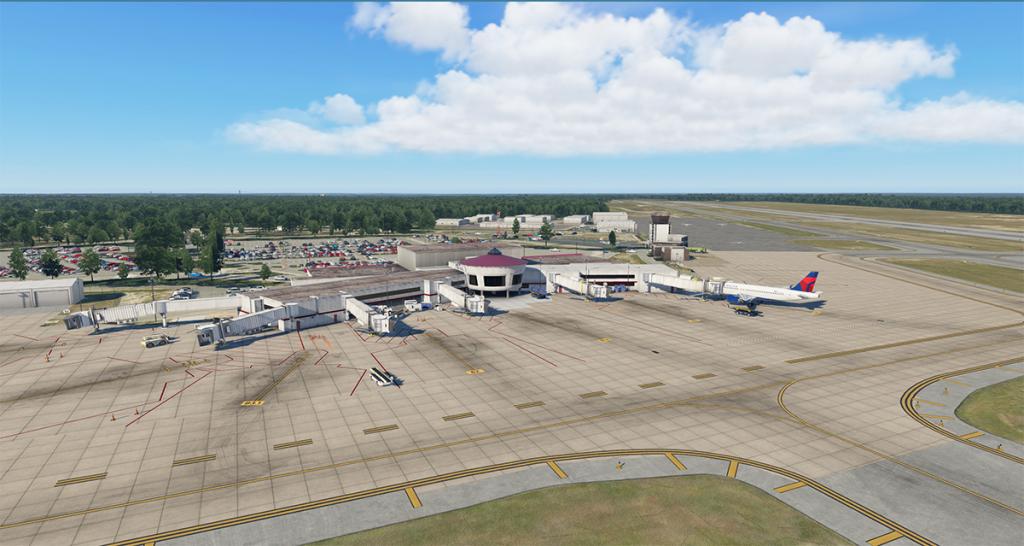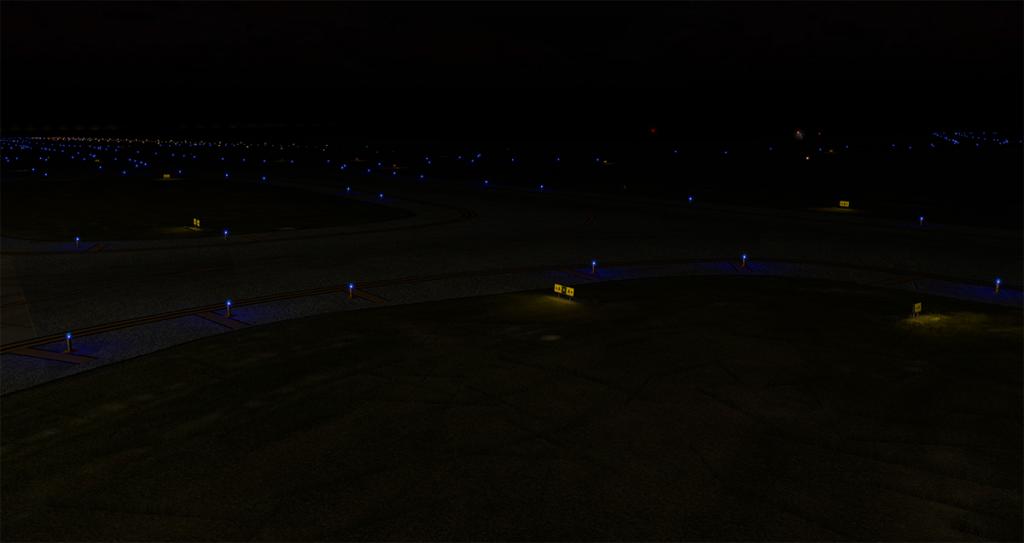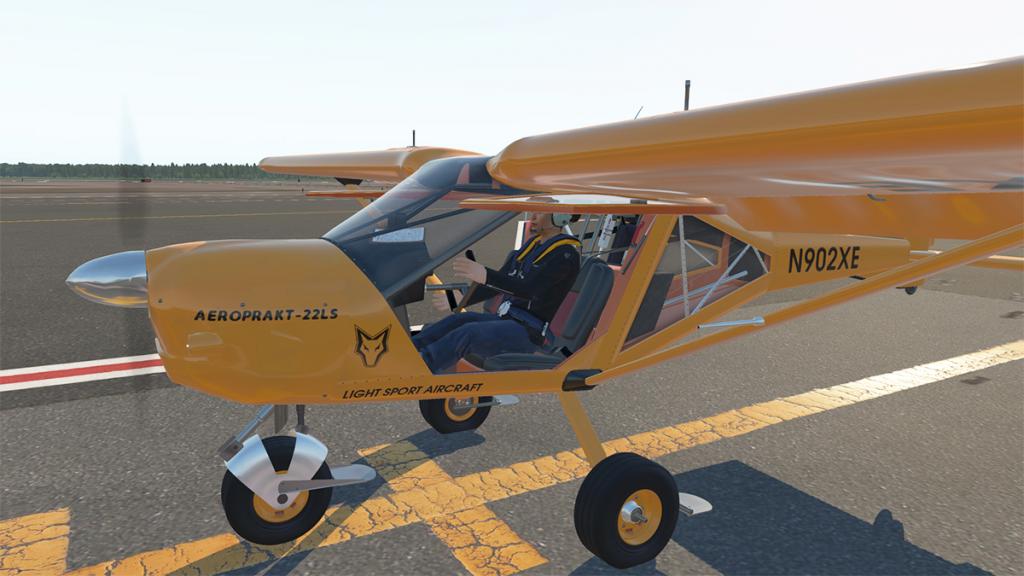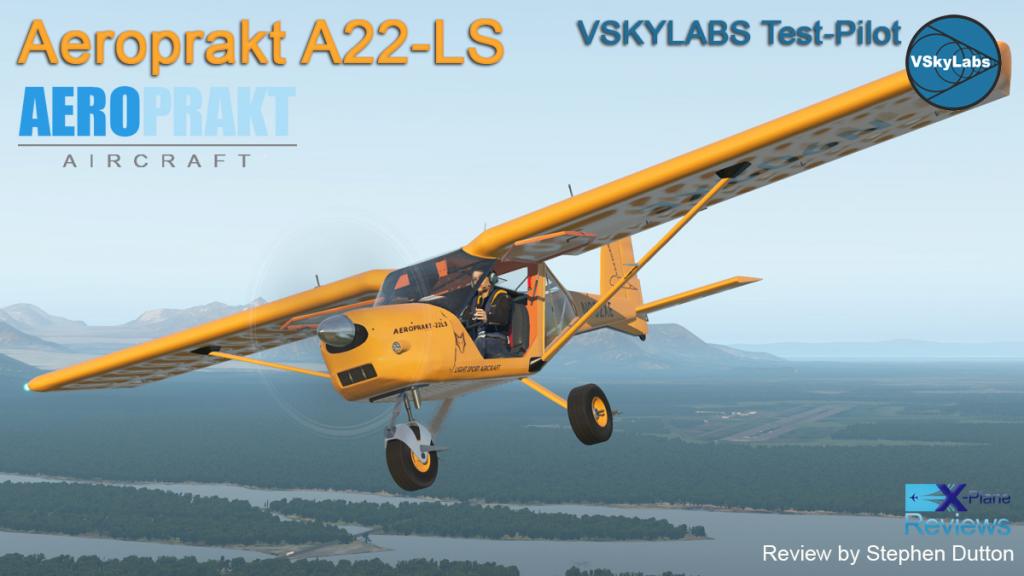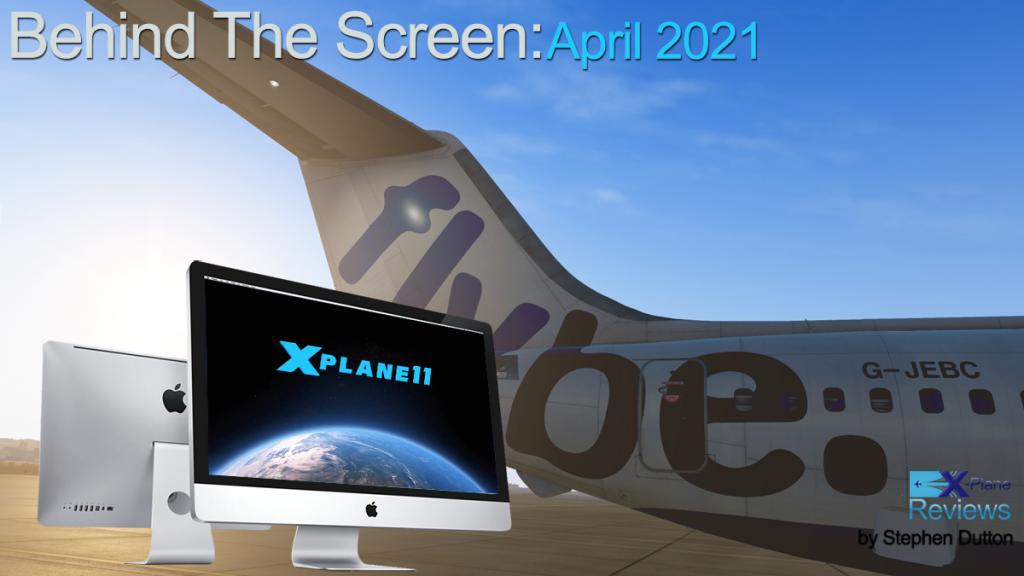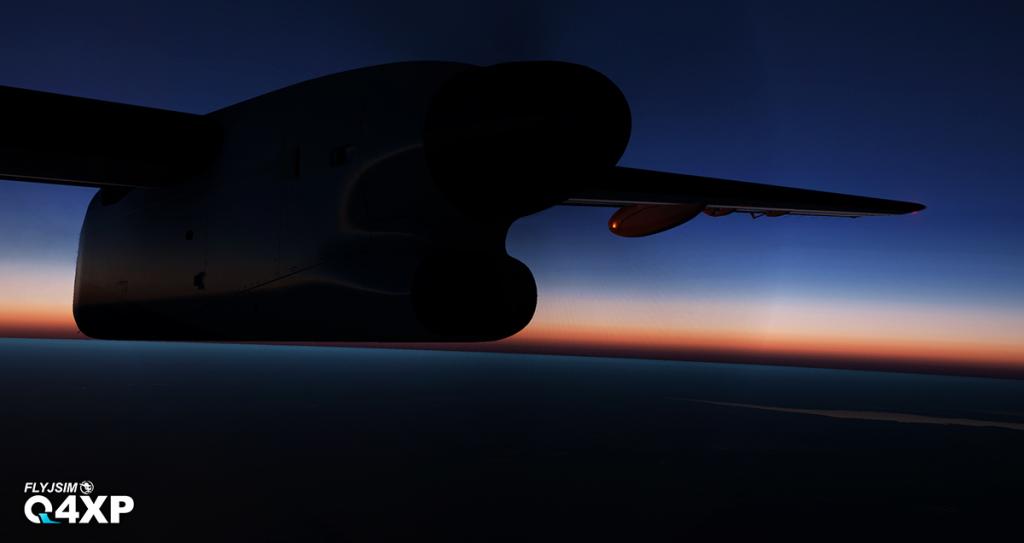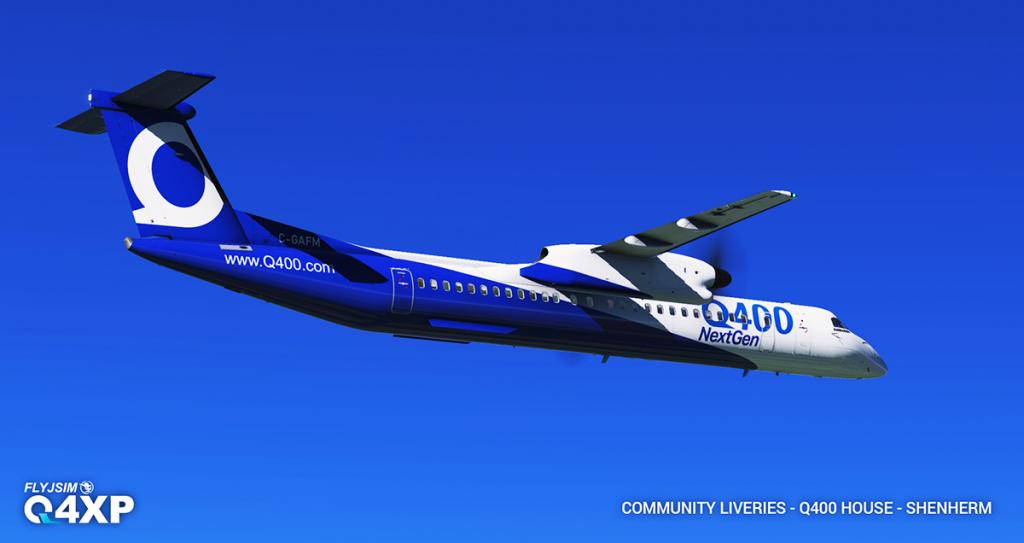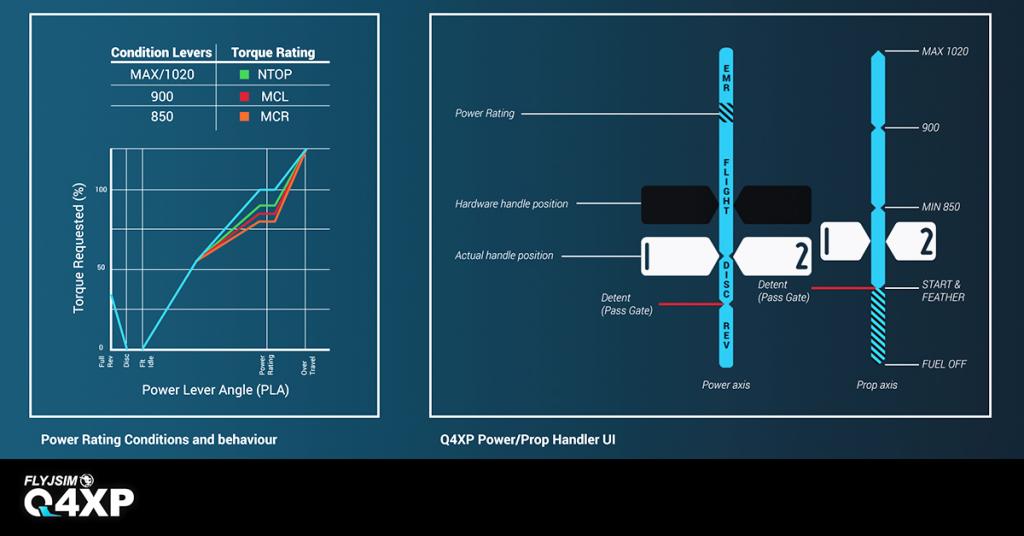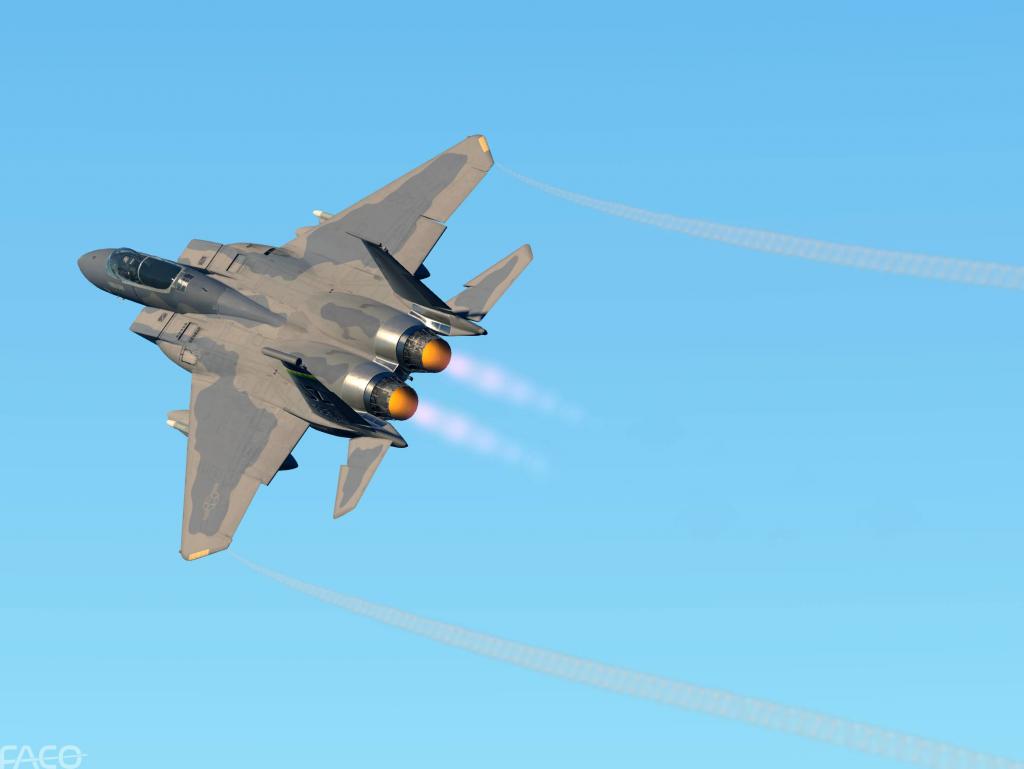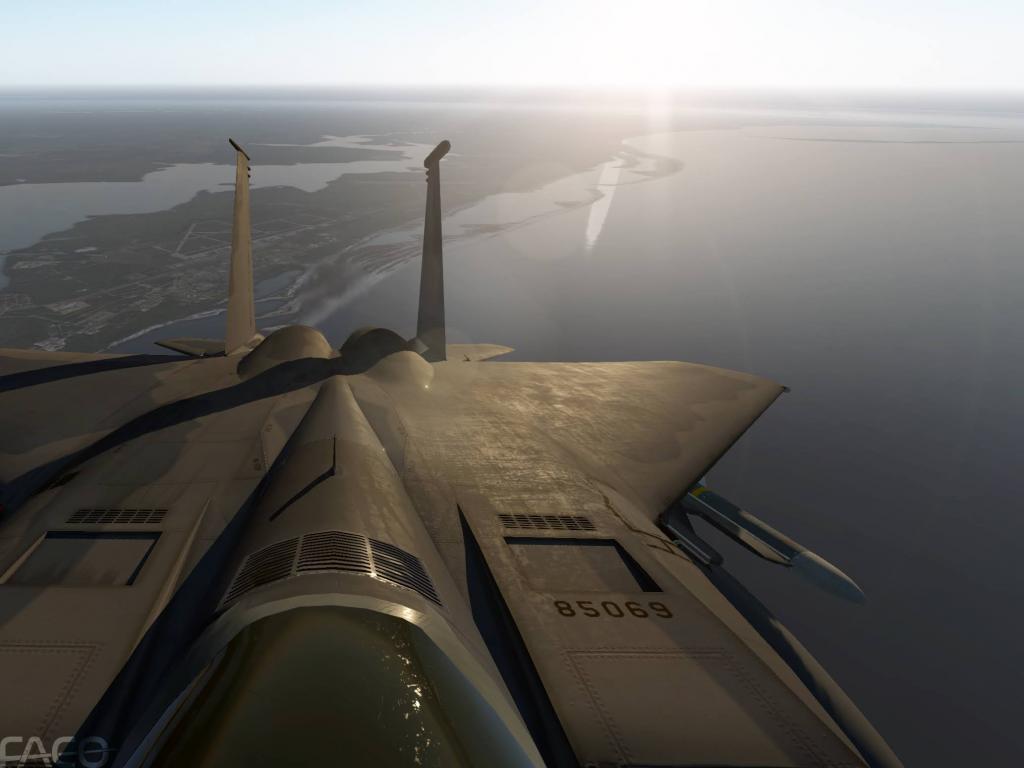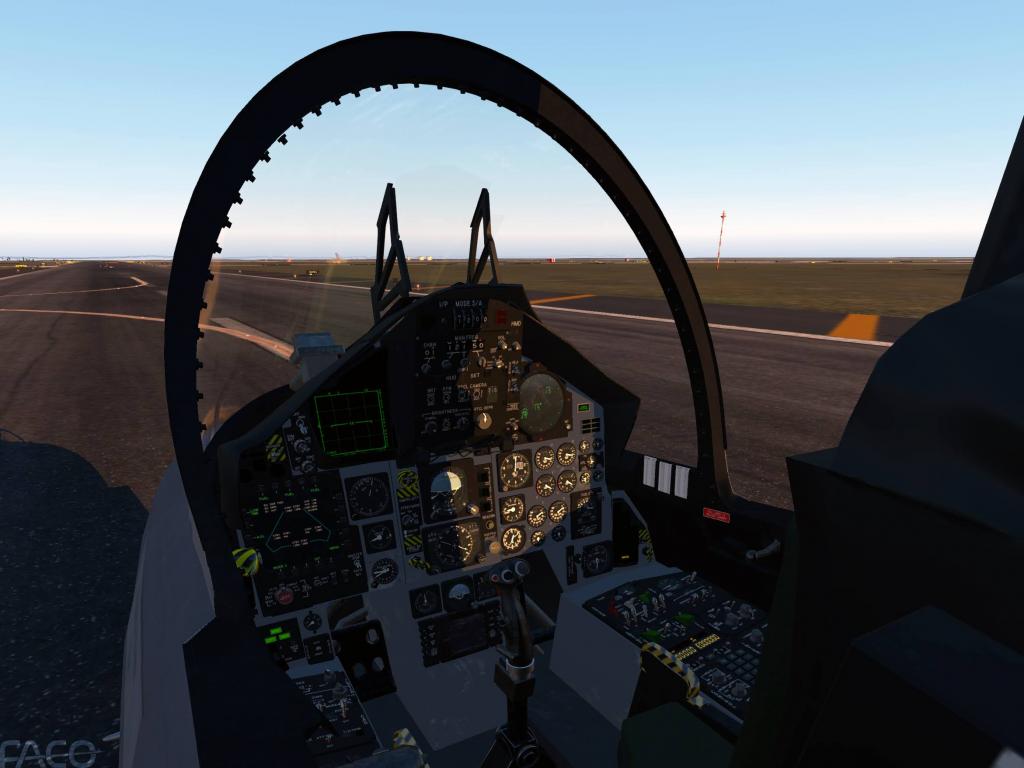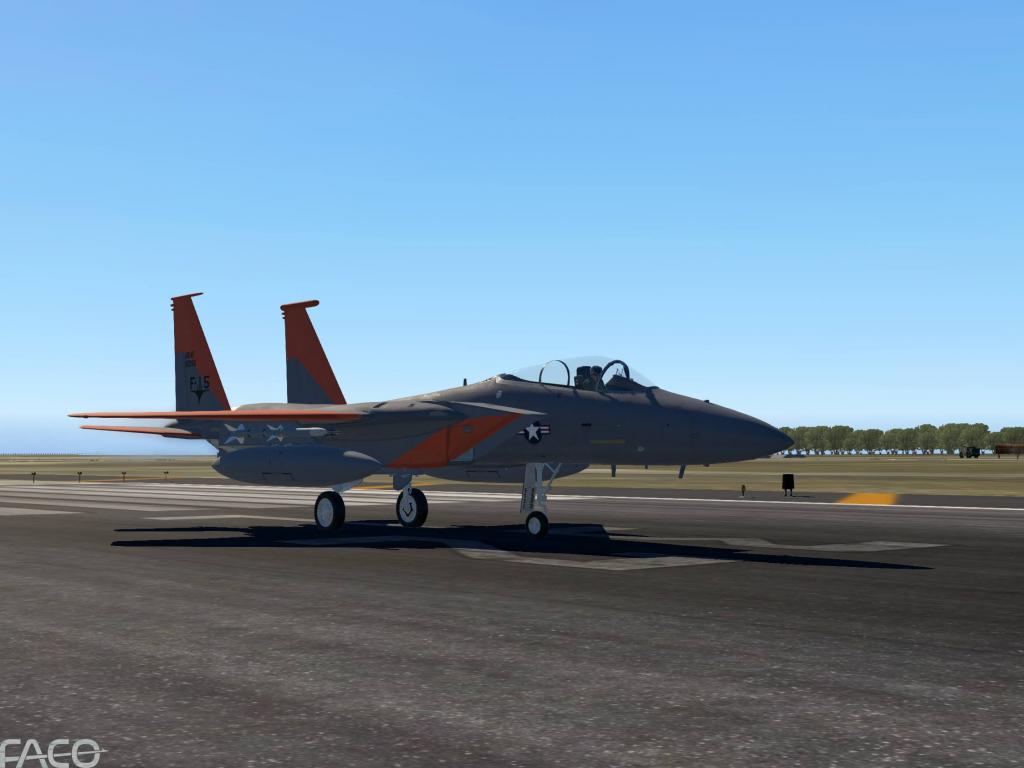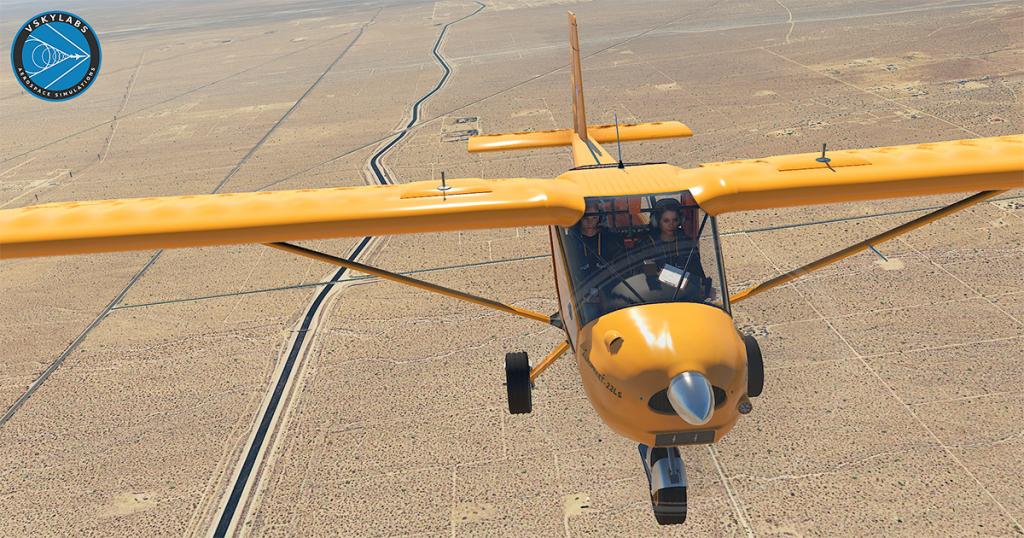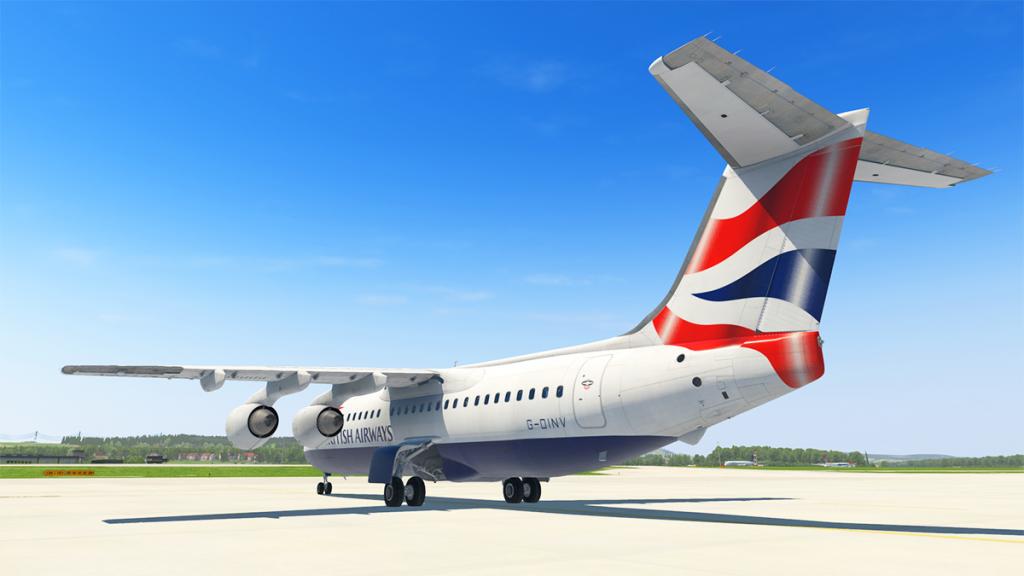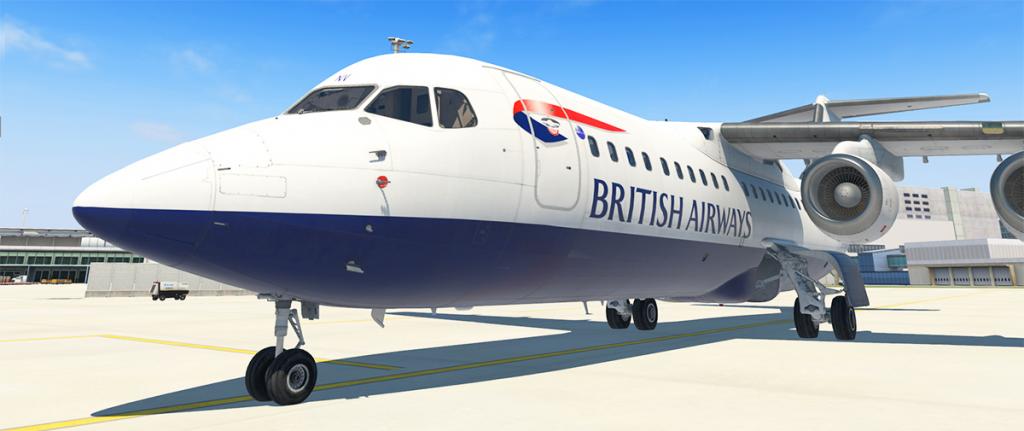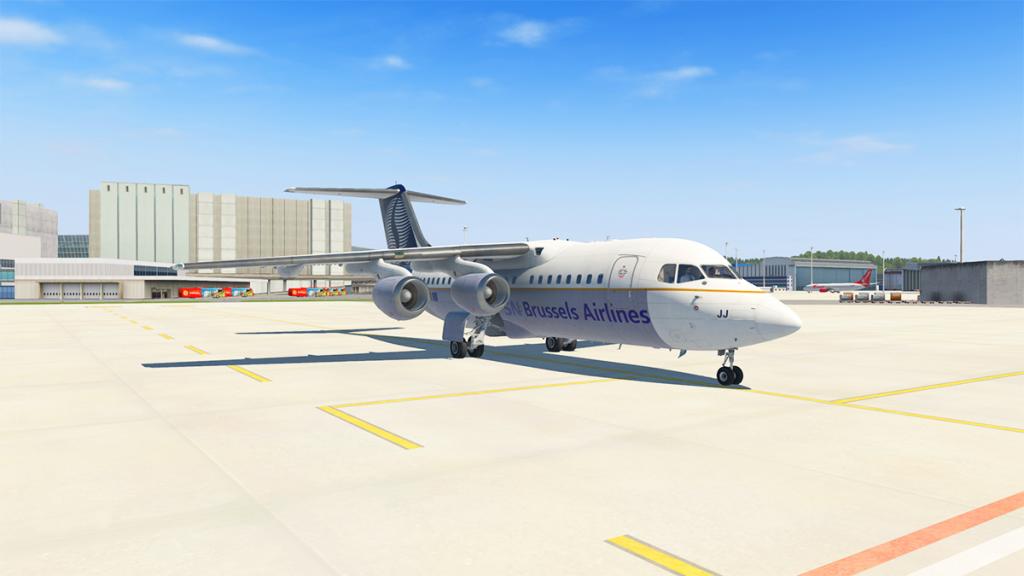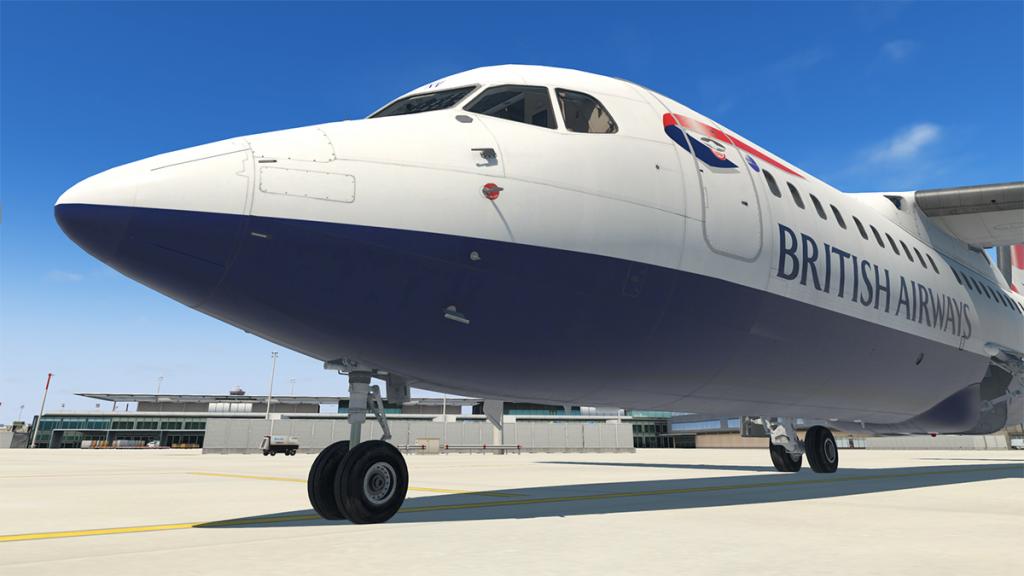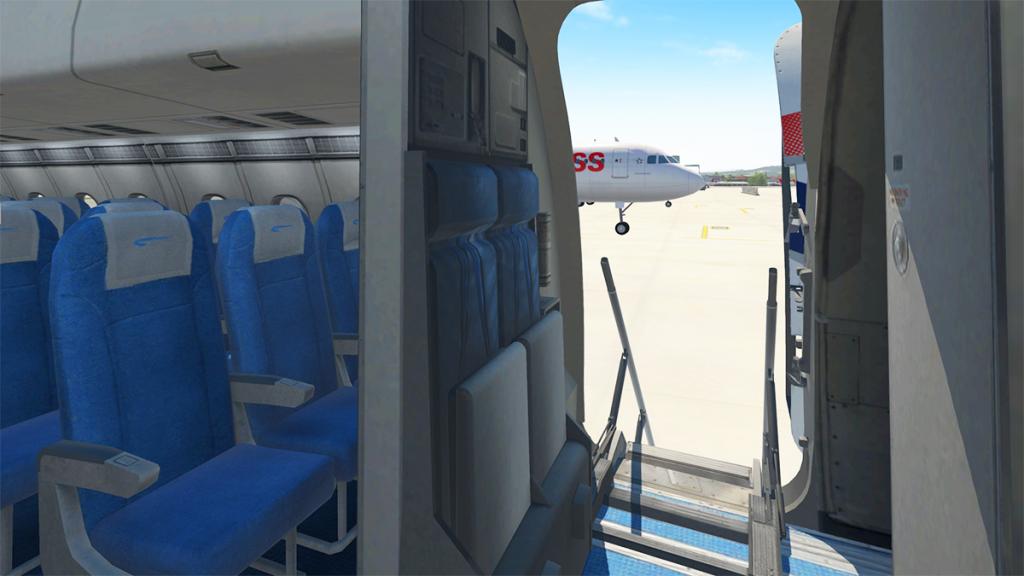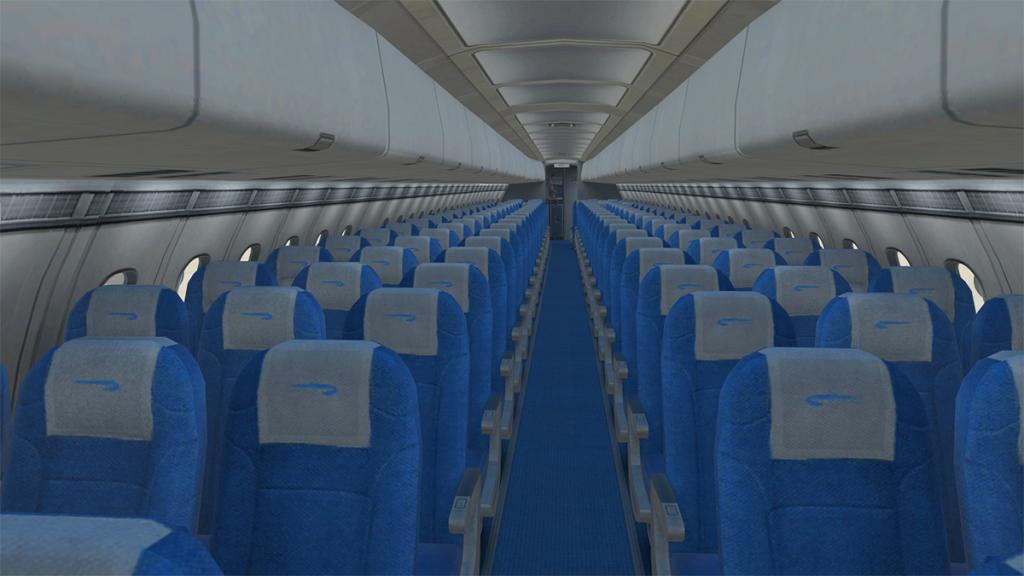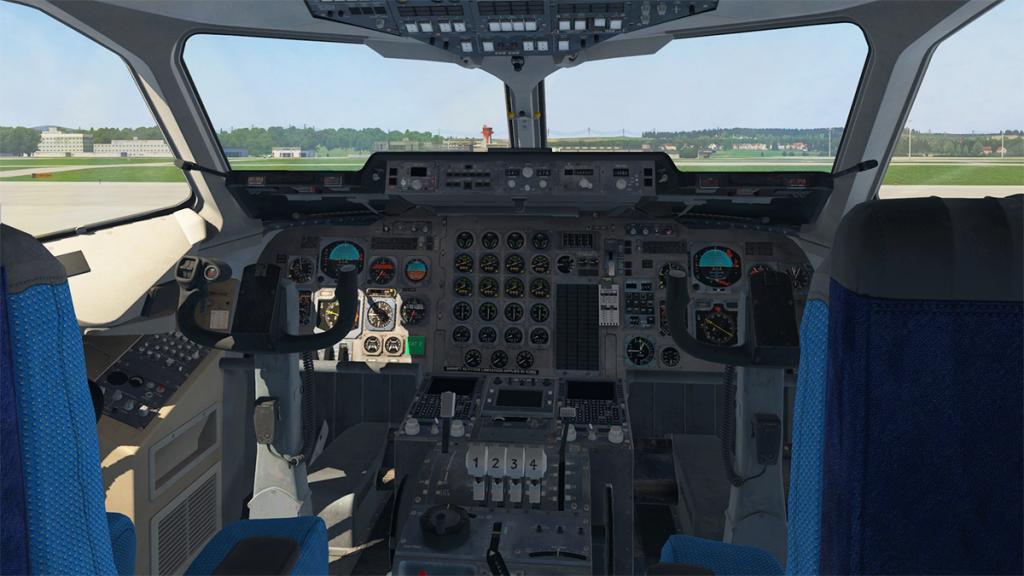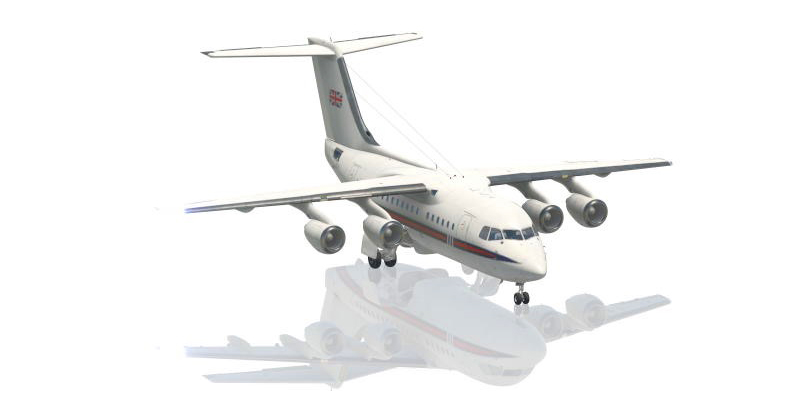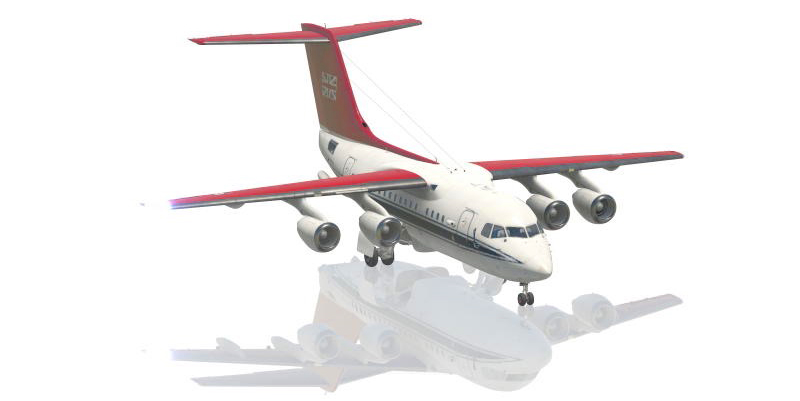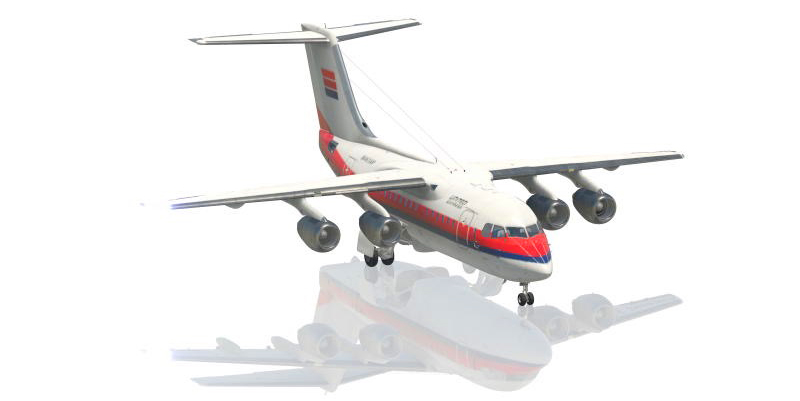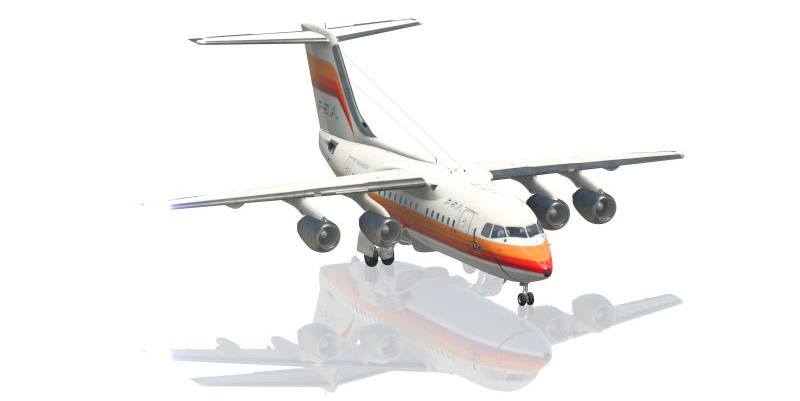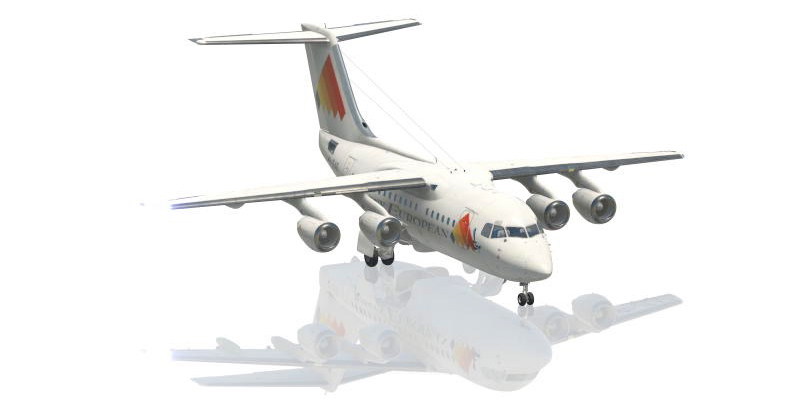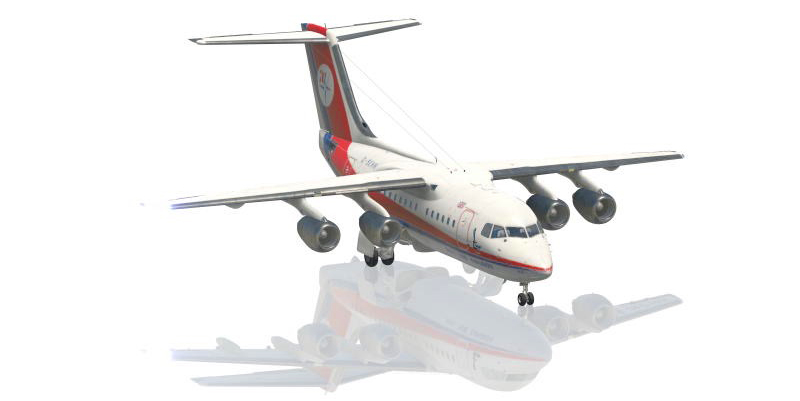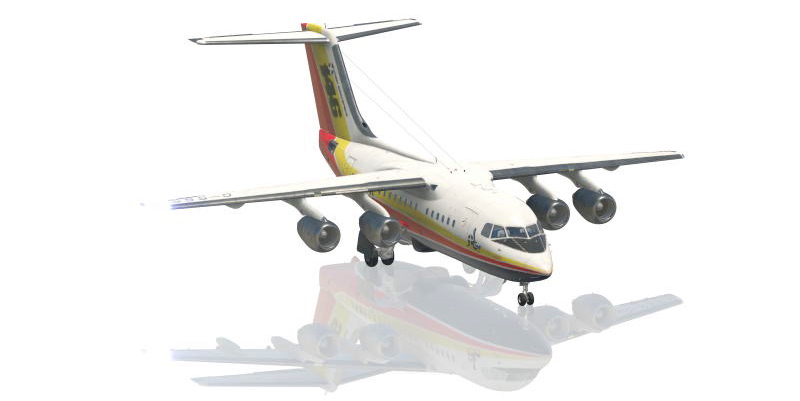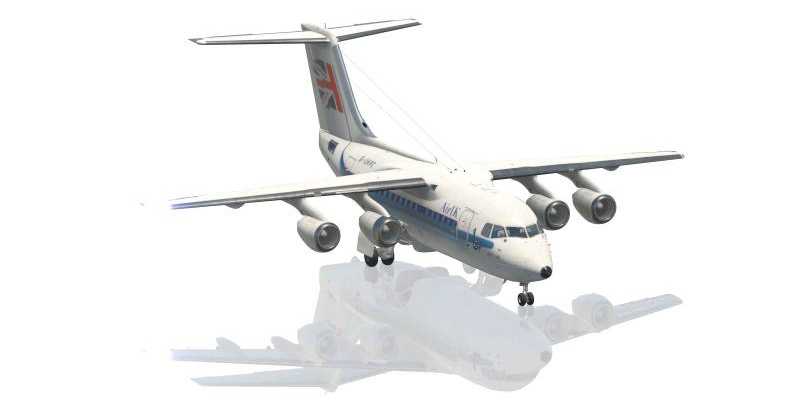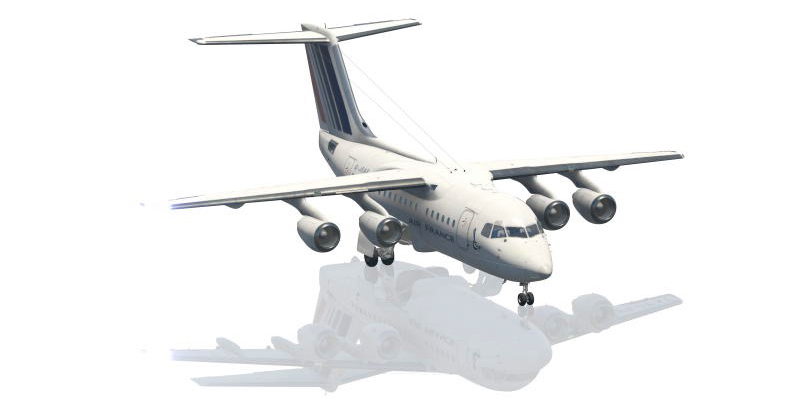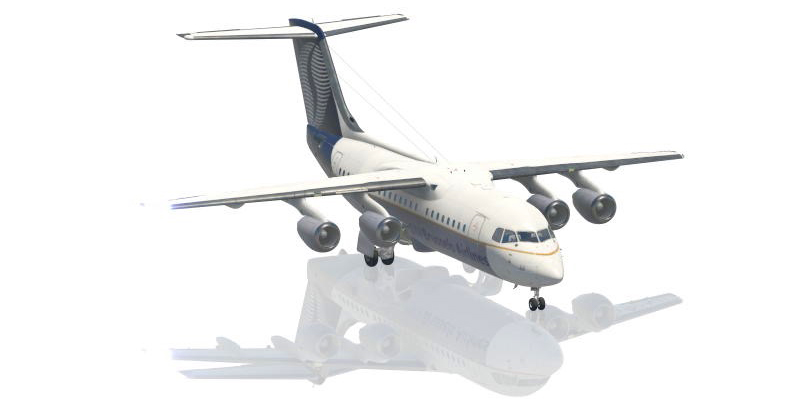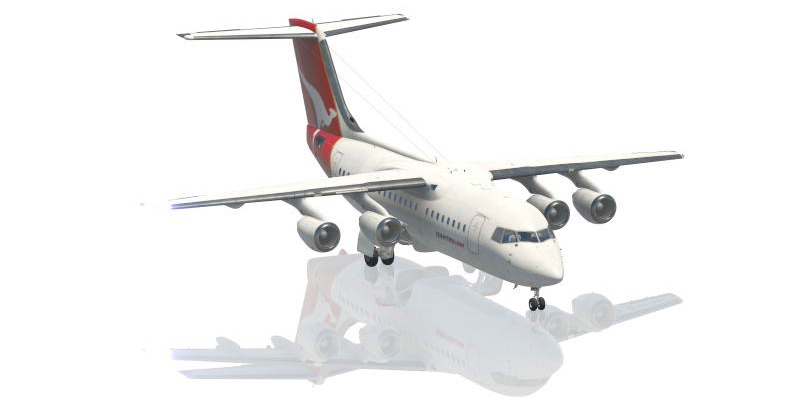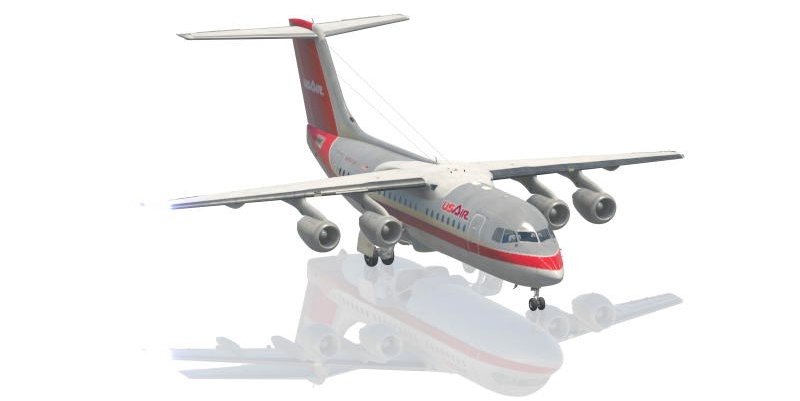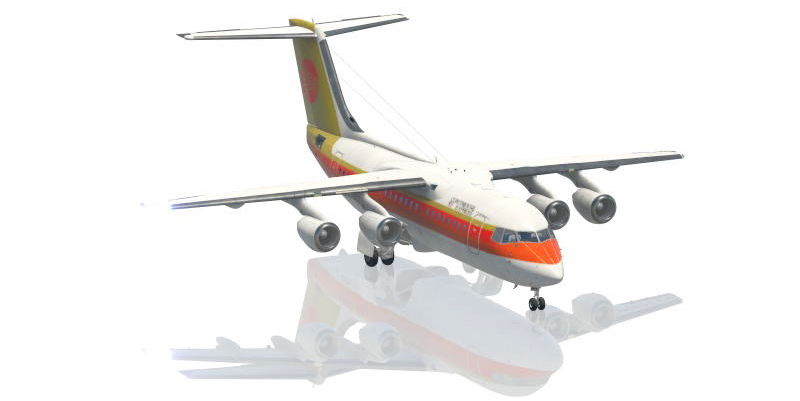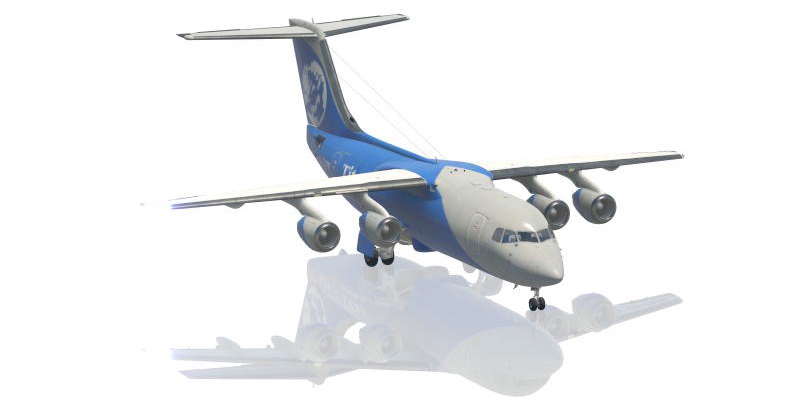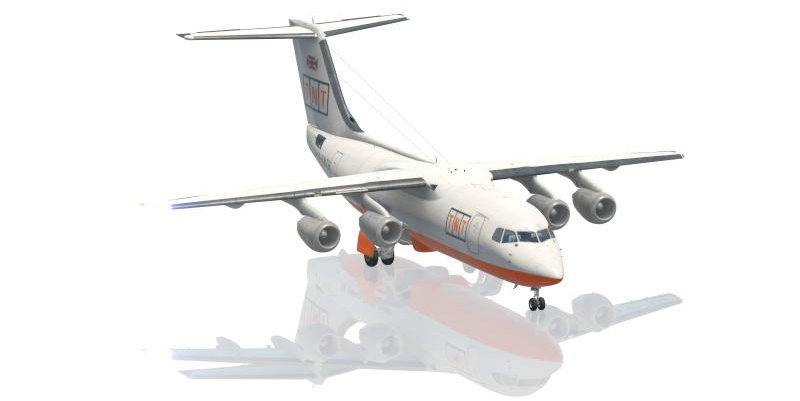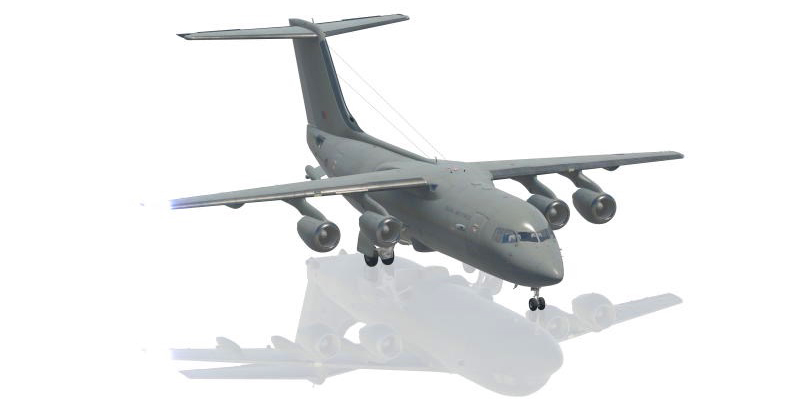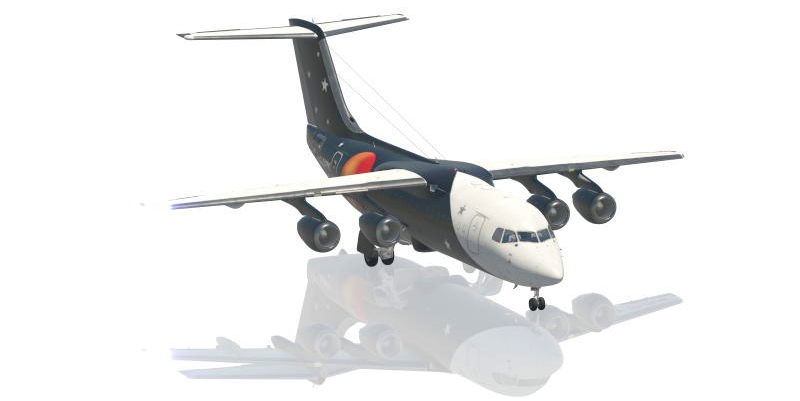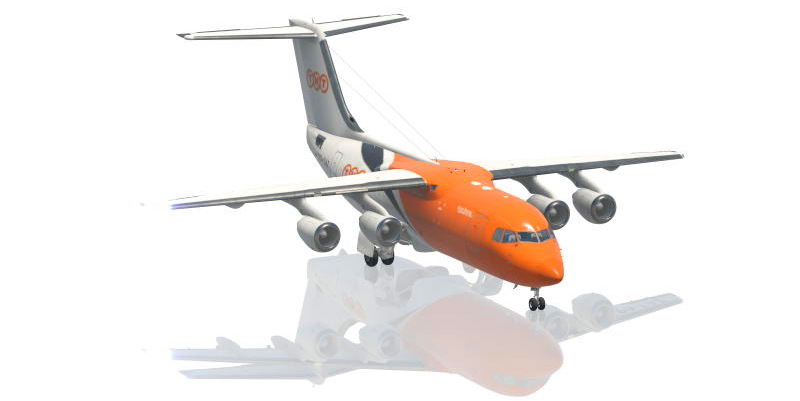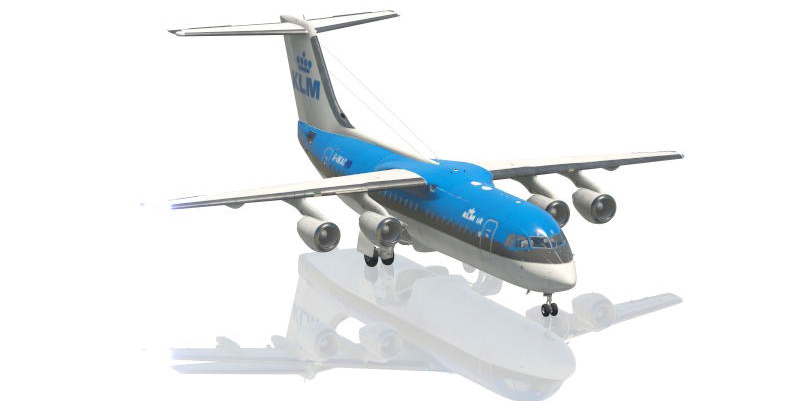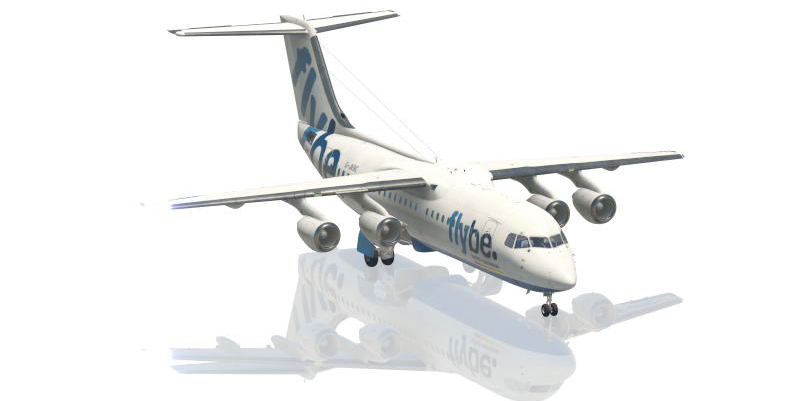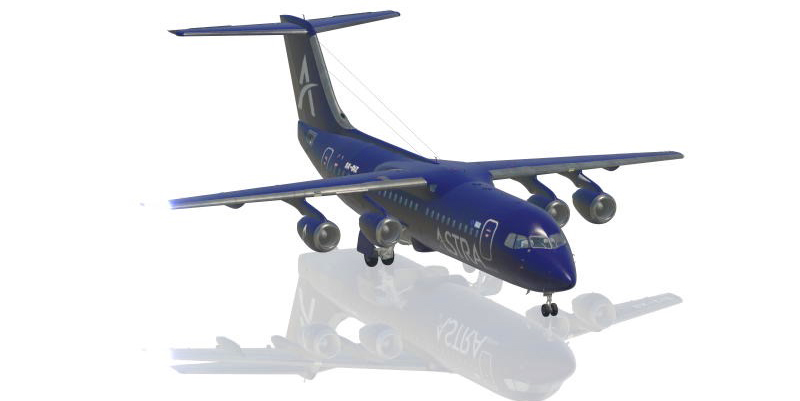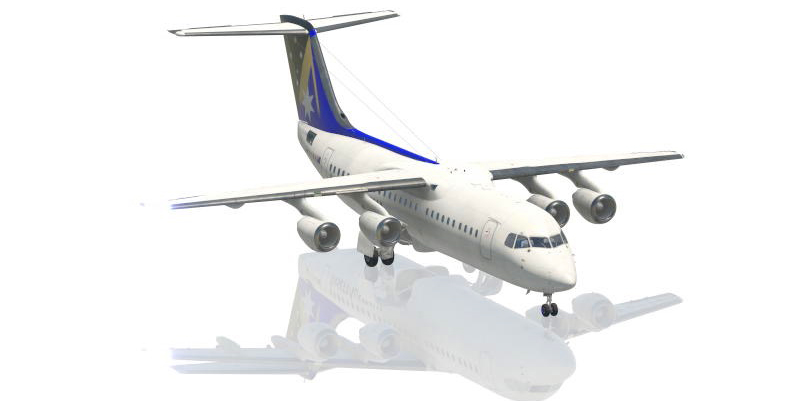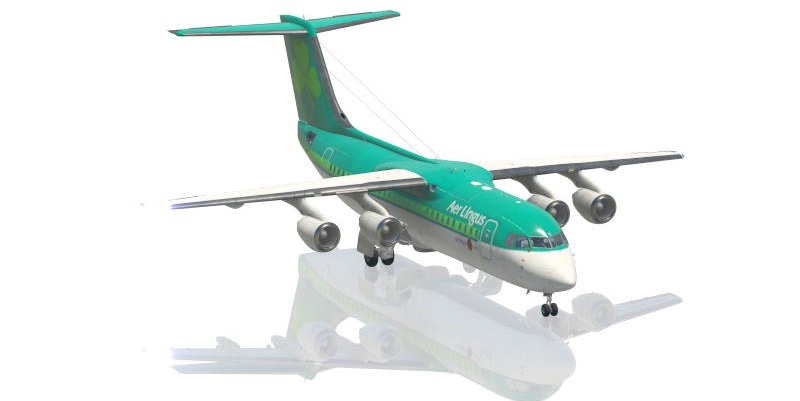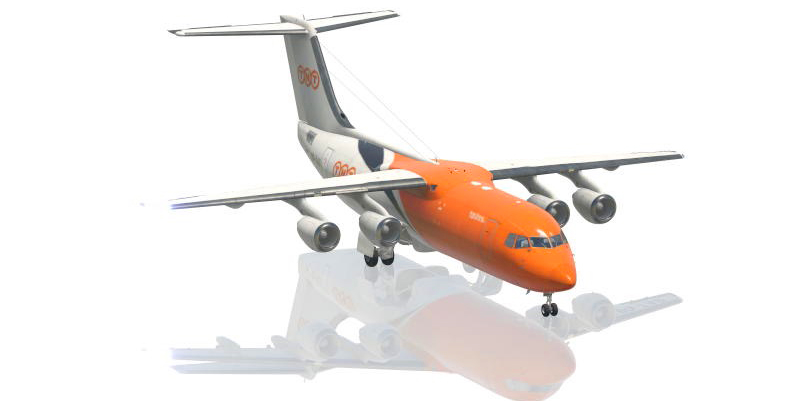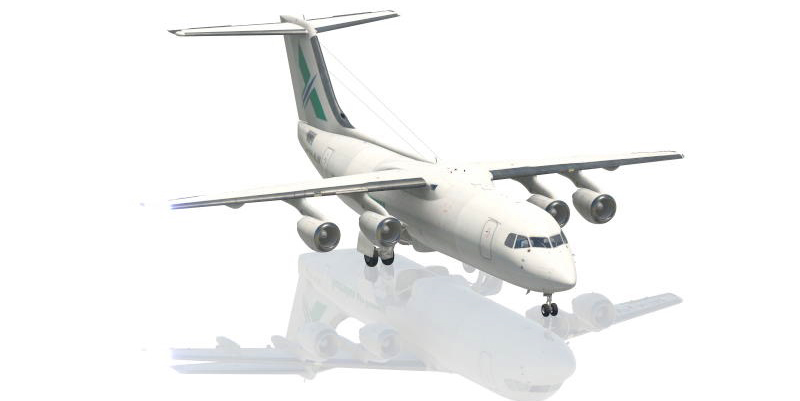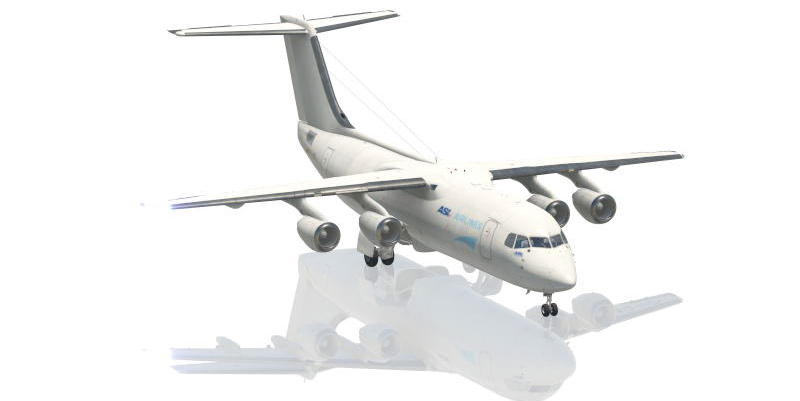-
Posts
2734 -
Joined
-
Last visited
-
Days Won
355
Content Type
Profiles
Forums
Articles
Everything posted by Stephen
-
News! - Released : Enhanced Flight Models by Xaero Updates to X-Plane default aircraft are getting even more and more far apart. There might be the odd nip and touch here and there, but unbelievable is the fact that many of the current default aircraft don't even comply to the current "Experimental Flight Model" is showing up Laminar Research and their poor updating efforts lately... the last was 11.50 Q3 last year. Xaero have stepped in to the breach, by releasing "Enhanced Flight Model" packages to fill in the current gaps. To date there has been two package releases, in one for the Beechcraft B58, and another for the Beechcraft C90B King Air, both aircraft are free with the X-Plane Simulator. The Enhanced Flight Model (known as EFM), is a set of new flight dynamics for the stock B58 Baron/C90 King Air... For the B58 the enhancements include: Cruise speeds accurate across all altitudes and power settings. Accurate maximum speeds. Accurate stall speeds, flap up or down. Correct rates of climb. Accurate take-off and landing distances. Accurate feel and handling. Accurate fuel consumption at all altitudes and power settings (if properly leaned!). And areas corrected from the stock models are; Aircraft cannot maintain level flight or climb at high weights on a single engine. Lower than realistic rate of climb on both engines. Take-off distance too long by approximately 30%. Landing distance too short by approximately 30%. Excessive fuel consumption in most cases. Stall speed with flaps extended 9kts too high. Slightly low L/D (aerodynamic efficiency) resulting in poor performance at low speed. General instability, especially in the yaw axis. For the C90B King Air the enhancements include: Utilizes the existing King Air C90 graphics and sounds included with X-plane 11 by Laminar Research. Cruise speeds accurate across all altitudes and power settings. Accurate stall speeds, flap up or down. Correct rates of climb. Correct glide ratio. Accurate single-engine performance. Accurate take-off and landing distances. Accurate ‘feel’ and handling. Accurate fuel consumption at all altitudes and power settings (respect the torque redline!). And areas corrected from the stock models are; Engines not ‘de-rated’ to produce full-torque to over 10,000ft. Aircraft unable to achieve fast-cruise at high altitude due to insufficient engine torque. Take-off distance too long. Landing distance too short. Climb rate on a single engine 30% too low. Stall speed with flaps extended 12kts too high. Too-high L/D (aerodynamic efficiency) resulting in excessive glide performance. Aircraft too fast for given power settings (probably related to the previous point). And both packages in X-plane flight dynamics have evolved and improved considerably since the initial release of the last version of X-Plane (XP11), and so including these updated packages means of adding greater depth and realism to the aircraft's simulation. The complete B58 Baron EFM manual is available here: https://forums.x-plane.org/index.php?/forums/forum/295-x-aerodynamics/ The complete C90B King Air EFM manual is available here: https://forums.x-plane.org/index.php?/forums/forum/295-x-aerodynamics/ Both the B58 and C90B Advanced Flight Model packages are now available from the X-Plane.OrgStore __________________________ Yes! Enhanced Flight Models by Xaero are available from the X-Plane.Org Store here : Beechcraft B58 Enhanced Flight Model Current Price is US$19.95 (Retail Price:$24.95) Requirements X-Plane 11 Linux, Mac, and Windows 4 GB VRAM Minimum - 8GB+ VRAM Recommended Current version : 1.0 (May 25th 2021) ___________________________ Beechcraft C90B King Air Current Price is US$19.95 (Retail Price:$24.95) Requirements X-Plane 11 Linux, Mac, and Windows 4 GB VRAM Minimum - 8GB+ VRAM Recommended Current version : 1.0 (May 25th 2021) Notes: Compatibility with other mods: All liveries and graphical enhancements for the stock B58/C90B should be fine. However, any mod that modifies the aircraft file (.acf) or airfoils is not compatible with the EFM upgrade, sorry. Any mod that add plugins may adversely affect performance if the plugin interferes with the flight model at all. The stock B58/C90B is still available to use after EFM installation, so many mods applied to that should be fully functional and unchanged. ___________________________ News by Stephen Dutton 1st June 2021 Copyright©2021: X-Plane Reviews (Disclaimer. All images and text in this review are the work and property of X-PlaneReviews, no sharing or copy of the content is allowed without consent from the author as per copyright conditions) All Rights Reserved b58_efm_cruisecharts.webp b58_efm_cruisecharts.webp
-
X-PlaneReviews : Away on a break With two mega reviews done and a bit of nice weather, it is time to have a small (rest) break. X-PlaneReviews will not be updated from Wednesday 26th May 2021 to the Tuesday 1st June 2021. See you all very soon Stephen Dutton X-PlaneReviews
-
News! - Aircraft Update : JustFlight updates the BAe146 v1.1.1 It is just the teeny-weenyest of updates, just a few... but v1.1.1 shows that JustFlight (Thranda) are still pursuing the smallest of issues and in wanting to get their BAe146 just about perfect. Changelog v1.1.1 - Beacon flashing pattern made more realistic - OAT gauge now always indicated in degrees C - Fixed geometry aft of weather radar - Improved ASI knob usability (supports click-and-hold) - Increased volume of altitude alert callouts - Added aircraft ICAO code - Pop-up window VR compatibility improved - Fixed engine overspeed annunciator light so that it doesn't get stuck after testing A great simulation the British Aerospace 146 is, but it is a demanding simulation that requires a lot of flightdeck work to get the perfect gate or stand to stand experience out there. Still learning and practising, the aircraft is now coming to me, but boy, get it right and the simulation is excellent. This test flight was from EDDL (Düsseldorf) to EKCH (Copenhagen). The aircraft's ICAO code has (finally) been fixed, a small but annoying issue in that elements wouldn't see the the aircraft, like the GHD or Ground Handling Deluxe and animated gates. Both the latest updates have had a lot of attention on altitude and height callouts, so you can now hear them. OAT gauge now indicates in degrees C, and the VR (Virtual Reality) aspect has also had some refinements. All small but significant adjustments. But sadly there is still no sign of the coming custom FMS noted as the Universal Avionics UNS-1E avionics suite... When it comes to hours on an airframe, for me it has been the IXEG Boeing 737 Classic that has provided the most, and the longest test of my learning skills and patience. Fair enough, but the IXEG demands you learn and fly the aircraft with the uttermost skill set, not only at the controls, but also with the systems and complicated avionics. My feel is that this JF BAe146 is next so called deep dive and learn aircraft. It will take time, even years to perfect (like the IXEG) to get the procedures perfectly correct, know every system and to perfect that stand to stand simulation. A notable fix not noted in the changelogs is the internal views in the Replay mode has been fixed!... yeah! Version to v1.1.1 is available through the SkunkCrafts updater which is installed in your X-Plane/Resources/Plugin folder. To update make sure you don't have the BAe146 aircraft selected and select in the Skunkcrafts updater the "JF_BAe_146 selection", then press the "Updater or repair addon" selection. You can of course download the update from the X-Plane.OrgStore or directly from your JustFlight account. The British Aerospace 146 Professional v1.1.1 by JustFlight is also available from the X-Plane.OrgStore, so now get this excellent updated machine, from the main X-Plane store with it's great service and for a LIMITED-TIME SPECIAL OFFER : Get Triple Reward Points when you purchase this Aircraft. 225 Points ___________________ Yes! the British Aerospace 146 Professional by JustFlight is now available from the X-Plane.Org Store here : BAe146 Professional - JustFlight Price is US$74.99 Features Include: Highlights Eight variants of the 146 are included: - 146-100 - 146-200 - 146-300 - 146-200 QC & QT (cargo) - 146-300 QT (cargo) - CC.Mk2 (RAF VIP configuration with countermeasure pods) - C.Mk3 (RAF cargo configuration with countermeasure pods) Accurately modelled using real-world aircraft plans and comprehensive photography of the real aircraft (G-JEAO, ZE701 and ZE708) Numerous animations including: - Trailing edge flap surfaces - Wing-mounted spoilers and tail-mounted airbrake - Ailerons and elevators feature servo tabs, and balanced, free-floating control surfaces which are affected not only by oncoming air, but also by turbulence, side winds, up and down drafts etc. during taxi or low-speed ground operations - All passenger, service and cargo doors use custom animations and featurr extra logic such as the auto-closure of doors above a certain speed - Windscreen wipers with individual left/right animations and independent speed controls - Distinctive retractable tricycle landing gear featuring complex trailing link shock-absorbing mechanism on the main gear - Countermeasure pods, HF aerial and more Cockpit A truly 3D cockpit environment right down to accurately modelled seat belts and screw heads Cockpit textures feature wear and tear based on reference photos taken in the real aircraft to produce an authentic environment Captain, Co-pilot and jump-seat positions are modelled with hundreds of functional controls, including over 200 buttons, 100 switches and knobs, with smooth animations, easy-to-use clickspots and precision sounds Fully VR compatible Aircraft configuration system that will allow you to choose between 'cold & dark' or 'engines running’. These configurations can be customised via the Manifest.json file. Custom throttle lever logic – fuel latch logic which is compatible with hardware (avoiding jitters due to conflicting throttle positions), cutomisable variation in throttle positions for added realism, clickspot for controlling all four levers simultaneously etc. Functional crank handles on knobs such as the altitude select and rudder trim, which allow for more intuitive, realistic and quicker operation Full support for command assignments, hardware and cockpit builders: - All controls can be assigned to commands, with tooltips on every clickspot to indicate which command to use - Parameters such as smoothing animation, number of positions, attached dataref, push-button depth, knob rotation multiplier, frame-skip (for optimisation), default position etc. can all be customised via the Manifest.json file, providing great support for hardware and cockpit builders. - Default commands for landing and taxi lights, windsscreen wipers, panel lights etc. are still respected, despite being implemented with custom functionality Custom features such as ‘hide yokes’ are controllable using default commands (e.g. 'Hide Yoke') as well as via clickspots EFB tablet with door and call-out controls and with AviTab support Sounds Studio quality Lycoming ALF-502 engine sounds, recorded from RAF C.Mk3 ZE708 Over 450 flight deck sound effects recorded from RAF CC.Mk2 ZE701 Detailed audio equipment such as the APU, brake fans, electrical circuits, hydraulic equipment and much more Distinctive flap retraction/extension airflow 'howling' sound More than 520 sounds samples in high definition with accurate 3D placement. Pushing the limits of FMOD 1.08 sound system with more than 150 sound tracks being played at the same time with no virtualisation. Full 7.1 surround sound support via FMOD, with 3D positional sound for VR users Extremely detailed external sound system: - Takes into account distance, speed, altitude, temperature and air pressure, just like in real life - Accurate touchdown sound based on impact speed - Multi-directional sound during fly-by and camera location on external view - Realistic runway roll sounds, complete with periodic bumps that depend on lateral runway position - Realistic wind sound that reacts not only to the speed of the aircraft but also how the wind is interacting with the fuselage (AoA, side slip etc.) - Realistic ambient sounds which replaces the default X-Plane sounds with a high fidelity FMOD sound system recreating the atmospheric effect, such as rain, birds, thunder etc. Interior and cabin sounds: - Passenger sounds, based on aircraft weight, which react according to your flying style. Passenger cabin sound changes as you move around, as if you were inside the real plane. Lighting Full HDR lighting with gimballed lights that can be aimed and dynamically illuminate whichever part of the cockpit is aimed at Independent lighting controls for Captain and First Officer Dimmable integral lighting for each panel, accurately dependent on corresponding electrical bus Dimmable dynamic flood and storm lighting for a highly immersive and customisable night environment (more than 12 individual light sources including entry, lap, sill and flight kit) White and red flashlight for night operations Accurately simulated exterior lighting including dynamic wing, logo and runway exit lights, and taxi/landing and navigation lights with different intensities Strobe lights with customisable strobe flashing pattern All exterior lights, including navigation, strobe, ice, exit, logo, landing, taxi and beacon lights are fully HDR with dynamic spill light, illuminating ground and scenery objects, as well as the aircraft itself. Other Features Comprehensive manual with tutorial, FMC guide, procedures, limitations and handling notes Payload manager for realistic fuel and passenger loads AviTab (third party tablet plugin) compatibleGoodway compatible Multiple interior and exterior viewpoint presets PSD paint kits included (free separate download) so you can create your own paint schemes You can take a look at the full detailed PDF manual here! Requirements X-Plane 11 Windows, Mac or Linux 4 GB VRAM Minimum - 8 GB VRAM Recommended Current Version: 1.1.1 (May 24th 2021) Download Size: 3.6 GB ________________________________________ News! Update by Stephen Dutton 25th May 2021 Copyright©2021: X-Plane Reviews Disclaimer. All images and text in this review are the work and property of X-PlaneReviews, no sharing or copy of the content is allowed without consent from the author as per copyright conditions) All Right Reserved
-
News! - Scenery Released : PATK - Talkeetna Airport, Alaska by NorthernSkyStudios NorthernSkyStudios really like Alaska. They have released two already excellent sceneries for this of most northern of American States with both PAEN-Kenai Municipal Airport and the most recently updated PAKT-Ketchikan International. This new NorthernSky Alaskan scenery is the only small PATK-Talkeetna Airport, but it is an essential lifeline to Denali, also known as Mount McKinley, the mountain's former official name, and it is the highest mountain peak in North America, with a summit elevation of 20,310 feet (6,190 m) above sea level. So the Denali area is a tourist mecca with loads of air services operating from the airport including Sheldon Air Services, Talkeetna Aero Services, K2 Aviation, and Talkeetna Air Taxi. Talkeetna Airport covers an area of 624 acres (253 ha) at an elevation of 358 feet (109 m) above mean sea level. Its one runway is designated 19/01 and has an asphalt pavement measuring 3,500 by 75 feet (1,067 x 23 m). It also has one helipad designated H1 with a gravel surface measuring 480 by 85 feet (146 x 26 m). Features: Highly detailed airport objects and vehicles Custom textured for taxiways, runways and apron Custom surroundings Shading and occlusion (texture baking) effects on all models High resolution ground textures / Custom runway textures High resolution building textures Excellent night effects Realistic reflections on glass World Traffic 3 compatible Compatible with: default XPL11 mesh HD Mesh v3 by AlpilotX Ortho4XP Small but still great value for the excellent detail at only US$9.95, it is another great destination for the use of a bush aircraft. Images are courtesy NorthernSkyStudios _____________________________________ Yes! PATK - Talkeetna Airport, Alaska by NorthernSkyStudios is available from the X-Plane.Org Store here : PATK - Talkeetna Airport, Alaska Price is US$9.95 Requirements X-Plane 11 Windows, Mac or Linux 4 GB VRAM Minimum - 8 GB+ VRAM Recommended Download Size: 530 MB Current version : 1.0 (May 23rd 2021) ___________________________ News by Stephen Dutton 24th May 2021 Copyright©2021: X-Plane Reviews (Disclaimer. All images and text in this review are the work and property of X-PlaneReviews, no sharing or copy of the content is allowed without consent from the author as per copyright conditions) All Rights Reserved
-
News! - Released : EIKN- Ireland West Knock Airport by Boundless We are back in Ireland... Boundless has already released two sceneries here with EIKY Kerry Airport and EINN Shannon Airport, and now to add another to the collection is EIKN Ireland West Knock Airport. Which is actually located further north of Knock at Kilgariff, Charlestown, County Mayo. Knock handled over 750 000 passengers in 2017, and is served primarily by Ryanair. The airport has also seen an interesting range of traffic in its time, which even includes an ex Air France A380 which was recently scrapped there. Features Include: Accurate Airport layout 2020 HD Ortho of airport and nearby area Full custom night lighting PBR 4K custom ground textures HD PBR Building textures Terminal Interior Custom HD road traffic Custom airport ground vehicles (static and animated) HD Trees Traffic Global compatible Perfectly blends into default scenery or custom ortho areas Realistic runway gradient enabled 3D Grass / vegetation HD GA static aircraft Open hangars Images are courtesy of Boundless Simulations __________________ Yes!... EIKN- Ireland West Knock Airport by Boundless is Available from the X-Plane.Org Store here : EIKN- Ireland West Knock Airport Price is US$17.99 Requirements X-Plane 11 Windows, Mac or Linux 4 GB VRAM Minimum - 8 GB+ VRAM Recommended Download Size: 358 MB Current version: 1.0 (May 16th 2021) ___________________________ News by Stephen Dutton 17th May 2021 Copyright©2021: X-Plane Reviews (Disclaimer. All images and text in this review are the work and property of X-PlaneReviews, no sharing or copy of the content is allowed without consent from the author as per copyright conditions) All Rights Reserved
-
Aircraft Review : Boeing CH47-D Chinook by X-Trident There are many significantly important helicopters throughout aviation's history, From the early Sikorsky R-4, Fairy FB-1 Gyrodyne, Sikorsky S-55, Bell 45/H-13, to the 50's in the Bell UH-1 Iroquois and in later decades the S-61 Seaking, CH-53 Sea Stallion (S-65), UH-60 Black Hawk, CH-53E Super Stallion ... but in twin-rotor form there has been fewer significant designs... The Piasecki H-21 (Vertol) and the Boeing Vertol CH-46 Sea Knight is another, but think of any heavy Twin Rotor helicopter and really only one aircraft comes to mind... The Boeing CH-47 Chinook. The CH-47 totally defines twin rotor machines, in even that the first model flew as nearly 60 years ago on 21 September 1961, it is still today the primary go-to aircraft for heavy-lift operations and is still in service with most major armed forces and most significant commercial operators around the world today. The Chinook is simply an unbeatable, irreplaceable machine in this heavy helicopter category. The Chinook version and variant list is as long as your arm, highly modified, but also still very relatable to that very first Vertol V-107 model it was originally developed from. Officially the Boeing CH-47 Chinook is an American twin-engined, tandem rotor, heavy-lift helicopter developed by the American rotorcraft company Vertol and manufactured by Boeing Vertol (later renamed Boeing Helicopter and now named Boeing Rotorcraft Systems). The CH-47 is among the heaviest lifting Western helicopters. Its name, Chinook, is from the Native American Chinook people of Washington state, United States. The Chinook was originally designed by Vertol, which had begun work in 1957 on a new tandem-rotor helicopter, designated as the Vertol Model 107 or V-107. Around the same time, the United States Department of the Army announced its intention to replace the piston engine-powered Sikorsky CH-37 Mojave with a new, gas turbine-powered helicopter. During June 1958, the U.S. Army ordered a small number of V-107s from Vertol under the YHC-1A designation; following testing, it came to be considered by some Army officials to be too heavy for the assault missions and too light for transport purposes. While the YHC-1A would be improved and adopted by the U.S. Marine Corps as the CH-46 Sea Knight, the Army sought a heavier transport helicopter, and ordered an enlarged derivative of the V-107 with the Vertol designation Model 114. Initially designated as the YCH-1B, on 21 September 1961, the preproduction rotorcraft performed its maiden flight. In 1962, the HC-1B was redesignated CH-47A under the 1962 United States Tri-Service aircraft designation system. The Chinook possesses several means of loading it's various cargoes, including multiple doors across the fuselage, a wide loading ramp located at the rear of the fuselage and a total of three external ventral cargo hooks to carry underslung loads. One of the most substantial variants to be produced was the CH-47D which is this model version here, which first entered service in 1982; improvements from the CH-47C standard included upgraded engines, composite rotor blades, a redesigned cockpit to reduce workload, improved and redundant electrical systems and avionics, and the adoption of an advanced flight control system. The CH-47F with the newer avionics, that include the Rockwell Collins Common Avionics Architecture System (CAAS) cockpit, and BAE Systems' Digital Advanced Flight Control System (DAFCS) was rejected on the grounds that the CH-47D was a more significant "Old School" model, but the aircraft here does still have the required significant systems built in to aid flying the machine. This is not X-Trident's first helicopter for the X-Plane Simulator. That was the magnificent Bell AB412, so you will already expect a lot from their new Chinook creation. The bar with the AB412 was set early very high, not only in the quality of the machine, but in the features and excellent flying performance, and the aircraft is certainly a staple go-to helicopter for reviews, and in some ways one of the best helicopters in X-Plane, but the absolute pro's will always debate that factor. The AB412 is actually an old design now as it was released back in 2014, the AB412 is however not a dated design, in fact with the consistent updates over the years it feels perfectly modern and totally realistic in this later date. To note that besides the AB412, X-Trident have also released a Panavia Tornado GR4 and a very nice McDonnell Douglas Harrier AV-8B. After a very long development time as the aircraft was announced as far back as 2018, you were expecting a lot from X-Trident's new mega bird, thankfully we are not at all disappointed... This X-Trident "Chinook" is however not the first one available in X-Plane, as another Boeing CH47-D Chinook was created for X-Plane v9.70 by Brett s, X-Plane's resident helicopter Guru, with Brett s involved that CH47-D flew very well, but it is now also 12 years old. To note that Brett s has also had a huge impact on creating this current X-Trident version, in both feedback and detailed instructions on the 47D aircraft and of course the heavy testing. At X-PlaneReviews we can be say... a little rough on a lot of developers in the quality stakes. No doubt a lot of the developers work hard and deliver amazing aircraft, but from our perspective they are always up against the sort of ultra development work as shown here. This level of quality and design, it then goes and lifts the level up to another higher perspective, and once seen you can't simply un-see this level of quality and craftmanship, so the boundary goes ever higher, what was brilliant even three or four years ago, now today looks average. The early pundits are already high here, exceptional, brilliant... "take your breath away" are all accolades that refer to the detail and design presented here from X-Trident... The textures and normals (NML) work here is simply breathtaking, there is an overwhelmingly solid and perfect detail in the panels and the rivet work, finer detail like fuselage mesh vents are also perfection, highly, highly realistic, your eyes are everywhere in want to absorbing in the myriad of details. The aircraft uses the Lycoming T55, now Honeywell T55-GA-714A later version 4,867 shp (3,631 kW) engines, the earlier T55-L-714 had only 4,110 shp (3,066 kW), so the uprated "A" version had a significant power increase over the original installation, and an increased sling capacity of 26,000 lb. The T55 engines have both been exceptionally reproduced here, not only the authentic outer exhaust and inner cone, but the jaw-dropping inlet mesh (screen) that reeks of realism. Hidden behind the (upper) mesh is the extraordinary detail of both the T55 engines and the gearboxes. Note the also expertly detailed infrared countermeasure flare containers. The aircraft uses a Solar T62-T-2B Titan APU (Auxiliary Power Unit) 95 hp (71 kW) at 56,700 turbine rpm, and you can see the well detailed mesh (again) inlet and circular APU outlet. The glass work here is also exceptional, beautifully curved with lovely depth, and looks simply highly realistic in most environments, reflections are also perfect. The trick is not the glass itself, but the way it is intergrated into the modeling that makes it so perfect, and so it all is here. You love the glass, but the exceptional detail behind it also takes your breath away in the extreme detailing of the rudder pedal hydraulics and associated piping and assemblies. The overhead panels are however clear and not shaded green. There are four circular windows (five if you count the hatch) on each side of the fuselage, and you can have the choice of a single or dual bubble windows at the rear of the two windows. Glass quality is again exceptional, including the visible poly layer at the right sun angles. In reality the fixed landing gear on the Chinook is quite simple. Twin front pairs and a single rear pair is all you need... on the front not much is shown, but note the nice disks and labels from the braking system. The single rear wheel gear assembly is far more visible (if you get right under the machine), and the gear assemblies with the associated piping work is a work of art by itself and the gear assemblies are animated. Fixation is always on the rotor assemblies on any helicopter, it is the core component of the machine. The X-Trident AB512 was exceptional in this case, not only highly detailed, but also fully animated... we expected the same. You get half of the deal here anyway... The head assembly detail is of course again exceptional, beautifully done. You can spend hours dissecting the rotor head all into all the components, levers and rods, incredible modeling. But the head is static, and not animated... the point to make is that a rotor head of this complexity and size would need the extra power to move it, in other words hydraulic pressure or strength power. So in reality the components would not move unless the heads are active, the fast moving components would be hard to see anyway... so why bother? The rear rotor head is just as complicated, but with the nicely different colour bands on the arms and nuts for difference. Overall you have exceptional detail and modeling that really brings out the authentic feel of the "Chinook". You really can't ask for more can you. Before we move to the interior, then we will stay external and look at the extensive menu system. Menus The menu system is positioned within the main X-Plane Menu header line. There are two lists of menu options; Load, Options, Toggle FPS and Show FMS... Load: Allows you add an "Ground Object" this is for the sling load option. Toggle FPS: brings up the usual default X-Plane framerate counter, under a key toggle. Show FMS: pops-up the X-Plane default GNS530 panel. Options: The Options panel has a nine tab selection (Configurations); Controls, Lights, Ext Lights, Setup, Doors, Misc, Loads, Fuel and Sound. Controls: The controls panel is a tool to control certain aspects of the aircraft. AFCS (Advanced Flight Control System) and more on this complex system later, HDG (heading), ALT (Altitude) and RAD. (Radar) ALT holds, Enable HDG, IAS, and show HSI VOR, HSI TCN and HSI GPS. Lights: This is a go-to internal lighting panel with an extensive 19 sliders that covers instruments, console, overhead, flood lights, and detailed instruments (it saves you tons of time when searching for a certain light or lighting knob). Ext Lights: The Ext (External) Lighting panel is the same as the internal above, but covers the outside of the aircraft. Formation Lights, Position Blinker, Anticoll (Anti-Collision), Search Lights (Pilot/CoPilot), NIghtvision, and underside "Hook" lighting. Comes with 10 sliders and two selection boxes. Setup: The Setup panel is very similar to the X-Plane "Control Sensitivity" panel (Menu/Joystick/Control Sensitivity). But you could note it as an override panel of those settings. The ACFS setting is important, but getting the right response (feel) settings to suit you is also important. There is a "Safe" that can be set for the Collective. Doors: The "doors" panel gives you complete control over the doors on the aircraft, this is not just a push option choice, but a slider option of where you want the doors position to be set. You can open/close the main front entry doors, rear ramp, both Pilot and CoPilot side windows and remove the hatch on the left side... more options include a lower floor hatch and the right side Fuel Hatch. Using the sliders gives you full door control on both the upper and lower sections, so the rear ramp can be fully down or level (in flight) or to use in the famous "pinnacle landing" of balancing the ramp on the (usually high ground) while the nose is in flight. ... only the low and medium two positions are noted in the cockpit, but in reality you can set any of the door (window) positions where you pretty well want it. The main right side entrance is again a two section opening... the top slides internally into the roof, and the lower drops down outwards with a set of built in stairs. It is just finding the configuration that suits you best. Misc (Miscellaneous): This option panel allows you to set the various options to enhance the simulation of the aircraft... and a great set of clever ideas are available here as well. The first Misc setting is for the Oxygen supply to be on or off, if flying above 15000ft. Then there are two options for the Static Elements. The first covers the blade hold-downs, tons of "Remove Before Flight" tags, vent covers, engine inlet and exhaust outlet covers.... and the "Extra" option then also provides covers over the rotor heads and adds on more "Remove Before Flight" tags. There is the optional rear web seating. It comes in three settings; Removed, Folded and Normal. The web seating detail and quality is outstanding. Next is the Variant options. These include, some very nice bright red skis, Two hooks (main and rear) (and don't forget the third under the floor), a hoist and the double bubble window option we have seen earlier. Crew; the right side of the Misc panel covers the various crew. There are two fully military fatigued Pilots (The British Crew are in blue), in a main Pilot and a CoPilot. They are not animated, but very well done. You have three choices in Off (hide), On (show) and Auto to show when required. Next crew options are the Landing (Assistants) and Load (Assistants). You have crew standing or kneeling by the side or ramp doors, or literally hanging themselves out of the open doors and head down through the floor hatch! You can have both options at the same time to double the fun. We are not finished yet either! There are two "Flight Assistants" that are animated to "Sit" in the aircraft... or walk to the rear of the aircraft and jump aboard the Chinook, more fun is that you can "Stand By" or stop, freeze... whatever, the flight crew anytime you want to, and yes it is very cool and a lot of fun to use. Again the British crews are in blue and all called "Boyer" Notable is the idea of a full rear crew company sitting in the aircraft, that would be nice? The final option on the "Misc" panel is the option to guarantee compatibility with “Reality XP” products. (but no notes on which ones). Loads: The "Loads' Panel allows you to select and manage the objects for slinging under the aircraft... Currently there are six choices with Blivets (fuel tanks), Helicopter, Humvee, M777 (Tank), Rubik (Cube) and Logs. You can "Auto Connect... where OFF is inactive, loads must be manually then connected through the “CONNECT” button, otherwise loads are automatically connected by ground crew when you fly close enough; the required precision is defined by selecting the EASY / DEFAULT / HARD selection options... there is a "Drop" load option as well. You can also set the Cable Length, and save the "Situation" to quickly reload. Sling Loads are of course great fun... and you can select as noted an external object to add to the sling load. I dropped (or dumped) this Humvee into the sea.... because I could! There is also a cargo option in carrying six boxes in the rear deck... to use you are required to swap over the CH47.acf file provided in the "Configurations" folder. To make the boxes appear, you have to go to the main menu and the "Weapons" selection, and press the "Reset to Default Armament" and then the cargo boxes will be noted and appear in the aircraft, you can of course drop them out of the rear door. Fuel: The "Fuel" panel can reload the aircraft with fuel, but note you can't adjust the amount of fuel going in, only which tank to fill to the brim? To refuel you also have a 8-wheeler military fuel truck that is again animated. On "Show" The Truck appears about 100meters away. In "Manual Drive" You can drive the Truck through the Joystick pitch axis (fwd/aft) and rudder pedals (left/right). In "Self Drive" the Fuel truck is animated to drive around the Chinook to the correct refueling position. Use "Snap to position" and the Truck is instantly taken to the right refueling position. Once the fuel truck is in position, you can move the FUEL slider from OFF to CONNECT. Then Truck fuel hose gets connected and the Operator is ready to pump fuel to the helicopter. Set the slider to REFUEL to start transferring fuel from the Truck to the Helicopter. Note the excellent refueling operator. Sound: The sound panel has all the main sound sliders that can be controlled individually or via the "Master" sound slider. Two sliders are available for each sound, the left one is for the inside (Internal) noise, the right one for the outside (External) noise. VOR / MB: Allows setting the volume for VOR and MB (Marker Beacon) sounds. VOR ground stations emit a morse code representing three letters which identify the ground station; VOR slider sets the volume for the Morse code. Sound can also be completely excluded through the AUX switch on COMM panel. MB (Marker Beacon) emits a beep at different frequencies when overflying a ground emitter; MB sound cannot be completely excluded, its volume can be set through the MB slider. "Profiles" are pre-saved preferences, they can be loaded or overwritten once you have found your favorite sound blending (or setting). Select a profile to Load it or overwrite it with the Save option. Internal We have had already glimpsed the internal cabin or the rear deck of the Chinnok. As noted the external detail of this X-Trident Chinook is simply extraordinary, but have they skimped on the internal areas... not one bit. The modeling of the exposed rear is simply overwhelming in the sheer detailing of the aircraft's framework structures, then the associated electrical, hydraulic piping and control panels, everything is labeled or tagged for ultimate detail.... total perfection. Side wall and roof authentic diamond soundproofing and insulation material is again really well done, and very well intergrated into the cabin areas... It is however quite dark in here, and hard to get any light into the rear deck area, but certainly spend the time to absorb in all the detail, you won't regret it. Cockpit Access to the cockpit is via a tunnel, tight and small, you have to push through into another tight space that is the office. Again you get another huge wave of extreme detailing overload... this is just incredible! Credit were credit is due, the sheer complexity and authentic detail is amazing, you wanted the best, then here it is in all it's glory. It is as noted very tight in here, the movement of the limited space hits the boundaries quite quickly, so there is not a lot of areas you can explore very easily. But the seat detail and fabrics are first rate. The Rudder Pedals and Collective are again beautifully modeled in a pure military detail sort of design. Pedestal and Overhead Panel (OHP) are also highly detailed... Instrument panel The first thing you take in of the Instrument panel are the extreme wings of the glareshield, they work... if too well in covering the instruments from glare. To help we will turn the power supply on, there is as noted a built in APU to provide the ground power (there is no GPU). The flying instruments are dominated by two main central instruments, top the Attitude Indicator, which is a gyro stabilized sphere-shaped indicator, and lower the Horizonal Situation Indicator (HSI). Both can be adjusted, with the Attitude Indicator that can adjust the roll and pitch indications; corrections on pitch and roll are also taken into account by the AFCS. Lower the Heading and Course knobs can also be adjusted, and built in are N1 and N2 Bearings, Range/Course numbers, Course Deviation and Glide Slope Indicator... we are looking at detail, detail here folks. Left is the Anemometer (Speed) and Radio Altimeter (noted both in analog and digital form, the brightness can also be adjusted), bottom is a digital Clock and Chronometer... right top is Altimeter and below is Vertical Speed Indicator (V/S)... bottom is the Turn and Slip Indicator. The Radar brightness knob is far right. Below the HSI is the Navigation Mode Selector panel. Three dials are left of the main flying instruments and consist of top; Centre of Gravity Monitor (for loads), Engine Torque Indicators (Duel) and bottom Rotors RPM (Nr). The Co-Pilot's instruments are almost identical to the right side, except for the missing Centre of Gravity Monitor. There are master cautions (top) on each side, and panel notes... These panel notes can be changed and saved via a file in the Mission File folder (Plugins) and saved as a TXT file. Note the (what looks like a Radar display) but is actually a Missile Alert Display! Centre panel is dominated by two sets of instruments, one the are the Engine Gauges and two the very large CAUTION/ ADVISORY Panel. Engine gauges are in duel rows to cover both engines. Top row are the Gas Producer Tachometers, Then the Power Turbine Inlet Temperatures. Then the last two rows are the Engine Oil Temperatures top, and Oil Pressures lower. Right of the main engine gauges are two rows of gauges that cover areas of transmission pressures and temperatures. Notable is the third row for transmission Pressure top and Temperature lower, but both have selectors to check the various areas. Fourth row has top two Fwd and Aft Cyclic Trim positions, Fuel Flow (Dual), and bottom Fuel quantity (lbs)...lower is a tank selector switch to select each tank; Aft (left)-Main (left)-Forward (left)-TOTAL-Forward (right)-Main (right)-Aft (right). At the very to centre are the two engine fire handles and test selector (note that a lot of selections in here are unguarded, and need their guards put into the "safe" position before flying). The huge CAUTION/ ADVISORY Panel is well detailed in the manual, and can be tested (right) switch or be put into either "Bright" or "Dim" modes. Pedestal and Canted Console Top Pedestal (canted) is dominated by the large GPS/DOPPLER system... ... the system can be switched to the various selections including; GS/TK, Wind Data, Dist/BRG, WP (Waypoint) and Datum Route, and is used in selecting/setting a navigation waypoint and to display navigation or additional information on its display. Not every one of the selections work, but a lot do. Top of the canted panel is the HUD, left VOR/ILS (NAV1) and lower left is the Identification Friend or Foe (IFF) panel... Right top is the "Autopilot Modes"; you have three selections in HEADING, BARO Alt or RAD Alt. In the altitude modes you can actually choose between the lower but more exact Radar Altitude or the standard Barometer Altitude at cruise. Note the important red/white "Stick Position Indicator" and Its function is to check the pitch is in the proper position before take-off and to monitor the current pitch request during all flight phases. Two selections below cover the CYCLIC TRIM CONTROL and the AFCS system, and below is a ADF Radio. Top of the Centre Pedestal is the ECM (Electronic Counter Measures) panel and right the Counter Measures (Chaff/Flares) selection and dispense panel. To the far left is the HF Radio panel. Lower right is the Pilot Comm panel. Notable here is the Collective (far right). It comes with five selections. The Thrust Control (Throttle) grip, Twin Engine RPM Trims (Incr/Decr), Search Light control (centre), Search Light On/Off top and the HUD Control. The lower section of the Pedestal has top right the Co-Pilot's COMM panel and next right is the TACAN (Tactical Air Navigation System) panel. Below are the VHF1 and VHF2 panels, and lower right is another COMM Panel. Sitting lower left is the STEERING CONTROL panel, mostly it is locked but it turns the rear wheels to steer the aircraft, In X-Plane the Steering can be controlled by rotating the Steering Knob or by assigning the "Nosewheel Steer" function to a joystick axis. Overhead Panel The Overhead Panel allows to control most of the aircraft's systems, such as Fuel, Electrical and Hydraulic system, Engine Condition and FADEC, Internal and External lights, Troop Warning Hoist and Hooks. Top left is the "EAPS" or Engine Air Particle Separator panel, centre the Instrument Lights, and right the "Flood" lighting panels. The central spline is dominated by the Fuel System panel, including X-Feed between tanks. To the left is the Co-Pilot's instrument lighting, and to the right is the Pilot's instrument lighting. Below is the Anti-Ice (including pitot heating) panel. Lower or Front of the OHP is the Compass high left, and the "Hoist" control panel right... In between are the two main Throttle levers, with STOP-GND-FTL (Flight) settings. The levers can be hard to use? X-Trident makes sure you don't move them accidentally, so if you just grab and move the levers it is difficult to do so? The trick is to move a lever to one position... stop, then move the lever again, until you get to the position you want... you soon get the idea and it works, but to note a lot of the switch guards and manipulators on the panels can be tricky to use, until you are used to moving them. Left lower is the HTG (Heating) panel, with the Windshield Wiper control next (only the OFF-MED-FAST settings work). Bottom is the ELEC (Electrical) panel covering the Battery (Power), GEN 1 and 2 and the APU controls. The right side OHP side covers top to bottom... Hoist Control Panel, Cargo Hook (Front-Mid-Rear) Control Panel and the main Hydraulic Panel... center lower panel is the FADEC (Full Authority Digital Electronic Control) Panel with engine start switches. I am quite sure by now your eyes are crossed and totally bemused by the myriad of systems presented here. Certainly there is a huge amount of detail and systems to learn and control, the system depth is deep, in deep trench deep, deep... the manual however is very good (thankfully) and highly detailed, but still a bit of research can not go amiss either. Certainly you won't cover all these systems in a week or even two weeks, but a fair amount of study is certainly required to get the best out of the aircraft, and in particular the flying control aspects of AFCS, Heading Modes, GPS and the control of hoists and sling loads. ________________ Flying the CH47D Chinnok There are several things to understand before flying the Chinook. First is that the Twin-Rotor configuration is very different from the standard tail-pusher (Yaw) layout. The Twin-Rotor has Counter-Rotating Propellers, also referred to as CRP, that effectively counters out any yaw effect... secondly is the Advanced Flight Control System (AFCS). The AFCS composes of systems 1 and 2 which can be engaged or disengaged through the SYSTEM SEL knob; normally the selector is placed on BOTH and both systems are engaged and work in parallel to guarantee redundancy, but they can be singularly or both disengaged by selecting 1, 2 or OFF. But AFCS doesn't activate or control behavior below 50 Kts. Longitudinal Cyclic Trim (LCT) control, the LCT function is to reduce the fuselage nose down attitude as speed is increased by tilting forward both rotors according to current speed, in a range from 60 to 150 Kts. LCT working mode can be set to either AUTO or MANUAL through the specific switch... this effectively changes the rotors angle to nose (pitch) up, for a more effective forward flight. On the Menu/Controls page there is a DEMO Mode on how this system works. The Chinook is a big machine, to the normal helicopter pilot it is gigantic. So you have to throw away a lot of the earlier learnt skills of on how to fly the Chinook. In other words, most of the skills you already have and have fine tuned are not going to work here? The bonus is of course the counter-rotating blade system in that from the start you are not fighting the yaw effect at all, so there is no initial rudder feel to find the pressure point of the tail thrust. Pull the collective up (but slowly) and up you go... and nice and straight with a neutral cyclic. The cyclic will go a long way up as well as the bite is only on the last third of the angle, so you feel the weight of 24,578 lb (11,148 kg) empty to the Max takeoff weight of 50,000 lb (22,680 kg), so mostly you are going to in the 35,000 lb to 40,000 lb range. Obviously hovering is actually very easy as the aircraft is so neutral, as your not fighting those odd forces of thrust. Push the cyclic forward and away you go as the nose drops and the speed increases. There is not much collective movement needed, but just a little up lever to counter the downward nose pitch. In reality the CH47D is a breeze to fly, it does the handling aspect very well, and is far, far easier than most nervy helicopters, the thrill of powering this huge machine through the air brings up the hairs on the back of your neck... it is easy and quite brilliant to fly. Past 50 knts you feel the Longitudinal Cyclic Trim LCT system kick in and nose goes higher, the Chinook now flies more level, no matter how much speed you add in. The CH47D is surprisingly easy to trim, the aircraft will nicely react to any trim changes and speed up or down depending on the pitch chosen, AFCS Trim Switch is also used to make the small changes in roll and pitch attitude when the AFCS is operating. You don't however move the collective much, again even if you want more speed, as the Chinook reacts slowly. X-Trident in testing spent a lot of time (months actually) focused on the flight behaviors of both the Cyclic trim and the AFCS system to get them both absolutely perfect, and it certainly shows in the authenticity of the flying. The autopilot is a 4 Axis system with VOR, TACAN, ADF and GPS navigation. The CH47F had a very much more advanced DAFCS system, but this one is still very good... To activate just press the "Heading" selection on top right of the canted panel, if at the right altitude then also press the "Baro ALT" to hold the altitude... there are no sudden jerks or reactions with any of the mode activations, the Chinook just passively flies on perfectly... .... you can as noted select four heading modes on the lower HSI Mode Select Panel, set right below the HSI instrument. All selections will point the aircraft in the direction of the radio signal, switch them all off with only the "CMD" selection "SEL" showing and the Chinook will turn to the set heading on the HSI, all the required VOR, TACAN, ADF and GPS markers are also shown on the HSI. The X-Trident Chinook is simply an amazing aircraft to fly... it is the X-Plane Simulator at it's very, very best! The CH47D's performance is a Maximum speed of 170 kn (200 mph, 310 km/h) with a Cruise speed: 160 kn (180 mph, 300 km/h). The Range is 400 nmi (460 mi, 740 km), with a Combat circular range of 200 nmi (230 mi, 370 km). Long distance (empty weight) Ferry range is 1,216 nmi (1,399 mi, 2,252 km). The Service ceiling is 20,000 ft (6,100 m) with a Rate of climb of 1,522 ft/min (7.73 m/s). Internal Lighting By the provided "Lighting" menu panel, you expected the light to be good and it is... but only if you love green, and lots if it. A lot of the lighting in here is focused on NVG or Night Vision Goggles compatibility, which explains a lot of the green aura. Both the Pilot's and Co-Pilot's instruments and Central Instrument panel are all brightness adjustable, as is the Pedestal and OHP. Extra lighting is provided by the under glareshield flood lighting (above, and brilliant) and again adjustable. All Radio Alt, HF Radio, NAV Panel display, Warning lights and both clocks, all have their separate adjustable lighting. There are two overhead (Flood) lights that work in both NVG and White lighting modes... ... and a two rear high wall mounted Flood lights, again NGV Compatible. The connecting tunnel is also lit. Cargo hold is beautifully illuminated (yes again adjustable)... but there are also two TWS or Troop Warning Lights set left by the rear ramp. A three positions switch can be set to OFF, GREEN or RED, allowing the pilots to notify passengers, load engineer or paratroops about a particular situation or to start and stop parachute dropping.... a nice touch! External lighting There are excellent ‘Slime Lights’ or formation markers on the top of the aircraft. Under the nose there is both a Landing light that is manoeuvrable via a switch on the pilot’s thrust lever, and a IR light which cannot be perceived by human eyes, it is visible only when NVG mode is active... but basically you can't see or use it? Personally I would had rather the two landing lights, that are on most Chinooks. There are Anti-Collision lights top and bottom of the fuselage, and position (navigation) lights both sides and a white rear, the position lights can be static (Bright or Dim) or "Position Blinker' meaning that they flash or strobe. There is a "Night Vision selection, that just turns on the X-Plane default (green) night vision. If you thought that flying the CH47D Chinook was far, far to easy... then it has a nasty sting in it's tail... In transitioning from fast forward flight known as Effectively Translational Lift (ETL) to an approach or hover speed, there can be a hidden danger of loss of lift. The issue is that to go down or slow the aircraft, you usually lower the collective. Fine, but here in the CH47D the aircraft is very, very heavy, so you need a lot of that collective power to keep it airborne? You can't actually do both at the same time? Get it wrong however and the Chinook will literally fall straight out of the sky... it is more tricky than it looks. As a side point, don't disconnect or turn off the AFCS in flight at speed either, that has the same "falling out of the sky" effect as well, or in this case (below) a swim. As usual there is a trick... nose down to let the aircraft descend without building up speed, then the opposite in slightly nose high, so the speed runs off, but you don't lose altitude, with the right collective and cyclic control it is quite possible to do this... tricky yes, but it can be done.. .... you certainly can't come into the landing zone high, as you would never get the aircraft down fast enough, so the best approach height is 500ft, 300ft if closer at around 50 knts, and yes highly note the AFCS that cuts out under the 50 knts, and when it does you feel it go, and you get a more loser aircraft in the controls... watch any turns (certainly tight ones) as the Chinook will quickly lose height, so keep the collective pressure higher if you want to manoeuvre tight around to a new heading. Nice and easy... as I approach RAF Valley, I have obstructions in the form of the rows of apron lighting, so I have to crab slightly sideways... ... the radar height instrument is essential in keeping my height at a perfect 500ft above the ground as I manoeuvre and surprisingly it is easy to do, I am now in the almost hover position and guiding the aircraft through between the posts... yes the Chinook is easier than a pusher chopper, but also very heavy as a counteraction. Now in the hover, I drop the speed to a walking pace... ... then drop to about 20ft and drift left over the pad. I am not going to say this is very easy, as it still takes a bit of skill to get it totally right, but (a lot of) practise and time would certainly help. There is no float or ballooning at this hover position, of which on a lot of lighter machines can easily ruin a good landing, however don't get yourself in to a swing boat situation, you would never recover from it, so a very steady hand and care is needed with minute movements. There is no doubt on the amount of time spent by X-Trident and the test group in getting the feel and control of the CH47D perfectly right, it is so perfect! I'm good, and a slow descent to the ground with a slight bump, and I am well pleased with that approach and landing. Sounds and Particle Effects The sounds for the Chinook come from a huge variety of sources. Some really good, but some are average. They are packaged into the FMOD system... overall I love the sounds on this Chinook, but there is the missing bite of the detail you can get with other packages. I did find that adding in the RK Apps XPRealistic v2 bought out a more depth of feel (the vibrations also really helped), but the blade slap was far, far more realistic as well... yes you should not have to add in extra effects to get the feel and realism effects, but don't get me wrong, as the X-Trident is still extremely good. The particle effects we very much take for granted today, but here they are very good. Engine exhaust is very realistic, as is the hard cone and spray of the APU exhaust... A note that they APU sounds are VERY loud, and whiny. Thank god you can turn them both down (Internal and External), as they will frighten your cat (or dog) with their high pitched screams, and I got loads of "for godsakes turn that annoying noise off", consistently in my home! Engine fires or the inevitable roll over and crash, produces great fire effects... quite dramatic! It will be interesting for myself, in how I progress on this Chinook aircraft... X-Trident's exceptional AB512 was also quite demanding of my then lack of helicopter flying skills, but now I can easily fly it anywhere... my gut says the Chinook will certainly soon come to me, as I learn it's particular (heavier) behaviours and feel, as I am currently used to the more featherweight machines. The AB512 was before the largest quality machine in X-Plane, and now it has been relegated to the medium size, this CH47D is certainly another larger category again to learn. Liveries There are currently only six liveries; United States Army-The Black Pearl (Default), United States Army clean, UK RAF ZA713, UK RAF ZA718-Bravo November (BN), Egyptian Air Force and Helimax N949CH (Red)... But I expect a lot more coming from painters soon. Livery quality is superb, real depth and sheer fuselage detail, a paintkit is also available. Added! This is a great addition to the Chinook livery collection; British Airways (Helicopters). Not totally the official version with the missing row of windows and not the long nose version... but it looks amazing! Thanks to Christophe. Can be found here. _________________________ Summary Three or so years in the making, then here is X-Trident's next helicopter after the excellent (and well updated) Bell AB512. This release is the famed Chinook, as a nod to the native American Chinook people of Washington state. Beloved and totally irreplaceable by most Armed Forces and Commercial operators around the world, as over 1300 have been built since the 60's with most still in service. This is the CH47D version, not the more automated (Glass cockpit) CH47F, but the CH47D is known as the ultimate "Classic" version of the Chinook. Design and modeling by X-Trident, lifts the genre to another higher lever in simulation, the detail here is totally outstanding and even awe-inspiring, both externally and internally, the cockpit detail and functionality is simply sensational. The X-Trident CH47D lifts bar to any developer out there to match... it is that good, and only available on the X-Plane platform of simulation. You are not losing out on any of the features and details either... the feature list is huge, from great animations (walking Flight assistants, manual and auto Fuel Truck), lots of crew in sitting, load assist, landing assist and piloting crew, in two different uniforms. Three sling hooks carry six provided objects, or you can add in your own load, internal boxes can also be carried or pushed out the rear door... the list goes on. But the biggest aspect and feature of the X-Trident Chinook is the excellent performance and handling detail. The beta testing was long and highly rigorous to perfect the systems as a pure Chinook should be, and certainly those aspects are felt and seriously delivered here with options to set and save your own parameters of how you want to fly the aircraft to your own needs. Systems include the realism of flight behaviors of both the Cyclic trim and the AFCS system with built in Longitudinal Cyclic Trim, and the NVG or Night Vision Goggles compatibility combined with excellent VR (Virtual Reality) immersion is another major aspect. Lighting internally (mostly NVG Green) and externally is also excellent, but the lighting panels need a save option, as every start requires a total reset of the settings, nose landing light and IFR light needs two landing lights than the useless IFR light. Some levers and switchgear can be hard to adjust until you understand the operation ideas, and there is also a lot to learn and study to fly the aircraft as a total pro. The Twin-Rotor configuration certainly makes the aircraft more accessible to non-rotary pilots, the push yaw effect is minimised here, and the heavy weight of the aircraft does actually make it easier to fly, as does the AFCS system, and easy excellent autopilot. But returning to earth and landing will still need new found skills to master the arrival procedures... Pundits are extremely high here for this creation by X-Trident, humble in their delivery, this is an excellent simulation to be savoured, X-Trident's exceptional AB412 set a standard, their CH47-D Chinook, moves the standard now even higher, it takes exceptional skill and talent to deliver a simulation like this and for such a small team, it is a very good job very well done.... there is also one last bonus in the whole experience. How much would you expect to pay for such an aircraft so well detailed and quality designed with such a huge feature list... US$50+ or even US$60... well it is lower than that, under US$50? US$45... no under US$40? That is simply crazy! This is three years work? Well the price is set at only US$38.95... yes Thirty Eight Dollars and Ninety Five cents! That price is simply insane... Totally Absolutely Recommended (Even if you don't actually fly it, then just look at the aircraft for value) ___________________________________ Yes! the Boeing CH47-D Chinook by X-Trident is now available from the X-Plane.Org Store here : Boeing CH47-D Chinook-X-Trident Price is US$38.95 Features Include: Highly detailed 3D model with immersive light systems FMOD sounds with user profiles Accurate engine and systems management Accurate AFCS (with support for both self-centering and non-centering joysticks) Accurate 4 axis autopilot with VOR, TACAN, ADF and GPS navigation External loads (with load/save and flight to options) and cargo drop Compatible with Reality XP Animated ground crew Animated custom fuel truck (with drive and self drive modes) Custom control panels Requirements X-Plane 11 Mac, Windows, Linux 4 GB VRAM Minimum - 8 GB+ VRAM Recommended Download Size: 480 MB Current and Review version: 1.0 (May 17th 2021) Installation and documents: Download is 480Mb. Installation size is 945Mb. The RK Apps XPRealistic v2 Realism effects plugin is highly recommended here. There is no AviTab support There is a "Configurations" folder to provide both; With Cargo Load Without Cargo Load The provided .acf file has to be manually changed (replace) to the "Configuration" you require. To make the boxes appear, you then have to go to the main menu and the "Weapons" selection, and press the "Reset to Default Armament" and then the cargo boxes will be noted and appear in the aircraft. Documents Extensive 57 page Manual is provided that includes all system and feature details, Warnings and Engine Torque Charts Chinook Users Manual_1.0 A good video of the X-Trident CH47-D has also been posted! ________________________________________ Aircraft Review by Stephen Dutton 20th May 2021 Copyright©2021: X-Plane Reviews Disclaimer. All images and text in this review are the work and property of X-PlaneReviews, no sharing or copy of the content is allowed without consent from the author as per copyright conditions) All Right Reserved Review System Specifications: Computer System: Windows - Intel Core i7 6700K CPU 4.00GHz / 64bit -32 Gb single 1067 Mhz DDR4 2133 - ASUS GeForce GTX 1080 8Gb - Samsung Evo 1TB SSD Software: - Windows 10 - X-Plane 11.53 Plugins: Global SFD plugin US$30.00 : Environment Engine by xEnviro US$69.90 : RK Apps XPRealistic v2 - US$34.99 Scenery or Aircraft - EGOV - RAF Valley for X-Plane 11 1.0.0 by RCMarple (X-Plane.Org) - Free!
-
News! - Aircraft Updated : BAe 146 Professional updated to v1.1 and now on the X-Plane.OrgStore Poof!... Suddenly there are wheel chocks on my BAe 146 Pro? Where did they come from? Officially the changelog notes a change from the release version v1.0 to v1.1... but in reality there are a load of hidden version changes set out inbetween from the beginning of May. The update changes that have been added in, are v1.0.5 to v1.0.7, so that is three significant sets of new features, changes, bug repairs including the minute v1.1 update that only actually includes the "TMS: Take-off callouts (Power Flex, Power N1, T/O mode)" and the "Additional approach call-out added for glideslope intercept: "Glideslope alive, one dot to go""... cool! Here is the extensive changelog list v1.1 Change log 12, May 2021 -TMS: Take-off callouts (Power Flex, Power N1, T/O mode) v1.0.7 Change log 12, May 2021 -TMS: Limit the TMS actuators to avoid hilariously large values in some cases. -Gracefully handle custom liveries that do not follow the naming conventions. -Adjusted jetway bridge attach points -Hooked up custom callouts for altitude (on approach) -Implemented Auto Warn and Caution cancel logic -Implemented N1 and EGT bug presets when clicking on card. v1.0.6 Change log 6, May 2021 -Tweaked camera cage, so that open doors can be traversed. -Bounding box now adjusts to different fuselage sizes. -Fixed switch sound -Refined gear friction values and chock logic. -Accounted for more brake behaviours (given hydraulic pressure loss, reservoir, etc.) -Made freighter cargo doors require hydraulic pressure -Add freighter door annunciator -Cargo Smoke test added to overhead Test Panel -Improved green hydraulic system pressure gauges -Annunciator logic: Fuel Pump LO PRESS and Engine FUEL LO PRESS lights. -Fixed anti-skid annunciator light. -TMS: Add ability to sync to N1 in SYNC mode. -TMS: Fixed engine synchronization problems. -TMS: Chevron indicator thresholds adjusted. -Improved fuel system, especially for edge cases. -Brakes are now dependent on their selected hydraulic system pressure. -Fixed issue where N1 indicators could snap to 99.9 unexpectedly. -Added VR compatibility for the Checklist and TMS pop-ups. -Fixed pitch setting for copilot's Flight Director. -Added altimeter sync functionality -Pressurization: Fixed CABIN HI ALT annunciator not working when in MAN mode. -Tablet screen: Fuel values can no longer become negative. -Tablet screen: Fixed frozen cargo weight for freighter. v1.0.5 Change log 4, May 2021 -Added chocks, visually and functionally -Added hydraulic system effects to brakes -Improved TMS (Throttle now independent of TMS logic) -Fixed rear seat row in 100 version -TMS no longer on when starting from cold and dark -Created camera collision bounding box for VR (Makes it easier to navigate) -Enabled experimental flight model (No longer necessary to enable it in-sim) -Added VR click spots to some tablet interaction zones -Fixed annunciator test button flicker when cold and dark All versions to v1.0.6 or now v1.1 are only available through the SkunkCrafts updater which is installed in your X-Plane/Resources/Plugin folder. To update make sure you don't have the BAe146 aircraft selected and select in the Skunkcrafts updater the "JF_BAe_146 selection", then press the "Updater or repair addon" selection. Noticeable (besides the new chocks) are the changes on the renamed Menu/Doors and Reflections pop-up panel... Now the chocks selection is available far top left, the quality of the chocks are excellent, and to be able to select them when YOU want to is a huge bonus. More additions now also include choices to have both window or instrumentation reflections or not... nice. The Airbridge attach points have also been adjusted (not really a big deal on this mostly walkon/walkoff aircraft). A lot of adjustments have been added to the Cargo aspects of the aircraft... these include; freighter cargo doors now require hydraulic pressure, added freighter door annunciator, Cargo Smoke test added to overhead panel and fixed the frozen cargo weight. System adjustments include; hydraulic system effects for brakes, brakes are now also dependent on their selected hydraulic system pressure and brake behaviours (given hydraulic pressure loss, reservoir, etc.) are better, Improved fuel system. And there has also been added altimeter sync functionality. X-PlaneReviews full comprehensive review of the JustFlight BAe 146 is here; Aircraft Review : British Aerospace 146 Professional by JustFlight Now! - the British Aerospace 146 Professional v1.1 by JustFlight is available from the X-Plane.OrgStore, so now get this excellent updated machine, from the main X-Plane store with it's great service and for a LIMITED-TIME SPECIAL OFFER : Get Triple Reward Points when you purchase this Aircraft. 225 Points ___________________ Yes! the British Aerospace 146 Professional by JustFlight is now available from the X-Plane.Org Store here : BAe146 Professional - JustFlight Price is US$74.99 Features Include: Highlights Eight variants of the 146 are included: - 146-100 - 146-200 - 146-300 - 146-200 QC & QT (cargo) - 146-300 QT (cargo) - CC.Mk2 (RAF VIP configuration with countermeasure pods) - C.Mk3 (RAF cargo configuration with countermeasure pods) Accurately modelled using real-world aircraft plans and comprehensive photography of the real aircraft (G-JEAO, ZE701 and ZE708) Numerous animations including: - Trailing edge flap surfaces - Wing-mounted spoilers and tail-mounted airbrake - Ailerons and elevators feature servo tabs, and balanced, free-floating control surfaces which are affected not only by oncoming air, but also by turbulence, side winds, up and down drafts etc. during taxi or low-speed ground operations - All passenger, service and cargo doors use custom animations and featurr extra logic such as the auto-closure of doors above a certain speed - Windscreen wipers with individual left/right animations and independent speed controls - Distinctive retractable tricycle landing gear featuring complex trailing link shock-absorbing mechanism on the main gear - Countermeasure pods, HF aerial and more Cockpit A truly 3D cockpit environment right down to accurately modelled seat belts and screw heads Cockpit textures feature wear and tear based on reference photos taken in the real aircraft to produce an authentic environment Captain, Co-pilot and jump-seat positions are modelled with hundreds of functional controls, including over 200 buttons, 100 switches and knobs, with smooth animations, easy-to-use clickspots and precision sounds Fully VR compatible Aircraft configuration system that will allow you to choose between 'cold & dark' or 'engines running’. These configurations can be customised via the Manifest.json file. Custom throttle lever logic – fuel latch logic which is compatible with hardware (avoiding jitters due to conflicting throttle positions), cutomisable variation in throttle positions for added realism, clickspot for controlling all four levers simultaneously etc. Functional crank handles on knobs such as the altitude select and rudder trim, which allow for more intuitive, realistic and quicker operation Full support for command assignments, hardware and cockpit builders: - All controls can be assigned to commands, with tooltips on every clickspot to indicate which command to use - Parameters such as smoothing animation, number of positions, attached dataref, push-button depth, knob rotation multiplier, frame-skip (for optimisation), default position etc. can all be customised via the Manifest.json file, providing great support for hardware and cockpit builders. - Default commands for landing and taxi lights, windsscreen wipers, panel lights etc. are still respected, despite being implemented with custom functionality Custom features such as ‘hide yokes’ are controllable using default commands (e.g. 'Hide Yoke') as well as via clickspots EFB tablet with door and call-out controls and with AviTab support Sounds Studio quality Lycoming ALF-502 engine sounds, recorded from RAF C.Mk3 ZE708 Over 450 flight deck sound effects recorded from RAF CC.Mk2 ZE701 Detailed audio equipment such as the APU, brake fans, electrical circuits, hydraulic equipment and much more Distinctive flap retraction/extension airflow 'howling' sound More than 520 sounds samples in high definition with accurate 3D placement. Pushing the limits of FMOD 1.08 sound system with more than 150 sound tracks being played at the same time with no virtualisation. Full 7.1 surround sound support via FMOD, with 3D positional sound for VR users Extremely detailed external sound system: - Takes into account distance, speed, altitude, temperature and air pressure, just like in real life - Accurate touchdown sound based on impact speed - Multi-directional sound during fly-by and camera location on external view - Realistic runway roll sounds, complete with periodic bumps that depend on lateral runway position - Realistic wind sound that reacts not only to the speed of the aircraft but also how the wind is interacting with the fuselage (AoA, side slip etc.) - Realistic ambient sounds which replaces the default X-Plane sounds with a high fidelity FMOD sound system recreating the atmospheric effect, such as rain, birds, thunder etc. Interior and cabin sounds: - Passenger sounds, based on aircraft weight, which react according to your flying style. Passenger cabin sound changes as you move around, as if you were inside the real plane. Lighting Full HDR lighting with gimballed lights that can be aimed and dynamically illuminate whichever part of the cockpit is aimed at Independent lighting controls for Captain and First Officer Dimmable integral lighting for each panel, accurately dependent on corresponding electrical bus Dimmable dynamic flood and storm lighting for a highly immersive and customisable night environment (more than 12 individual light sources including entry, lap, sill and flight kit) White and red flashlight for night operations Accurately simulated exterior lighting including dynamic wing, logo and runway exit lights, and taxi/landing and navigation lights with different intensities Strobe lights with customisable strobe flashing pattern All exterior lights, including navigation, strobe, ice, exit, logo, landing, taxi and beacon lights are fully HDR with dynamic spill light, illuminating ground and scenery objects, as well as the aircraft itself. Other Features Comprehensive manual with tutorial, FMC guide, procedures, limitations and handling notes Payload manager for realistic fuel and passenger loads AviTab (third party tablet plugin) compatibleGoodway compatible Multiple interior and exterior viewpoint presets PSD paint kits included (free separate download) so you can create your own paint schemes You can take a look at the full detailed PDF manual here! Requirements X-Plane 11 Windows, Mac or Linux 4 GB VRAM Minimum - 8 GB VRAM Recommended Current Version: 1.1 (May 12th 2021) Download Size: 3.6 GB ________________________________________ News! Update by Stephen Dutton 13th May 2021 Copyright©2021: X-Plane Reviews Disclaimer. All images and text in this review are the work and property of X-PlaneReviews, no sharing or copy of the content is allowed without consent from the author as per copyright conditions) All Right Reserved
-
- bae146
- justflight
-
(and 1 more)
Tagged with:
-
News! - Scenery Released : KFAY - Fayetteville Regional Airport by VerticalSim VerticalSim's next project and now released is KFAY - Fayetteville Regional Airport. Not to be confused with another recent release by VerticalSim in KMYR – Myrtle Beach International Airport. Fayetteville Regional Airport , also known as Grannis Field, is a public use airport in Cumberland County, North Carolina, United States. It is owned by the city of Fayetteville and located three nautical miles (6 km) south of its central business district of Fayetteville. The airport has two runways and is served by a two-concourse terminal for commercial aviation and one separate terminal for general aviation traffic. American Eagle offers direct flights to Charlotte/Douglas International Airport. Delta and Delta Connection offer direct service to Hartsfield–Jackson Atlanta International Airport. Features Low poly 3D interior on Signature FBO Surrounding Autogen/Vegetation Hand Placed High Resolution PBR Ground Textures Sam Custom High detailed jetways Animated car traffic Baked Ambient Occlusion Animated Ground Traffic Vehicles WT3 Taxi Networks and OPS File Easy Installation Highly Optimized 3D Grass Color Graded Satellite Imagery Custom HDR Lighting The free SAM plugin is required for this airport to work. You can get it here SAM2 Suite. Images are courtesy of VerticalSim __________________ Yes!... KFAY - Fayetteville Regional Airport by VerticalSim is Available from the X-Plane.Org Store here : KFAY - Fayetteville Regional Airport Price is US$14.99 Requirements X-Plane 11 Windows, Mac or Linux 4 GB VRAM Minimum - 8 GB+ VRAM Recommended Version 1.0 (May 11th 2021) Download Size: 1.7 GB ___________________________ News by Stephen Dutton 12th May 2021 Copyright©2021: X-Plane Reviews (Disclaimer. All images and text in this review are the work and property of X-PlaneReviews, no sharing or copy of the content is allowed without consent from the author as per copyright conditions) All Rights Reserved
-

Aircraft Review : British Aerospace 146 Professional by JustFlight
Stephen replied to Stephen's topic in Airliners Reviews
You have a choice. Select Throttle (THRTL1) for the one selection on the joystick, or move the four throttles separately in the aircraft, both are not perfect, but the joystick version is the preference.- 6 replies
-
- justflight
- thranda
-
(and 1 more)
Tagged with:
-
Aircraft Review : Aeroprakt A22-LS Project by vSkyLabs Well it makes a change from very light helicopters. vSkyLabs are back again with another of their Project 'Test-Pilot' series, and this time it is another Very Light Aircraft (VLA) in the Ukrainian built two-seat, high-wing, tricycle landing gear ultralight aircraft, called the Aeroprakt A-22, also known as the A-22 Foxbat, and in the US as the Valor. The small aircraft is manufactured by Aeroprakt in the Ukraine, and is expertly designed by Yuri Yakovlev. The A-22 first flew in taking its maiden flight on 21 October 1996, and a German-certified version entered production in 1999. The Aeroprakt A-22 is supplied either as "ready-to-fly" factory built aircraft, or as a kit consisting of 152 pieces. The kit can be built in about 500 man-hours, and currently over 2000 examples of the A-22 have been built or assembled. The vSkylab philosophy is in that you are purchasing an ongoing project, so any aircraft you purchase is not fully completed or is completed to 100%, that is the deal you sign up for to get access to the aircraft and all the development is free and ongoing. These projects are under constant development: the development road-map is including flight model refinements, enhanced systems depth, additional liveries and other improvements. Second is that the aircraft is designed around the powerful, native X-Plane 11 'Experimental Flight Model' environment, so that means in the Menu/General "Use the experimental flight model" tickbox has to be selected on. The space-frame design is highly evident here, as the fuselage panels are fitted around and are not part of the airframe, centre panels are metal (and strangely not composite except for the engine cowling, wing fillets and wheel spats), and the fabric covered wing and flying surfaces. vSkyLab's modeling is always very good, and the detail here is excellent in the clever construction methods used for frame strength and lightness. Don't expect that grungy wear and rust sort of detail from vSkyLab's as that is not their angle of design, but the clean and out of the box design certainly is. The A-22 has a 3-bladed Aeroprakt ground-adjustable propeller, 1.68 m (5 ft 6 in) diameter that looks powerful and air grippy. There is a lot of perspex glazing, on both sides including the convex doors, rear panels and very large rear window, and the amount of glazing gives the aircraft a very open and light feel. Note the excellent rear window and rivet detail. The perspex is absolutely perfect here with the fine glazing markings showing real world realism. curvature, depth and reflection is about perfect as well.... impressive. The flying surfaces fabric feel is very good, and you want to run your hands over the undulated surfaces, but it is not actually a fabric in a sense but more a heavy plastic film, but the realism is very good. The A-22 uses flaperons in the place of ailerons and flaps, giving the Foxbat a stall speed of around 52 km/h (32 mph) with the flaperons fully down. Note the three stage flaps 0º-10º-20º. Undercarriage is a standard tri-cycle arrangement, but note the neat small tail-wheel (above) in case you over-rotate or get the loading balance wrong. Gear detail is very, very basic but neatly done, with nice mudflaps set on the rear. Nose gear is covered in a metal shroud that supports the hub and tyre, clever... ... but I was seriously not impressed by the unconnected front gear-wheel when turned, very average? Both front doors can be opened by clicking a hot-spot lower (all vSkyLab aircraft only have hot-spot zones, and no menus). The doors open up and wide. There are only two seats in the A22, but both are beautifully done, in a leather outer bolstering and a fabric inner design, seatbelts look natural and flexible, hence realistic. You are very aware of the twin frames inside. One is the main full box frame, then the attached tube piping supports, it is all expertly done and original. The control cables are highly visible running through the rear section of the aircraft. Above you centre is the flap lever and the two fuel tank selector levers are situated up high on each side of the main frame... ... centre lower is the storage area for two "Remove Before Flight" pins, one is yoke lock pin, and the other is a disarm for the Parachute Recovery System, in the rear area (right), the red pull handle is set at your right elbow. Instrument Panel The main instrument panel is very nicely done, but quite basic in instruments and avionics. There is a lower centre panel with two dials and the aircraft's switchgear. Then a centre console with a very large throttle, another large brake handle, Choke lever, Control Throttle Friction lever and Parking Brake valve lever. The twin yokes are huge and square, and big for the size of the aircraft... but thankfully can be hidden via touch-spots at the rear. The instrument panel is dominated by a very large heading compass top centre. There are four main flight instruments, with the Airspeed top left, Altimeter top right, Artificial Horizon (with built in rate of turn) lower left and Vertical Speed (V/S) lower right. A set of four dials centre panel cover, RPM, CHT (Cylinder Head Temp), Oil Pressure and finally Oil Temperature. , Cockpit heater and Carburettor push-pull knobs are very far left and right is the standard GNS 430 GPS and below is a Garmin GTX327 Transponder. Basic right... Notable is a VSI-AP-1 LSA Grade autopilot system. It is located on the very left of the panel, and is activated by pressing (hot-spot) on the top of the Heading Compass. This autopilot is very basic, there are four buttons to go up, down, left or right and one button to hold the ALT-Altitude... Simples! there is also a power switch on the lower panel that is needed to activate the unit. The centre console is also quite basic, with top the twin fuel gauges (40kg per tank). Below are six switches that cover (LtoR) Landing Light, Nav (navigation) Lights, Strobe Lights, AVNCS (Avionics), Auto-Pilot and INST. (Instrument) Lights. Around the red bands are the two IGN-A and IGN-B really busses, a set of well done fuses, and lower the main key (power) and Starter, and left is an hourly Hobbs meter. The twin bar rudder pedals are really well done and are quite clever in operation when you look at the idea. Two VR (Virtual Reality) features are both accessed again by hot-spots. One is the AviTab (Avitab Tablet plugin is required) on the left Yoke, accessed by touching the iPad set right of the passenger seat, and a clipboard checklist, sitting on the top of the instrument panel, as noted there are no menus in this aircraft nor a Weight or Balance sheet. There is a very nice female pilot, that is very nicely animated to the yoke and even with footwork movement on the rudder pedals. The control rods to the flaps are also animated and visible rear. Flying the A-22 Foxbat For any student or wanna be pilot, this A-22 is perfect. Everything is quite simple here, the instrument layouts, the controls, but more importantly is the feel factor on the way you fly this aircraft. If you want to learn to fly, and want to know what the "Seat of your pants" flying is all about then the Foxbat is perfect. So the A-22 is all about the flying and the basics. The A-22 is powered by a Rotax 912ULS 4-cylinder air-cooled horizontally-opposed piston engine, 73.5 kW (98.6 hp), not much power, but not a lot of grunt is required either in this lightweight frame of a machine, plus the deep 3-bladed propeller is very grippy... If you want to know what the LS stands for in A-22LS... it is for the "Light-Sport" version for the American market with a higher gross weight of 600 kg (1,323 lb), the standard weight is 450 kg (992 lb). The Rotax starts easily and settles down to a clatter idle, so I check all the control movements, left/right, back/forward and the rudder left/right... everything feels light and easy to move, and you are very aware of the aerodynamic surfaces moving around you. I am flying with both doors open, you feel more free and have more space for controlling the aircraft in this configuration, than blocking yourself into the tiny space with the doors closed... I'll fly this way anytime if I can, certainly any VLA. The A-22 does not hunt or want to move if you let off the brakes, but just a little throttle will get it moving forwards... lovely. Taxiing is easy as are the excellent sounds. vSkyLab's have used these Rotax sounds before, so they are not new to your ears... but still very good. There is no need to use a full runway length at PACV-Merle K Smith in Cordova Alaska, I'm not a Boeing 737, but a tiddler aircraft that needs only a very short runway to get airborne. Brakes are nice and you only need a movement of the throttle to jump the A-22 off the line and get the aircraft swiftly moving... ... you are very quickly aware of the very strong asymmetrical thrust that pushes you left almost off the line, and it takes a lot of control to keep the aircraft aligned straight as you increase the power. At 65 knts you are flying, the A-22 will just leave the ground and want to fly... .... as you get the lift you are already dancing on the controls to keep the machine straight and level, that wide rudder position is going to transfer the angle into the air into something odd, so you have to play to get the aircraft up, wings level and the nose pointing straight ahead... it sounds hard, but it is not really any effort at all, just skill and being a pilot in control.... the little Rotax powered machine is a lot of fun if now noisy. Whoa! the bugger really wants to climb out, the official rate of climb is 5 m/s (980 ft/min), but to be sensible then a 500fpm to 700fpm climb is about right, so almost instantly you are adjusting the trim to bring the nose down, even if you set it as per neutral as required for takeoff. If I don't control this quickly, I will easily climb stall out as your speed goes through the floor. A note that a more forward set trim on takeoff will dial out a lot of that severe climb-out, but you will use a lot more runway in taking off as well, there is that sweet-spot to find and use between the two settings. It all sounds a bit dramatic, but it isn't really, the Foxbat is very easily controlled and basically a lot of fun to fly... ... the A-22 responds very well in every area, control feel, trim and with any adjustments you make... you feel very comfortable and even safe in here, even though you can look straight down at the ground swirling past below you, very open... very fun. Settling the aircraft is very easy, without even using the autopilot, once trimmed the Foxbat will fly like this all day, just skimming along and feeling the breeze. The fastest speed is 170 km/h (110 mph, 92 kn) and the Cruise speed is around 160 km/h (99 mph, 86 kn). The range is an amazing 1,100 km (680 mi, 590 nmi) with a maximum fuel load, but you are not going to go very high as the Service ceiling is set at 4,000 m (13,000 ft). In reality this is a 5,000ft to 6,000ft maximum altitude flying aircraft, I think only rarely would you go higher than that. You do rest your feet with the rudder slightly to the right... there is no rudder trim and so you have to manually adjust the direction heading with your feet, but it all comes very natural, almost normal to do so. You don't do serious aerobatics in aircraft like this, twisting, heavy stalls can get you easily into trouble, it's just not the A-22 thing to do. The VSI-AP-1 autopilot is very simple to use. (but make sure it is switched off on the ground before flying). When at the correct position even while still climbing, just switch on the system via the switch on the lower panel. When at your correct altitude just hit the ALT button to level off at that height, then to turn, just hit the left or right button and hold it down to the correct turn angle you want... ... to straighten up, just hit the opposite button until you are central again... just too easy, if you want to go up or down then use the UP or DN buttons, again hit ALT to reset at your correct altitude. Skimming... ... is the best thing, flying at 500 ft and just skimming the treetops. The Rotax purring (if a little of a sort of rattle purr), and the sound reflects upwards from the open door, perfect. From this low 500 ft altitude PACV-Merle K Smith's runway 09 is very wide angled and challenging. Slowing to flap speeds (around 65 knts), and the torque on the nose is pulling you left, and the tail is going all the way out there to the right, you need to find the balance of the pulling of the thrust sidewards to the wind pushing the tail out the other way, so a lot of rudder and yoke control is required to keep you direction correct... "Flying by the seat of your pants", you feel the airframe and your need to control the fragile machine correctly, it is flying in it's truest sense, love it! I adjust the speed slightly faster to 75 knts to get the right descent angle to the runway, I have sort of got the direction angle sorted, the A-22 is more now aligned to the runway. You always feel the high pull of the lift in these VLA's, they float more like with a huge parachute canopy than a hard wing... ... it creates an uplift as well, all of a suddenly I am in a worse crab as I approach the field's boundaries... whoa! Again dancing on the pedals and swiftly manoeuvring the yoke I get my line back, speed is now dropped through 60 knts and get slowly down to 50 knts for the right descent to the runway... Bugger! It does it again... this time ballooning, yawing and drifting to the right as well. I am very aware of my approach, I don't want to land too fast, or I'll bounce myself off the runway, so slow and easy is the key, I touch the runway at 40 kts... Stall speed is a very low 55 km/h (34 mph, 30 kn), but you are very aware in easily not stalling the Foxbat. I'm smiling broadly, I'm straight and pointing the right way while simultaneously while not also bouncing this ultra-light machine all around the runway, skill and lots of fun in one package. The roll out is very short, but braking needs careful control to take take the speed off cleanly. Once back on the apron, I wonder on how to stop the engine? No mixture lever here? It is done by switching off the power, via the IGN-A and IGN-B switches... humm that was fun... lots of it! Lighting Lighting is very, very basic. One switch lights up the instruments, and it has no adjustment, there is no overhead (dome) light either and a moveable spotlight would certainly be very handy in here?. Externally is also very basic, Only the red and green navigation lights and a white blobby Strobe light on the top of the tail, another even larger blobby light is your single landing light, nose left. Liveries There are five liveries provided, All-Yellow (Default), All-Blue, Bare-Metal, Black-Sporty-22 and Blue-Yellow. Summary If you have purchased or tasted before any of vSkyLabs project aircraft, then you probably know what you will get here. Great modeling, great detailing and an extraordinary flight model. They are great projects, but to note that you are purchasing an ongoing project with any vSkyLabs aircraft and that all the development is ongoing, so this is not a 100% fully developed project. Updates maybe infrequent if sometimes at all. Overall though most vSkyLabs aircraft are all mostly basic, but they are fully detailed to the extreme. There are also no menus or static objects or extensive features as the focus is fully on the dynamics and flying performance. The A-22 requires the experimental setting, but delivers a very credible if brilliant flying "seat of your pants" performance. Only interactions are with the few interaction zones that; open the doors, move the throttle and console levers, show an autopilot and clipboard. There is also AviTab intergration and exceptional VR-Virtual Reality is also available. There are only a lot of the basics in the lighting and options, but you won't care when flying low over the trees with your doors open to the roar outside, great for learner beginners on how to fly with the very basics, and a lot of sheer fun for the experts, so another hit from vSkyLabs that really delivers... recommended. Now available from the X-Plane.OrgStore or directly from vSkyLabs ___________________ Yes! the Aeroprakt A22-LS Project is now available from the X-Plane.Org Store here : Aeroprakt A22-LS Project - VSKYLABS 'Test-Pilot' Price is US$27.50 Project Main Features: VSKYLABS 'Test-Pilot' Project: designed for use with X-Plane's cutting edge Experimental flight model environment, featuring superb flight dynamics with authentic performance and flight handling characteristics. Built for VR: development was tailored specifically for VR, and optimized for 2D usage. Engineered and designed as a default X-Plane aircraft (Like all VSKYLABS projects). The VSKYLABS projects are practically show-casing X-Plane, as they are stretching X-Plane default features, systems and flight model to its limits without any dependencies on complementary plugins or software...delivering a very robust simulation model, having maximum compatibility with the ever evolving X-Plane flight simulator. Perfect fit for beginner and expert pilots: The VSL A22-LS is featuring the standard, basic analog cockpit suitable for VFR + night flying. The simple and clear analog gauges layout is perfect for beginner pilots. It is also featuring an optional experimental LSA-grade autopilot. Built-in Avitab Plugin Compatibility (AviTab plugin is not included). STMA Auto Updater plugin is included - all updates are being pushed smoothly without the need to re-download the entire base package (base package will be updated every once in a while to minimize the gap). Highly responsive and professional support: VSKYLABS is offering continuous professional support from aircraft related aspects (operating and flying) to X-Plane technical support. The project is under constant maintenance and development. Requirements: X-Plane 11 Windows, Mac or Linux 4 GB VRAM Minimum - 8 GB+ VRAM Recommended Current and Review version: 1.0 (April 29th 2021) The AviTab Plugin is required for this aircraft. Note: In order to use and enjoy VR environment in X-Plane, user hardware and system specs should meet the required specifications for OS, CPU, GPU, MB and RAM which are specified both in the given VR hardware websites and at X-Plane.com. Aircraft download is 174 Mb, and unpacked then installed 251 Mb Documents VSKYLABS Aeroprakt A22-LS POH.pdf Designed by VSKYLABS Support for for the Aeroprakt A22-LS Project _____________________ Aircraft Review by Stephen Dutton 12th May 2021 Copyright©2021: X-Plane Reviews (Disclaimer. All images and text in this review are the work and property of X-PlaneReviews, no sharing or copy of the content is allowed without consent from the author as per copyright conditions) All Rights Reserved
-
News! - Scenery Released : PACV-Merle K Smith-Cordova, Alaska by DC Scenery A new scenery developer for X-Plane is DC Scenery. This development house have already released a few sceneries already for the MSFS platform, but this sweet little scenery is set in Cordova (CDV), Alaska. But not to be confused with Cordova Municipal Airport (CKU) on the banks of Eyak Lake. Cordova is a city in Alaska, United States. It lies near the mouth of the Copper River, at the head of Orca Inlet on the east side of Prince William Sound. Merle K. (Mudhole) Smith Airport is a state-owned public-use airport located 11 nautical miles (13 mi, 20 km) southeast of the central business district of Cordova, a city in the Valdez-Cordova Census Area of the U.S. state of Alaska which has no road access to the outside world. The airport is named after Merle K. Smith, also known as "Mudhole", a pilot who in 1939 became president of Cordova Airlines, which used the airport as a hub between 1934 and 1968. Alaska Airlines also operates Boeing 737 jets to the airport, and the aircraft is the largest airplane flying into Cordova. Scenery features: Features a highly accurate recreation of Merle K. (Mudhole) Smith Airport Highly detailed models and textures of airport terminal, hangars, buildings and other objects High Detailed ground textures PBR on all objects Custom lights Accurate taxiway, runway and apron High level of airport detail Compatible with Orthophotos 🤔 This is a great little scenery, well done, nicely detailed and comes with a high value price. You do however feel the MSFS undertones, and I would have liked as an bonus extra scenery, the smaller but highly picturesque Cordova Municipal Airport (CKU) also included in the package, as it is situated just down the road, and both would compliment each other at only a slightly higher price. __________________ Yes!... PACV-Merle K Smith-Cordova, Alaska by DC Scenery is Available from the X-Plane.Org Store here : PACV-Merle K Smith-Cordova, Alaska Price is US$12.00 Requirements X-Plane 11 Windows, Mac or Linux 4 GB VRAM Minimum - 8 GB+ VRAM Recommended Download Size: 280 MB Current version: 1.0 (May 7th 2021) ___________________________ News by Stephen Dutton 10th May 2021 Copyright©2021: X-Plane Reviews (Disclaimer. All images and text in this review are the work and property of X-PlaneReviews, no sharing or copy of the content is allowed without consent from the author as per copyright conditions) All Rights Reserved
-
Scenery Update : PAKT - Ketchikan International Alaska v1.2 by NorthernSkyStudio NorthernSkyStudio released their excellent scenery of PAKT in Ketchikan, Alaska in August 2018. In our review I totally loved the scenery as NorthernSkyStudio is a very good and quality scenery developer... we covered the initial release with a review here; Scenery Preview : PAKT - Ketchikan International Alaska by NorthernSkyStudio. Ketchikan is known as "Alaska's first city" due to its strategic position at the southern tip of the Inside Passage, connecting the Gulf of Alaska to Puget Sound. A vibrant harbour and significant position to thrive on fishing industries, canneries in particular, tourism, government, and forestry. In the release review I had really nothing at all negative to say at all about the PAKT - Ketchikan International airport. As a scenery it is exceptionally well done. Notable is the two-tier layout with the main runway of which is located about 30 feet (9.1 m) higher than the apron further on up the hillside, and the runway is connected between the two areas by two (steep) sloping taxiways in Taxiway A - RWY 29 and Taxiway B - Rwy 11 for departures. The single terminal building was also exceptional in detail and authenticity, as the design is very unique with the huge boxy control tower place above the terminal below. The local native aspects are well done in the terminal's construction and external detail. The main airport sign has also been updated. The only airport comment I did make was that the single AirBridge here is only static... really well done, but you would certainly want to connect to an active walkway if you flew into the airport, the AirBridge is sadly still static in this v1.2 update? We are covering two updates here in this update review in v1.1 and v1.2... and here is the changelog; Version 1.1 -terminal name fixed -more boats added -more city buildings added -USA flag added -cruise ships added Version 1.2 (April 26th 2021) - Taquan sea planes base added - new static models added - few models fixed - windsocks direction fixed - "ground traffic" plugin removed - x-plane native boats added - pier added 95% of my negative comments originally of this were not about the PAKT-Ketchikan International airport scenery as noted. But the viewpoint of the Ketchikan city itself, and most of the these updates are thankfully focused over here. The view from the airport of the Ketchikan city was not great, and not totally realistic either. NorthernSkyStudio has take the approach of using a very highly detailed Ortho-Photo base and then put the 3d objects on the top of the Ortho-photo to make it look realistic. But the big problems with Ortho-photos is that although highly detail, they are always also very flat, so you lose a dimension that can affect the realism factor. They also make the areas look flat, when in reality they are not.. i.e the wharfs situated on the waters edge. In v1.2 (and v1.1) there has been some considerable work done over here to fill in a lot of the negative blank spaces... Ketchikan actually now looks like a more realistic location. Some areas however are still nasty and flat, and worse by being brightly coloured or being directly sited on the water... ... and the unique Newtown colourful neighbourhood and cruise terminal is still also missing, and another note was that the ferry was animated and went across the river from the airport to the city terminals, but currently it is now static? But overall this is a significant step forward in detail. Besides a lot of new actual 3d buildings in the city. The biggest visual changes are both the Taquan Air Sea Plane base... .... there is a nice wooden boarding wharf, with neatly modeled Beaver aircraft moored alongside. The other major visual change is the addition of five cruise ships and two ferries (large and small). NorthernSky is not going to win any design awards for the cruise liners,in being boxy and Lo-Res, but they are welcome and hide what should be a significant cruise port facility. Oddly I still don't get putting in (if default X-Plane objects) yachts, set under full sail in scenery marinas, this is very rarely seen? masts only please for realism. But to note the Ketchikan city vista does now work, but it deserves still more attention. One thing I noticed (it rains a lot here), was the PBR effects that are really excellent here, with amazing highly realistic standing water reflection detail... ... drop the lighting down and it comes alive with perfect reflections... top notch! ____________________________________ Summary It is always nice to go back and see a worthwhile update, of what was already certainly a great scenery by NorthernSky Studios. This is PAKT in Ketchikan, Alaska and the scenery was originally released in August 2018. The original scenery was nearly perfect, but it did have and still does have this single static AirBridge that is still not an active feature. Most of the comments however were of the Ketchikan city area, that was created via flat Ortho-Photo bases with 3d objects placed above, great on detail but not what you could say is realistic. In these two concurrent updates v1.1 and v1.2, a lot of work has been done in the city area with loads of new 3d buildings, to (thankfully) cover more of the flat Ortho images, there is a new Taquan Air Sea Plane base and new cruise liners and ferries, flags and more yachts, a new pier and the windsocks corrected, and that covers the updates. Overall and it is becoming quite realistic, the Ketchikan City still needs a bit more attention to make it still a bit more of an authentic feel of this of all Alaskan Cities... but don't get us wrong, this two-tier airport with great detail and brilliant active effects is a great addition to anyone's collection... certainly the airport deserves a high recommendation and now comes at an even lower value price. ____________________________________ Yes!... PAKT - Ketchikan International Alaska v1.2 by NorthernSkyStudio is Available from the X-Plane.Org Store here : PAKT - Ketchikan International Alaska Price is US$18.00 If you have already purchased PAKT-Ketchikan International Alaska by NorthernSkyStudio. Then go to your X-Plane.OrgStore Account and download the updated version. Requirements : X-Plane 11 Windows, Mac or Linux 4 GB VRAM Minimum - 8 GB+ VRAM Recommended Download Size: 1.1 GB Current version : 1.2 (April 26th 2021) ____________________________________ Scenery Update by Stephen Dutton 7th May 2021 Copyright©2021 : X-Plane Reviews (Disclaimer. All images and text in this preview are the work and property of X-PlaneReviews, no sharing or copy of the content is allowed without consent from the author as per copyright conditions) All Rights Reserved
-
Behind the Screen : April 2021 What do you consider the hardest thing in a procedure to fly in the X-Plane Simulator... put your hands up! Most will say the landing, and that would be a good answer, as getting the landing right will give you a huge satisfaction and a smile on your face, get it wrong and your faced with a huge X-Plane particle fire and usually a broken aircraft. But the landing procedure is not the one thing that can totally ruin in a simulation... in let us say a perfection "block to block", absolute "Nailed it" getting it all right scenario. On landings they can range from the very tricky (i.e. windy), to bouncy wouncy... "lucky there" and then getting away with it jumpy or hoppity hop landings, but those sort of flight elements are natural as well in the real world as the loads of YouTube video's show. The hardest procedure I think and the one that can totally ruin a simulation as per a reflection on real world flying, is the descent from your cruise altitude to the circuit phase... tricky, that "you must be joking". But it can be a horror if you don't get it right and it also can make an absolute and total fool of you, and even worse, actually make you have to do the dreaded "Call off" and circuit back around to a landing. Here is the problem. Get the descent wrong too early and you will spend an eternity at a low cruise altitude and flying at a slow speed before you (finally) enter your landing circuit, the opposite and the worse is the about face situation, is coming into the last tight turn too high and you are simply "up there" and the runway is "way down there", so you are faced with that dreaded go-around, and having to accept a very embarrassed about face of having poor piloting and judgement skills. Most will be shaking their little know-all heads and saying things like "Know the 30 nautical mile, to 10,000ft rule" for the correct descent, or use the Altitude Target Marker in the Primary Flight Display. But both those aspects are quite and actually still ambiguous when deciding your descent profile. First the Altitude Target Marker. the ATM is a brilliant tool to set your altitude right at the entrance marker of starting your approach circuit, and usually correct of being correct at the point of altitude. But annoyingly a lot of the ATM's will consistently move or mostly stretch as you descend if your speed changes, so you are required to readjust to the marker, there is a change in speed to still reach the correct height at the right time... above all though it is the perfect descent tool.... but the ATM tool is only available on certain aircraft to use. The 30nm by 10,000ft rule is however correct if you get your descent speed precise, but there are many other factors. Wind and the type of landing circuit you are entering... the best is a full complete landing circuit that mostly allows you to fly past the airport in a parallel course with two 90º turns into the final approach. So your aim is to get to the correct altitude, either 8,000ft or 6,000ft along the start of the parallel circuit. These approaches are also good for flattening out the altitude corrections and speed changes, because you have the time and space to adjust the aircraft (flaps and speed) to enter the final approach, so they are always my pick if possible on any airport approach phase. The hard ones are the direct in approach were as you don't have the time to do these procedures, and sort the aircraft out. Obviously most users would prefer the direct in and land approach pattern because it shows off their flight jockey skills, but they are seriously hard work in a busy cockpit, and worse you have no backdoor if you get your descent calculations wrong. On most approaches you can't trust the flightplans or STAR (Standard Terminal Arrivals) approaches either. A lot of STAR approaches put you in far to close in the final turn to the start of the ILS beams to make a decent connect, plus your altitude BETTER be absolutely spot on or you will simply miss, flyover or not connect to the beams... a trick that I do is go well below the beam at say a 1800ft height into the start at the usual 3,000ft height at the start of the beam and this will give you time (and space) to readjust the aircraft's heading after the tight turn-in to the ILS cone, and then connect later to the beam more than usual down the slope. Also to make that last tight turn in, then reduce your speed to at least the most second last or even the full flap settings, this reduces the going out too wide on the turn with a tighter and slower turn. Another trick is to use the RNAV approach charts to readjust your approach. If you look at RNAV approaches they usually start the approach phase further out than the tighter STAR approach, and then add in a few more extended waypoints to the flightplan, to make the final turn (to the runway) and put you a bit further out from the ILS approach cone. I don't think this is actually cheating, because if you are doing the RNAV approach, then you would follow these waypoint procedures anyway. In most cases I do "always" edit these final approach waypoints to get my approach totally correct, certainly when there are two tight parallel runways that are set too close together, as again get the final turn wrong and you are flying down the wrong chute (oddly Johannesburg OR Tambo approaches always do this). But the calculations from TOD or "Top Of Descent" to the start of the approach phase are critical in getting that absolute perfect "Block to Block" experience. First, I never use the noted flightplan TOD marker, it is usually wrong if you want a real life profile landing... most would say "what, what... and what!". But following, I found most marker TODs required a very steep descent of excess way of 2,000fpm, plus the express speed that steep descent causes. I accept that my TOD is usually about 20nm before that official descent point, but I will wear that aspect to get it totally right in coming down realistically at the right descent rate and hitting my altitude marker. Another trick is using the Airport VOR effectively. If you reach your TOD point and check your flightplan distance it may show something like 93nm to the runway, but check the airports actual VOR distance position and it may say a completely different story in say the airport is in being only 50nm away, in other words you can actually see the airport out of the window (usually at night) and you are flying at a speed that is far higher and you are closer to your runway than you actually think you are. Get it wrong and you will certainly reach the airport sitting too high or go too long. Then comes the difficult descent speed... remember the speed in any long approach is absolutely critical to get right, and again I veer to the safe side. When changing to a descent speed I usually set the Mach down to m.63, which should translate to 250knts when at the transition altitude. The aircraft should hold the mach number until you switch it over to the knots at the correct speed you want, although a lot of Airbuses switch from m. to knts as high as 30,000ft... but most of the numbers of say m.70 will cross around 25,000ft. Okay it does look like I am a total control freak, and real life pilots may totally abhor these sort of flying skills. But you are looking at a changeover position speed of around .70, or slightly higher depending on the size and weight of the aircraft. Obviously I abhor using Airbrakes, but they are sometimes required to meet the required altitude and at the correct speed. You know if you are on the right altitude and speed if you start the STAR entrance point at around 12,000ft-10,000ft (officially it is 10,000ft in the US),If you get your calculations right, and you should hit the numbers spot on to get that perfect set target of position and speed at the right place at the start of the approach phase, once there, I then reduce the speed and then start another 500fpm descent down usually to 5,000ft to 4,000ft before the last two final slow turns or follow the approach charts just on the money, if it says 8,000ft then be at 8,000ft, but change height the moment you leave that sector and get down to the next official altitude. Most of the notes here would say that I fly slow, certainly you could hold a 300knt speed on the start of landing circuit phase, and even stevens and go for 280knts, of which is the initial approach speed I use quite regularly, but slower also means more time to react, and more time to get your procedures correctly, and more importantly if something goes wrong you then have the time and space to fix it. Oddly when I compare my gate to landing times with real world times, I am usually within a very close margin, even only around 3-5 min each side of the real service times (so I must be doing something right), Once I flew LON-HKG and landed just 2 min ahead of the real BA service, something I still let everyone know about... The tricky ones can be the turbo-props, you set a slower speed and then the descent rate, but then the aircraft simply won't descend past say 500fpm, so you are simply not going down to the plan, in most cases you override the automation and set a negative trim pitch to "get that nose down", but in the time you have been wasting or wrestling with the aircraft, you are now too far past your descent point and now have to take a steeper dive to meet the altitude target (way)point. I hate that, I really do. So I am not afraid of flying slow or say 250knts or even as slow at around 200kts (say a B737/A320) along the parallel circuit, it gives me time to adjust speed and height to get into the position of the final approach perfectly. A lot of this descent planning goes on even before I even leave the departure airport, I check the approach charts and my assigned approach (STAR or RNAV) and make sure every waypoint is covered and correct. You would be surprised how messy (I.e. Rome) the approach waypoints are situated and following them can not guarantee a perfect approach path, and even if flying a manual approach circuit. So any FMS flightplan that can't be checked at the final approach phase can cause havoc when you get there... this is why I rile so much against the poor Laminar FMS tool, because it is so out of date and too hard to check or fix your flightplan at "that end" of the flight. Obviously the calculations are Distance x Altitude x Speed x Current Weight x Wind Direction, you can adjust (Speed and Vertical Speed) on the descent phase to keep yourself on the numbers, but the vital point in the flightplan is the TOD, and of when to descend in making sure you don't go to long or too short... it is a very tricky procedure and even an art form, but totally fulfilling to get absolutely perfectly right and the need to do your homework before you depart to make it perfect the other end. This months Behind the Screen is a few days late, sorry about that, but the exceptional JustFlight BAe146 review was a huge one to cover and complete for the review. There was a lot of ground to cover, not only working out all the systems, but on how they actually work, then put that into actual flying practise. There is no doubt on how really complex simulation is today, or the real depth of the systems. I will be very open and say I doubt I could actually cover everything on this or any these high grade study aircraft in the very short period (say a week) on from a release, the 146 will take actually a few months to get my full ticket on the aircraft, but that is part of the deal, and part of why simulation is so very appealing and gives you the huge satisfaction when you master it... it was like cramming in for an exam, did I pass? See you all next month. Stephen Dutton 5th May 2021 Copyright©2021 X-Plane Reviews
-
News! - Scenery Released : USRR - Surgut, Russia by Xenomorph Russia! Surprisingly Russian scenery is very popular in X-Plane, and here is another address to add to your destination list. This scenery is of the international airport of the city of Surgut, Khanty-Mansi Autonomous Okrug. The largest hub for local and international airlines in the Ural Federal District of Russia. It serves both Surgut itself and the adjacent districts of the Khanty-Mansiysk Autonomous Okrug with a total permanent population of more than 750 thousand inhabitants. It has the status of a federal airport. The airport houses the main technical base and the headquarters of the Russian airline Utair, for which Surgut is an important hub. Features Created more than 200 custom, unique objects for this airport with high copying accuracy Created vegetation as close as possible to reality Created very atmospheric and realistic night lighting on the apron and on the roads to the airport. The main terminal is illuminated by LED strips Created PBR surface textures, many static objects have reflections Created realistic runway and apron lighting based on real photos The Utair helicopter base has been recreated Service machines have been created The scenery is very well optimised for average performance computers Surgut Airport (IATA: SGC, ICAO: USRR), also listed as Surgut North Airport, It services mostly medium-sized airliners. In 2018 Surgut Airport handled 1,758,310 passengers. In May 2019, the airport was named after Farman Salmanov, a renowned Azerbaijani geologist. Images are courtesy of Xenomorph __________________ Yes!... USRR - Surgut, Russia by Xenomorph is Available from the X-Plane.Org Store here : USRR - Surgut, Russia - Xenomorph Price is US$19.50 Requirements X-Plane 11 Windows, Mac or Linux 4 GB VRAM Minimum - 8 GB+ VRAM Recommended Download Size: 417 MB Current version: 1.03 (May 4th 2021) ___________________________ News by Stephen Dutton 5th May 2021 Copyright©2021: X-Plane Reviews (Disclaimer. All images and text in this review are the work and property of X-PlaneReviews, no sharing or copy of the content is allowed without consent from the author as per copyright conditions) All Rights Reserved
-
News! - FlyJSim gives more Q4XP Details We noted at the start of 2021, that one of the coming significant releases for the X-Plane Simulator in 2021 will be the FlyJSim Q4XP. Development has been now ongoing now for about three years, but for a while now the news coming out of FlyJSim has been quite sparse. FlyJSim did a final update of their original Dash 8 Q400 Legacy, even now as far back as August 2019, in readiness for the far more higher quality and detailed version of the De Havilland Canada Dash 8 Q Series called Q4XP. The biggest expected feature is a fully custom Universal FMS and not the usual fall back Laminar FMS. Let us see the notes put forward by the main FlyJSim developers Jack Skieczius and Joe Vermeulen. "Hi There, has been a long endeavor crafting this aircraft ranging all the way back to 2018. We’re not quite there yet today, but we can see the finish line. Q4XP Visuals We’re pleased to report that modelling is complete, and texturing is about 99.9% complete. The largest chunk of this work that we haven’t really shown publicly to date is the cabin work. Needless to say, Jack and Valdudes poured their heart and soul into this one. The Q4XP will be our most interactive and complete cabin we have ever made, expanding on the standards we set in the 737-200. Seats are highly detailed to look like those classic, wafer thin sheets of plastic of this compact economy class cabin. We're using a -78 seat configuration with our Q4XP. This includes the front luggage compartment and active emergency exit. We even have a toilet, but you aren’t quite ready to see that yet. It smells odd in there anyway… One of the coolest components is the cabin crew “Master Display Panel” (MDP), which allows flight attendants to control the environment within the cabin. So you can have full control over lighting on the overhead, sidewalls, doors and entrance areas. The MDP is also tied into our pneumatic system. Pilots have the option to allow FAs to take control of the cabin temperature, which is reflected in the Q4XP. And as always, you can expect exceptional night lighting in the cockpit and the cabin! This includes working sidewall lights (which flicker with a characteristic filament bulb), overhead lights, entry/galley, toilet and stair lights. One of the few systems we can talk about today is power management, and some of the changes we’ve made from the Q400 legacy based upon feedback and a desire to simulate the appropriate conditions. This also ties into a UI that we have developed to assist pilots. To help, we've provided a small diagram down below. The Q400 does not have an autothrottle however, for those of you worried about that, don't. We have properly simulated the FADEC flight ratings so all you need is set your throttle into the rating detent, and your good to go. Sounds simple, but let's go into more detail. The FADEC is responsible for the management of engine parameters and talking to other components that govern the engine. How you “talk” to the FADEC is split into two sub-controls, the “Power” and “Prop” levers. The "Prop Levers" controls you would normally use, set a condition that the FADEC uses to determine the power while the Power Levers are in the Rating Detent. You have four settings, start/feather, 850, 900, and 1020. This is how you set the FADEC to give you Normal Takeoff Power(NTOP), Max Climb(MCL), or Max Cruise(MCR). You can also override these via the engine control power to get derated takeoff power or max takeoff power. The "Power Levers" are set-up as a 1:1 ratio with gates to limit your ability to move the power levers into the wrong zones. There are only two gates, one to go into Reverse from DISC and one to go into flight mode from DISC. Going past the gates means using one of a number of commands you may already have setup and only requires you to hold it for a short time. These are any of the power up or down commands, which are defaulted to F1, F2 on your keyboard, or you can use the beta toggle, thrust reverse toggle, or thrust reverse hold. The Power lever angles diagram above shows how this 1:1 ratio works with respect to the Q400s FADEC and what power you may get overall. Because this is such a critical component of operation, we had a few problems to solve. How do we teach users about power rating? How do we provide positive feedback to users about where their throttle is all the time? How do we avoid the issue of the Q400 legacy, where the power lever was mapped 1:1, and consequently users had a difficult time distinguishing the beta range from normal power mode? How do we avoid users selecting the wrong setting at all times? That last one in particular is something we would like to avoid... So to solve this, we’ve implemented a few things Created an on-screen overlay that will actively display when an axial input is detected. The UI will tell you where your aircraft axis is, where your hardware axis is for synchronization, and what mode is active, Separated out beta range/fuel cut-off portions of each axis with a gate. Requiring users to bind a button to pass into each region. This prevents pilots from accidentally cutting off fuel or going below the idle range (which is forbidden in flight). Implemented a subtle notch/notation for the prop lever Designed a system that is seamlessly accessible to multiple types of inputs. You can interact with these controls via mouse input, keyboard command, or bindables...and switch between these at will. Our intent is for something unobtrusive and functional, and we hope pilots appreciate this handy feature whilst they focus on the flying." The following images were taken directly from X-Plane with courtesy of FlyJSim and ShadeX If you want to peruse through FlyJSim's Boeing 732 TwinJet v3 Professional by FlyJSim, then it puts these images into some perspective on the sort of quality and detail that will be coming on the Q4XP aircraft. FlyJSim also previewed a few of the coming liveries with the Q4XP aircraft including; NextGen (Factory), Sata, Air Canada Express, SpiceJet, De Havilland House, Horizon (New), Horizon (old) and Aero. Hopefully our local QantasLink livery is on the list as well? Price and release date... Price (not yet locked in) will probably be around that US$69.95 point as per the FlyJSim Boeing 737 TwinJet. Release, in putting my Nostradamus hat on, it will be late Q3 or significantly early Q4, but FlyJSim do have a record of releasing aircraft in August. Certainly this De Havilland Canada Dash 8 Q Series from FlyJSim is a must have to any X-Plane collection... we still are waiting, but the signs are getting better on how soon we may be to getting our hands on the controls of one of the most exciting regional turbo-props flying today. Images and comment are courtesy of FlyJSim. DEVELOPER UPDATE 6 : Take your seats! notes are here ____________________________ News by Stephen Dutton 4th (May the force go with you) 2021 Copyright©2021: X-Plane Reviews (Disclaimer. All images and text in this review are the work and property of X-PlaneReviews, no sharing or copy of the content is allowed without consent from the author as per copyright conditions) All Rights Reserved
-
News! - Aircraft Released : F-15C Eagle by FACO Simulations The McDonnell Douglas F-15 Eagle is an American twin-engine, all-weather tactical fighter aircraft designed by McDonnell Douglas (now part of Boeing) and one of the all time greats of aerial combat aircraft ever produced. Following reviews of proposals, the United States Air Force selected McDonnell Douglas's design in 1967 to meet the service's need for a dedicated air superiority fighter. The Eagle first flew in July 1972, and entered service in 1976. It is among the most successful modern fighters, with over 100 victories and no losses in aerial combat, with the majority of the kills by the Israeli Air Force. The F-15 Eagle was created to replace the already surperior fighter in the McDonnell Douglas F-4 Phantom II, used by the USAF, USN, and U.S. Marine Corps to provide air superiority over Vietnam, the only fighter with enough power, range, and maneuverability to be given the primary task of dealing with the threat of Soviet fighters while flying with visual engagement rules. A fourth-generation multi-role fighter the Eagle has reigned the skies for decades, but is now obviously feeling it's age. As far as I know, FACO Simulations are new to developing for the X-Plane Simulator. Features Virtual Reality (VR) ready, to include HUD and controls Realistic and functional custom-built radar with target tracking, locking, and target management Realistic Heads Up Display (HUD) with several Air-to-Air modes including Auto-Acquisition Control Augmentation System (A type of "Fly-by-wire") Accurate Multi-Function Display (MPCD) Functional Internal Navigation System (INS) for waypoint navigation without GPS which also allows for X-Plane flight plans to be loaded in flight Full FMOD sound integration with accurate audible warnings and tones Fully animated and functional 3D cockpit TACAN navigation Stored radio frequency "channels" which can be used for quick frequency changes Custom weapons Custom effects Cold'n'dark start-up Integration with other popular addons Images are all courtesy of FACOsim Design by FACO Simulations Support forum for the F-15C __________________ Yes!... F-15C Eagle by FACO Simulations is Available from the X-Plane.Org Store here : F-15C Eagle Price is US$25.95 (reduced from US39.95, a saving of $10!) Requirements X-Plane 11 Windows, Mac or Linux 4 GB VRAM Minimum - 8 GB+ VRAM Recommended Download Size: 2.1 GB Current version : 1.0 (May 2nd 2021) ___________________________ News by Stephen Dutton 4th (May the force go with you) 2021 Copyright©2021: X-Plane Reviews (Disclaimer. All images and text in this review are the work and property of X-PlaneReviews, no sharing or copy of the content is allowed without consent from the author as per copyright conditions) All Rights Reserved
-
News! - Scenery Released : ZYCC - Changchun Longjia International Airport by Star-Atlas It is great that finally in X-Plane we have developers focusing on areas outside of the N-American/European centric of scenery, we need exotic destinations even if they are are far past the two hour time-short simulation focused users... spread your wings everyone, it is a big (X-Plane) world out there. Star Atlas released a decent ZBAD - Beijing Daxing International, but X-Plane is very much bounded by the very poor data of landscape and with virtually no OpenStreetMap data in China, that the most regional data is collected from. So most areas in China are basically very empty (i.e. Boring) and not really a representative of the real country. Hopefully X-Plane12 will give us a more realistic interpretation of the Far East. In this ZYCC - Changchun Longjlia, Star-Atlas has tried to cover the external airport areas as much as the internal, to create a more substantial simulation. As noted by Star-Atlas; "In this project, we switched our focus from the airport to the surrounding for the first time, while maintaining the overall quality. This paved our road towards creating more detailed scenery, and also laid a solid theoretical and practical foundation for the subsequent small scenes." Features: 4K UHD Ground Texture Animated jetways (SAM needed) Animated Hangar Doors (SAM needed) 105 different types of vehicles with Chinese characteristic 25 plane model with customized livery Orthoimage with commercial license Customized vegetation Highly accurate taxiway guidance sign Highly accurate surrounding (building and road) layout Customized dynamic lighting Animated airport ground traffic Animated surrounding ground traffic Compatible with Gateway Scenery Terminal includes internal structure Excellent night effect Free update WT3 routes compatible Detailed Manual Changchun Longjia International Airport (IATA: CGQ, ICAO: ZYCC) is an international airport in Jilin Province, China, for which it is an aviation hub in China's Civil Airport System. The airport is 31.2 kilometres (19.4 mi) north-east of provincial capital Changchun and 76 km (47 mi) north-west of Jilin City: responsibility for the operation of the airport is shared by both cities.[3] Changchun Airport is a regional hub for China Southern Airlines. Images are supplied by Star-Atlas __________________ Yes!... ZYCC - Changchun Longjia International Airport by Star-Atlas is Available from the X-Plane.Org Store here : ZYCC - Changchun Longjia International Airport Price is US$21.21 Requirements X-Plane 11 Windows, Mac or Linux 4 GB VRAM Minimum, 8 GB+ Recommended Download Size: 921 MB Current Version: 1.0 (April 29th 2021) ___________________________ News by Stephen Dutton 4th (May the force go with you) 2021 Copyright©2021: X-Plane Reviews (Disclaimer. All images and text in this review are the work and property of X-PlaneReviews, no sharing or copy of the content is allowed without consent from the author as per copyright conditions) All Rights Reserved
-
News! - Aircraft Released : Aeroprakt A22-LS Project by vSkyLabs vSkyLabs have released another project in the form of the Aeroprakt A22-LS. The Aeroprakt A22-LS is a two-seat, high-wing strut braced aircraft of "classic" aerodynamic layout with a closed cockpit, non-retractable landing gear with steerable nose wheel, Rotax-912 engine with tractor three-blade on-ground adjustable pitch propeller. AEROPRAKT-22LS is approved for flying in VFR, simple meteorological conditions. AEROPRAKT-22LS is certified in the LSA (Light Sport Airplane) category. Project's Main Features: VSKYLABS 'Test-Pilot' Project: designed for use with X-Plane's cutting edge Experimental flight model environment, featuring superb flight dynamics with authentic performance and flight handling characteristics. Built for VR: development was tailored specifically for VR, and optimized for 2D usage. Engineered and designed as a default X-Plane aircraft (Like all VSKYLABS projects). The VSKYLABS projects are practically show-casing X-Plane, as they are stretching X-Plane default features, systems and flight model to its limits without any dependencies on complementary plugins or software...delivering a very robust simulation model, having maximum compatibility with the ever evolving X-Plane flight simulator. Perfect fit for beginner and expert pilots: The VSL A22-LS is featuring the standard, basic analog cockpit suitable for VFR + night flying. The simple and clear analog gauges layout is perfect for beginner pilots. It is also featuring an optional experimental LSA-grade autopilot. Built-in Avitab Plugin Compatibility (AviTab plugin is not included). STMA Auto Updater plugin is included - all updates are being pushed smoothly without the need to re-download the entire base package (base package will be updated every once in a while to minimize the gap). Highly responsive and professional support: VSKYLABS is offering continuous professional support from aircraft related aspects (operating and flying) to X-Plane technical support. The project is under constant maintenance and development. But to note the VSkylab philosophy, is that you purchase an ongoing project, so any aircraft you purchase is not fully completed and 100%, that is the deal you sign up for to get access to the aircraft, all updates to the aircraft are free but changes can come infrequently if sometimes slowly. Images are courtesy of vSkyLabs... Aeroprakt A22-LS by vSkyLabs is now available from the X-Plane.OrgStore _____________________________________ Yes! - Aeroprakt A22-LS by vSkyLabs is NOW available from the X-Plane.Org Store here : Aeroprakt A22-LS Project Price is US$27.50 Requirements X-Plane 11 Windows, Mac or Linux 4 GB VRAM Minimum - 8 GB+ VRAM Recommended Current version: 1.0 (April 29th 2021) ___________________________ News by Stephen Dutton 1st May 2021 Copyright©2021: X-Plane Reviews (Disclaimer. All images and text in this review are the work and property of X-PlaneReviews, no sharing or copy of the content is allowed without consent from the author as per copyright conditions) All Rights Reserved
-

Aircraft Review : British Aerospace 146 Professional by JustFlight
Stephen replied to Stephen's topic in Airliners Reviews
Yes, I would love a Trident III in this level of detail 🙂- 6 replies
-
- justflight
- thranda
-
(and 1 more)
Tagged with:
-
Aircraft Review : British Aerospace 146 Professional by JustFlight Was it the accidental success story that even the aircraft manufacturers of British Aerospace were surprised by? It certainly was not expected to be a big seller, but it was, if just under 400 airframes produced was a major success story. But a great aircraft it is. The British Aerospace (BAe) 146 was created to fill in a marketing gap. Faster and bigger than a regional turboprop, but smaller than a standard airliner like the 100 seater segment Fokker 100 and even the smallest of the Boeing 737 family. Designed for the regional and short-haul markets, the 146 was manufactured from 1983 until 2002. The aircraft was offered in three variants, the 146-100, 146-200 and 146-300. The equivalent Avro variants were RJ70, RJ85 and RJ100, plus the QT "Quiet Trader" and QC "Quick Change" variant. The BAe 146 was marketed heavily as a low maintenance, low operating cost, feeder airliner. Design simplicity was the priority. Many components used were off the shelf products that could be easily sourced with a minimum of specialised tooling required. This went a long way to keeping the maintenance cost of the airliner down. Using the knowledge gained in the production of the Trident and Airbus A300, the wing was made also of as few components as possible. There are no leading edge slats and the top panel of the main wing is a single piece. The wide passenger cabin of the aircraft had a standard configuration of 5 abreast seating, although a high density 6 abreast configuration was also available... but the most significant aspect of the BAe 146 was it's 4 engine configuration. The four engine layout is unusual for an airframe of this size. Four engines create complexity, but also reliability, The Avco Lycoming ALF 502 H engines produced 6,500lbf of thrust each, and were chosen for several reasons. First the BAe 146 was designed from the start to be high cantilever wing, T-tail airliner with huge STOL (Short Takeoff and Landing) capablities, and the high set engines were set in the best positioned not to ingest dirt and matter in to the engines. Another notion was that at the time there was not a better or more powerful two or twin engine option available. ALF 502 engine was based on the Lycoming T55 turboshaft which was the power behind Chinook heavy-lift helicopters. It was a very quiet engine due to a geared front fan which meant it didn’t have to spin as fast keeping the blade tip speed below the sound barrier. Other quietness factors were the high by-pass ratio as well as sound-dampening layers and the BAe 146 was marketed as the "WhisperJet". Electric power was produced by generators on the two outboard engines which gave easier access for maintenance. Keeping down running and maintenance costs, the engines were modular in construction so that parts could more quickly and easily be replaced. The aircraft configuration was also designed to enable high performance on short runways with a superior climb out rate, perfect for clearing nearby obstacles. This also enabled it to perform well at hot and high airfields where lift conditions are poor. When flight testing began, it was found that the aircraft had better takeoff and climb performance than expected, this is certainly enforced by the spectacular BAe's 146 performance in and out of London's City (LCY) airport with it's physical dimensions of the 1,508 m (4,948 ft) long runway and the steep 7.5° glideslope which is double of most 3º approaches. This highly anticipated JustFlight version of the BAe 146 is not the first one released for the X-Plane Simulator as that notion easily goes to the "Avroliner Project". I have been a huge supporter over the years of the AvroLiner Project by Andreas Much... The "Avroliner Project" was one of those projects that you signed up for, with consistent updates coming along mostly twice a year, but with smaller "Overnight" updates in-between. I loved the aircraft immensely and it was very good for it's time, but the project, sort went a bit sparse with more attention given over later to the actual website than the aircraft, but it is not to forget how much a leader the aircraft was for X-Plane in it's heyday development. A note that the difference between the 146 and the RJ versions is that the earlier 146 has a clockwork dial cockpit, were as the RJ series has a semi-glass cockpit. Currently there are still 94 aircraft in active service in the world, that being 30 BAe 146s and 64 Avro RJs, with most a conversion cargo aircraft. That sort of sets up the high expectations for this new BAe 146 release from JustFlight with their version of this classic regional airliner, the 146 has already had a release but in the P3D platform format. JustFlight's earlier detail and quality of their aircraft proceeds them, and then add in the advantage of Thranda Design doing all the X-Plane systems and performance, as it puts this release then into the stratosphere of expectation, so can it or even possibly live up to all that high regards? British Aerospace (BAe) 146 by JustFlight A first impression and the JustFlight version of the 146-300, certainly does not disappoint on the modeling or the quality... it is certainly on par with the highly regarded Rotate McDonnell Douglas MD-80. Variants included in the JustFlight BAe 146 Package You get A LOT of different variants and aircraft configurations with this BAe 146 package, so let us go through each variant first. BAe 146 Series 100 Length 28.19 m (85’ 11”) - Wingspan 26.34 m (86’ 5”) - Height 8.61 m (28’ 3”) BAe 146 Series 200 Length 28.6 m (93’ 10”) - Wingspan 26.34 m (86’ 5”) - Height 8.61 m (28’ 3”) BAe 146 Series 300 Length 30.99 m (101’ 8”) - Wingspan 26.34 m (86’ 5”) - Height 8.61 m (28’ 3”) BAe 146 Series 200QT "Quiet Trader" Quiet Traders come with a large side cargo door and internal freight, there is no -100 series QT variant BAe 146 Series 300QT "Quiet Trader" BAe 146 Series 200QC "Quick Change" The Quick Change variants come with a large side cargo door and internal freight, but also a cabin forward. There are no -100 or -300 QC Variants only a -200QC. There is however one other QC Livery for the -200 in a RAF Military quise and military elements. CC.Mk2 - RAF Statesman (ZE701) – Queen’s Flight CC.Mk2 - RAF Statesman (ZE701-Modern Livery) – Queen’s Flight Both Queens Flight aircraft are -100 Series aircraft, and note the infrared countermeasures on the side and rear of the Queens Flight Aircraft Modeling and design The problem for JustFlight is that they set their standards very high with the detail and quality of say their BAe Hawk T1/A Trainer. The Bae 146 is of course very, very good in context, again the Rotate MD80 is a good bench mark. One thing to note first off is that BAe 146 is heavy in detail, so it feels heavish on your computer, it sorts of catches up with you (revealing the base modeling in the process) when changing from the internal to external view points, it does not do anything wrong, but you feel the computer has a lot to process or get through to get the changes done... so if you have a light or low powered computer, then you will slightly struggle. Framerate was actually quite good, and in the normal numbers for me between 30fr-36fr with all the bells and whistles running on the ground with the Aerosoft's Zurich scenery installed. But if you struggle now then this airframe won't help you out. The Texture Quality images here are not shown in the "Maximum" setting, but in "High", but the differences between the two settings is minuscule, and that setting (unless you have a power house computer) is the best compromise between quality and efficiency. Glass is of course excellent, nicely shaped with great depth, tint and reflection... and delivers in realism. Notable are the aerodynamic strakes on the nose/fuselage (and wings as we will see) that add in authenticity to the aircraft... The 146's wing is interesting. As noted it is high cantilever one piece wing with no leading edge spoilers, but highly efficient. And I love the construction detail that JustFlight have done here as you can easily see the different assembly (Ailerons, flaps, spoilers) sections of the wing frame that are neatly designed and visible. Under wing detail shows all the wing access panels The leading edge is excellent with that noted aerodynamic splitter above the inner engines. Wing lighting looks authentic as well, but the wingtip inner Nav lights are a bit clumsy, all static dischargers are excellent. There flap guidance tracks on the side of the upper fuselage are really well done and when extended to full flap, extends out to the full complexity of the 146 flap system... .... I know how hard these complex flap systems are to animate, and JustFlight have done a stirling job here. The lift spoilers here are open, and note the small inner wing aileron that is really well done... as noted the detail here is simply first rate. The Avco Lycoming ALF 502 H engines are beautifully modeled and perfectly shaped. Inlet and exhaust areas are perfect and nicely cast with a realistic metal cowling on the inlet and lovely shaped engine mounts. The internal fans are highly realistic, but there are no thrust-reverser systems on the BAe 146. APU (Auxiliary Power Unit) inlet and outlet is nicely done, as is the high T-Tail detail... The famous split-airbrake tail assembly is excellent, with the internal rear lighting frame expertly done, as is the bulkhead, airbrake door detail is also very, very good with internal ribbing for strength, and with cutouts for weight savings. Note the wing speedbrake extentions when tail airbrake is activated. The undercarriage on the T1/A Hawk was exceptional with every joint, component, hydraulic line, hydraulic piston, nut and bolt is all the same and applied here, even the strut labels and markings are also correctly applied. The same can also be said of the BAe 146... in exceptional in the gear detail and realism... The nose gear is stubby... ... but the Eagle Claw trailing link main gear is exceptional in detailing. The work here is based on G-JEAO - Serial No. 1010 LN:10, which was retired from service with British European Airways in 2000 and is now preserved at the de Havilland Aircraft Museum. And the detail reproduced here is from that aircraft in all it's glory. Tyres are again like on the Hawk are excellent as are the cast rims, and bolt detail. Menu/Features The menu is surprisingly quite small with only eight selections (The Hawk had 21) to choose from and positioned via the usual JustFlight left screen side arrow, scrolling on the arrow will make it transparent. There is another menu built into the pop-up AviTab tablet. The side menu eight selections cover; ‘Toggle power’ icon (the lightning bolt) will toggle between ‘Cold & Dark’ and ‘Ready for Take-off’ states, Checklist panel, Flight computer, Animation panel (Doors and Ladder), Autopilot (Panels), Toggle the VSI between analogue and digital TCAS, Thrust Management System and the Weather radar... and on the bottom of the tab are the arrows to change the livery. The Animation panel allows you to open all four main fuselage doors, with extendable stairs on the left front main entry door... ... two lower Cargo Doors and if you are using the Cargo variant then the menu changes to access the one large left rear cargo door. There is an GPU (Ground Power Unit) toggle, but in power supply only and no physical GPU unit? Also noted by their absence, there are no Static Elements? AviTab Menu Note the AviTab plugin is required to use this feature. There is another built in menu built into the AviTab, and this is a very good if basic Weights and Balance menu... the pop-up tablet is accessed by pressing the dark patches on both front side panels. The AviTab has all the usual AviTab features including Navigraph intergration if you have a subscription. On the head of the tablet is the speed, altitude, AGL Altitude and heading (Lat-Lon). Press the top left screen change icon and it changes to another aircraft layout menu for again opening the doors, stairs and GPU... But also here you also have a weights and balance setting page to adjust passenger, cargo and the aircraft's fuel weights (arrowed)... all changes are recorded in Empty, Zero Fuel, Total Fuel and Gross weight boxes, that can be switched from Kg to Lb units. Overload the weight (very easy to do on the -100/-200 variants) and it shows up into the red. Top right on the menu are five voice announcements, that can be reset. Cabin A look up and the BAe 146 Cabin awaits... ... all four access doors are highly detailed (as are the extended stairs), but on board there is a little bit of 3d modeling in the crew seating, but most of the forward galley is simply Lo-Res textures (images)... It is not bad, but to be honest I expected more 3d detail in the galley areas. Cabin is the same... very nice but not overwhelming. But we are actually lucky in X-Plane as the JustFlight P3D version does not have any cabin layout at all? This JustFlight Version uses the six across seater layout and not the more spacious five across seating layout. Seats are again good, rather than excellent, with again the use of images to do the 3d modeling work. Ditto the overhead panels with just flat images to represent the lighting and switch panels and the air-con vents, they are a bit low-res as well. Rear galley is the same layout with lo-rate images, nice and a lot of image detail, but again not overwhelming. The Cargo variant has a sealed off front galley area and a cargo hold rear. It is all nicely detailed, but not an uber cargo interior detailed like excellent SSG B748... Cargo container is very nice, but only the one... stingy. The QC Quick Change variant does not have the combo seating and cargo interior, but it is just the same Cargo layout as the QT Quiet Trader variant... disappointing, but there you go? Cargo door detail however is excellent, note the highly detailed door conversion frame set into the fuselage. Cockpit Overview You can close or open the connection door between the cabin and the cockpit, by selecting the door... note the folded stairs to the left. Even for an airliner cockpit, it is tight in here, there is barely enough room to sit behind the controls... If JustFlight skimped in the rear, then the cockpit in detail is totally in the other overwhelming direction... it is a brilliantly detailed cockpit. Both the Captain's and First Officer's chairs are superb, great seat molding and shape with a highly detailed frame lower, and covered by a lovely full blue/cream dot material. Armrests are also all fully animated, and fold up neatly to the side of the chairs. Note the third folded seat behind the First Officer's station, better still you can move both the Captain's and First Officers chairs forward via a slider, then slide out the jump seat via it's own slider (all arrowed) and lower the seat cushion... now that is a great feature. Centre pedestal is highly detailed and the overhead panel is simply huge and also full of detail. This is a complicated layout. That is an interesting point to make. Most pilots new to this flight deck would simply want to jump in and fly the BAe 146... but that would be simply deadly. These 146s have a very unusual switchgear layout, plus the systems created here are very deep... this JustFlight BAe 146 is noted as "Professional" in that it is a "Study Grade" simulation and the extensive and deeply detailed manual bears that aspect out, the manual alone is 247 pages in size and a study of the systems and layouts are essential to getting the very best out of this aircraft. Even I had to stop, do the manual in a professional way and then go back to setting up the aircraft before doing any other aspect of understanding this complex simulation. Instrument Panel I love the layout of this instrument panel, complex, clockwork and very well done for an aircraft of this era. Yokes are lovely, and fully active with A/P Disconnect, Electric Trim and a large button right yoke is the "Sync" selection. You can hide both Yokes or each one individually by clicking on the Yoke base, which is a nice option. Close up panel detail is simply first rate and very authentic, with nice highly realistic instrument reflections. Power on (via the GPU)... The electrical power system on the BAe 146 has both AC and DC power services. AC power is supplied by two (outer) engine-driven generators, an APU-driven generator, a ground source and a hydraulically driven standby generator. The standby generator also supplies DC power. DC power is normally provided by transformer rectifiers (TRs) which convert the AC (provided by the engine and APU generators or the external source) to DC. The aircraft battery provides an emergency DC supply and also, via a standby static inverter, an emergency AC supply. The AC and DC supplies are distributed by a network of busbars classified as normal, essential and emergency. The normal busbars are duplicated to form the basis of a two-channel system: channels 1 and 2, both having AC and DC busbars. Even when I selected GPU and all the correct bus channels the, aircraft didn't receive any power? It was the EXT AC supply that I had missed (arrowed), and here are the points to make... as a lot of the switchgear in here is a three-way switch system, and finding the correct switch and the right switch position can need a little study. Again to understand anything complex, then break it down into sections and study, and that is certainly the case here with the 146's Instruments. The central Artificial Horizon is very authentic in detail... known here as the Attitude Director Indicator (ADI), it provides a visual presentation of the pitch and roll attitude of the aircraft on a spherical display. The side scale shows glideslope, and localiser deviation is presented on the lower horizontal scale, and an inclinometer is mounted on the lower front face of the instrument. F-Fast and S-Slow indications, plus the ILS indicator... There is a secondary backup ADI right. A cross-pointer flight director bar system centre displays the AFGS-computed commands, and is switched on via switch upper right, (upper left on the right hand side), and the Flight Director bars will be disabled if using the Autopilot (AP). Left of the ADI is the Airspeed Indicator with built in Mach markings, Right is the Altitude Indicator. Above is a very good and highly detailed Annunciator warning panel which you can test and adjust the brightness and follows the white, green, blue, amber or red legends warning system. There is a Instrument Comparator Monitor (ICM), compares the Captain’s and First Officer’s primary attitude and heading displays and if a difference shows warnings (ICM panel is upper left of the ADI) Lower centre Instrument panel is the Horizontal situation indicator (HSI), with built in Vertical Speed Indicator, with Heading indicator, MILES (to go) and GND Speed displays. The 146 has an identical twin gyro-magnetically stabilised compass systems installed. A flux valve is situated in each wing. With selections 1/2 that allows transfers to the other heading display Two instruments left of the HSI is a Stopwatch/Clock and a Distance Bearing Indicator (DBI) for VOR1 (DME 1) and VOR2 (DME 2). Note the Radio altimeter above the Vertical Speed Indicator. As noted in the Menu, the standard Vertical Speed Indicator (VSI) can be switched to a combined VSI and TCAS display. In addition to indicating the vertical speed, it also displays any potential TCAS conflicts. Right of the VSI is a backup Altitude Indicator... ... lower are the brake pressure dials. Note the Radio altimeter above the VSI. On the First Officer's right side pane the layout is a little simpler, but has mostly the same Standard Six instrument layout... Centre are the same nice Attitude Director Indicator (ADI), Horizontal situation indicator (HSI), with left the Airspeed Indicator, Distance Bearing Indicator (DBI) and to the right the Altitude Indicator and Stopwatch/Clock, with the Vertical Speed Indicator (VSI) set below. To the left centre of the First Officer's main instruments is the Thrust Modulation System (TMS) panel. The TMS system operates in a variety of modes and consists of a control display unit (CDU), through which the pilot can select a required mode of operation, which is interfaced with a microprocessor-based computer (TMC) driving an actuator on each engine fuel control unit to provide limited trim authority about thrust lever settings. System disconnect push-buttons are located on No.1 and 4 engine thrust levers. There are four modes the TMS system covers; Take-off (TO), TMS disconnect (GA), Maximum continuous thrust (MCT), Turbine gas temperature (TGT) and Flight descent (DESC). Set below the TMS is the Cabin Pressure gauge and OAT (Outside Air Pressure) Gauge. Centre Instument panel is dominated by the four engine sets of readout dials... ... per engine row they cover with the top five dials; Oil Quanity, Oil Temp and Oil Pressure. N1 output, TGT (Turbine Gas Temperature) and N2 ouput. Fuel Flow (FF) with Fuel Used indicators... bottom row are the three Fuel Gauges. There are three main fuel tank compartments; The Main wing compartment, Feed(er) tanks and a Surge tank... Fuel consumption is per variant; 146-100 : 425 kn: 2,468 kg (5,441 lb)/h, 146-200 : 423 kn: 2,483 kg (5,474 lb)/h, 146-300 : 429 kn: 2,517 kg (5,549 lb)/h... with ranges of; 146-100 : 82 pax: 3,870 km (2,090 nmi), 146-200 : 100 pax: 3,650 km (1,970 nmi) and 146-300 : 100 pax: 3,340 km (1,800 nmi). The fuel system is complex, but well explained by JustFlight, and transfer of fuel is possible. Very top right of the center panel is a Engine Vibration Indicator Monitor (EVIM) comprising of four separate meter mechanisms presenting vertical indication displays for engines 1, 2, 3 and 4 from the left which can be tested (arrowed lower, lower left). Below the EVIM is the flap position indicator 0º-18º-24º-30º and 33º degrees, Spolier Indicator and Landing Gear Handle/Indicator. The Master Warning System (MWS) provides the flight crew with indication of aircraft systems malfunction, status and the system is displayed on a very large warnings panel centre left and can be tested via button on the MWS Panel upper right (arrowed) and again follows the white, green, blue, amber or red legends warning system. OverHead Panel There is a lot of switchgear and detail on the OverHead Panel (OHP). All the aircraft's various systems are grouped together in panels, that can be split into upper or lower Overhead Panel(s). Upper OHP. There is a lot on these upper sections and selections of the panel, that are usually sited in the lower sections. Top of the left are Yaw Dampers, and the "Main" switches for Autopilot and Avionics power. Anti-Skid and Lift and an Hydraulic panel fills out the left. The Hydraulic power is provided by two independent systems, Yellow and Green, each having an engine-driven pump (EDP) as its main source of power as well as a standby power facility and the switch arrangement means you can control both Yellow and Green channels. The Fire Protection system on the Just Flight 146 is quite comprehensive. Each engine is equipped with a fire detection system which consists of four detector loops in two parallel pairs. When the loops are subjected to heat, a signal is transmitted to a warning system as soon as a preset temperature is reached. The warning system comprises of red and amber flight deck presentations with associated audio warnings. Each engine is also equipped with a fire extinguishing system consisting of two extinguisher bottles for each engine. The bottles are in the nose cowling of each engine. The APU, Wings, pylons, fuselage spine, electrical equipment bay and the air-conditioning equipment bay are all active in warning systems. Right Panel top is the External and Notice lighting panel, with the Air-Conditioning Panel set below. Lower OHP. The full left side of the lower OHP covers the Fuel Panel, then the Electric Panel. Top centre of the lower OHP is the APU (Auxiliary Power Unit) panel, then below the Engine Power and Start panel. Set below is the Ice-Protection warnings and switches. Right top lower OHP, is a large Pressurization Panel that covers with the Air Supply Panel, more Ice-Protection warnings and switches bottom centre and lower bottom right is an annunciator lighting and OHP lighting adjustment panel. Very bottom centre is the lighting switchgear for FlightDeck Emergency, RWY Exit Lights, Landing Lights and the left and right windscreen wipers (Three-Way) and finally the Seat Beat light switch. As this JustFlight BAe 146 is a "Study" grade aircraft, then the systems and their operations are quite comprehensive. The manual does thankfully detail everything here, but the depth of the system knowledge required here is quite high. So "Study" means just that in going deep into these systems and understanding them to get the best out of the simulation. Autopilot The Smiths SEP 10 BAe 146 automatic flight guidance system has an integrated autopilot and flight director system which provides a three- axis stabilisation and two-axis manoeuvre computation in pitch and roll, in addition to flight director computation. Study is again required here as the layout of this AP panel is quite different, the ALT (Altitude) ARM is hard to see, but I love the winding ALT SEL knob (you will find that mouse wheel settings are more accurate), and the HDG (Heading) knob is centre lower panel (took me ages to find that?) Also centre are the Course selection knobs (both NAV1 or NAV2). VHF navigation has a panel to itself on the left, you will need to turn it on via the switch, and then press the centre knob to activate (there is a Automatic Direction Finder (ADF) panel lower pedestal). VHF NAV right is VOR 2 (NAV2) radio and besides there is a brilliant "ILS TEST" system for the instruments. Engagement of the autopilot is indicated by a green triangles on the AP button at the top of the panel. The bottom row selects lateral modes and the middle row selects vertical modes. There is a Turbulence mode (TURB) mode... This mode is one of a PITCH and ROLL attitude hold, with the initial datums being those at the time of engagement. On selecting TURB, any other pitch or roll mode (or armed state) will disengage. Centre Pedestal The pedestal is very nice and boxy, but extremely well done. FMS (Flight Management System) is currently provided by the default X-Plane FMS system... so it is basic. There is a custom built FMS system coming for this aircraft in the future, and it will be a free upgrade. The late FMC is also the reason the aircraft is a little late in it's release (as well as the Covid 19 disruptions). JustFlight in rather than waiting for even more time, is releasing the aircraft and not waiting any longer on the ongoing FMC development, no timescale on the release of the better custom FMS has currently been announced other than "Soon". Centre of the top of the pedestal is a (again X-Plane default) weather radar, with VHF COMMs set below (you have to turn them on). Airbrake (Speedbrake) and Flap lever strides the stubby four impressive throttles, they have a fuel safety switch on each lever, to disengage, but as noted there is no reverse thrust levers (you have to move the Airbrakes manually as well)... Elevator Trim wheels are each side of the pedestal, and the Rudder Trim knob is on the top, and the trim positions are noted on the same panel. The Aileron Trim Knob, Parking Brake and ELEV/AIL are all on the slope panel. There is a secondary AP Panel (also on the menu pop-out), that activates and adjusts the PITCH and ROLL selections. There is a transponder that allows an ATC code and flight identification code to be entered, with XPNDR/TA and TA/RA selections. Bottom pedestal is an active BRAKE TEMPºC panel, ADF1 & ADF2 Radio and console lighting knobs (three). Side panels There are set each side a Radio and Panel Lighting panel... note the tiller wheel on both sides. Note the cup-holder that slides outwards. Lower is an Oxygen Panel, and Air Vents that can be adjusted. Window detail and opening assembly is excellent (but solid). First Officer's side has the same tiller, Cup holder (also animated), Radio and Panel Lighting knobs. There is a Flight Recorder date setting panel (that works!) and also a working Oxygen Control panel upper right. Lighting The BAe 146 lighting is extremely impressive, but also extremely complicated to use. There are four lighting panels to adjust, one each pilot side, OHP and rear console and the odd lighting knob set around the OHP. Most overhead (Storm, both side panels) and main panel lighting lights activate fluorescent tubes and filaments, which are really well done under the glareshield. Left side Instruments and Centre dials are adjusted via the left lighting panel and the right side instruments are lit via the right hand panel, Glareshield lighting is via knob lower left OHP. The best lighting feature is the centre adjustment knob on the lighting panel and two buttons for "SILL" and "LAP"... press SILL and you have a magnificent adjustable flexible stalks with a light on them... they can be positioned anywhere for the illumination of the instrument panel or side panels. There are also two "LAP" lights that are also adjustable for local illumination for reading purposes, or again to light the panel. Under LIGHTS & NOTICES panel there are also two rear ENTRY lights. OHP is simply gorgeous in lighting detail, both all the switchgear and the dial lighting can be adjusted separately. There are knee high side lights on each side of the cockpit, and again adjustable... which is a very nice touch in detail. Three knobs rear adjust the console front and rear sections, and an overhead illumination. In reality there are so many combinations you can find to get that perfect lighting scenario, for on the ground, in the air working or for minimum approach instrument lighting... it is all quite perfect. Other lighting includes EMERG CALL, CABIN CALL and GRND CALL and a reset button annotated PUSH CNCL CALL, but they don't work? Cabin, vestibule, toilet and galley lighting is provided by fluorescent tubes, with additional filament lighting in the front vestibule when ground power is connected. Illuminating signs indicate ‘fasten seatbelts’, ‘no smoking’ and ‘toilet engaged’, with a ‘return to seat’ sign in each toilet, as well as EXIT and galley lighting... of all I found only the EXIT and Galley lighting worked, but the cabin lights worked well in the daytime... but there is no cabin lighting at night. External Lighting As with the cockpit, the external lighting is extremely good as well.... Navigation lights are three-way selectable; Off-Lo and Hi. Nice tail lighting, ENTRY lighting switch can be mistaken for external use, but it is as noted for overhead cockpit use. Wing root shoulders has two sets of lights for the excellent runway turnoff lighting, and for wing (ice) lighting which is also excellent... both taxi and landing lighting is in the wing leading edge. ____________________ Flying the BAe 146 There are as noted a lot of depth in the systems in this JustFlight 146. So the awareness of all the systems and their layout positions is essential before tackling any flight. The built-in (Menu) Checklists are also invaluable to getting everything ready for flight, again I stress, that this 146 is not a hop in and fly aircraft, there is simply too much going on to do that quick fly aspect. Starting up the APU, is quite easy... then switch on the aircraft batteries and provide power to the busses. When you switch, either power, air-conditioning, hydraulics in that every action has an effect and all seen in the gauges... the depth of the systems here are really phenomenal... ... particle effects are really good as well... this the APU, but the engine thrust effects are very good as well. I am loaded just under the Gross Weight Limit 42178kg, with 106 Pass (-300), servicing the ZUR (Zurich) to BRS (Bristol) Route of 601 nm, which is about normal for the BAe 146. The full range in this configuration is 1,800 nmi. I am not going to cover the default FMS System here in this review... as almost everyone is very familiar with the system, and overall it is very basic, we will cover the FMS in detail when the custom version is released. Although the aircraft IS complex, the engine start is quite easy. Make sure all the fuel pumps are on, set the APU Air on (Bleed)... Shutting any doors or hatches and pulling in the stairs give off great action sounds, open the cockpit door and passengers are a noisy talkative group, so you close the cockpit door again for a bit of flightdeck quiet. I switched all the throttle fuel locks off before starting the engines, it is easier than fiddling around with them later... ... select the engine you want to start, but always first an outer engine for a generator power supply, via the main switch... Start Power on, CONT IGN (Ignition) on (There is a separate in Flight Start option if required), and hit the START switch... The Avco Lycoming ALF 502 H engines will then spool up very, very quickly to the 20% n2 starting point, were at this point you up the throttle from the detent to the idle position to start the fuel flow, the engine then completes the start procedure to settle around the 52% n2 running in idle. If you want the full whine and intricate startup sounds then you will be disappointed here, because there is isn't any, well a little, but these tiny Avro engines are super quiet, even when all four are running it is hard to hear anything from the cockpit, except for a nice humm... the 146 isn't called the "Whisper Jet" for nothing. Final checks of the GRND (Ground) test panel... the test of the Stall Warning will jump you out of your seat, but all the different sounds are very authentic, and a double check of the MWS Panel is also a good thing to do... .... last thing to do before pulling away is to set the Thrust Modulation System (TMS) for takeoff and sync all the engine thrusts together to the current airfield temperature, it takes time to set it's self up, but again very authentic and well worth learning to use correctly. After spending an eternity on the ground, it will good to just fly the 146. Unless you have one of those Thrustmaster TCA Quadrants with the four lever option, then you will have to do what I did, lock the four throttles together as one, not ideal, but no option. Flaps are set at 18º for takeoff, but this 146 is a STOL aircraft so a higher flap selection will give you more lift on a shorter runway... On Joysticks/Throttles, JustFlight recommend to set the "TakeOff-GoAround" selection on your Joystick/Throttle to activate the TO-GO system if required. There are significant differences between the different three variants, even by load capacity and weight as well, so this -300 at a gross full weight feels very heavy, even ponderous in the taxi, I don't mind as I love heavy aircraft to fly for the feel, but you have to be aware of the wide band of feel of flying the 146 in size and weight. In the taxi it is nice to tool around the taxiways, but as noted you need a little thrust to move the set weight. Two notes... you can physically move the tiller to steer the aircraft as well as using the standard (joystick) yaw which is a brilliant option, it was usually one or the other. Another point is to check the "Config" button, which is similar to the Airbus "Config" test. It tells you if the aircraft is fully set up for takeoff, if not the red "Config" alert will show in the MWS... aircraft ‘doors not closed’ warning system is also part of the config system, but I missed a setup as we shall see. I have a departure from Rwy28 at ZRH, but at 8202 ft, it is the very shortest at Zurich... .... throttles up and I am away... very slowly, and the speed builds slowly with the weight as well, soon I am seeing the wrong end of the runway 28, but just nudging the 150 knt takeoff speed, a slight pull of the yoke to the rear, and thankfully the 146 bites the air. But I do now have that "Config" alert now screaming in my face... I missed something, which shows there is a lot of detail to cover to get this 146 ready for flight. I have "Positive climb", but you need to get the gear and flaps retracted soon to help with the drag. This is as noted in this configuration it is not representative of the general feel of the 146 series, in the -100 the aircraft it just leapt off the runway in a rush, so as noted the weight and variant really count on the way you depart the runway. Very quickly I am in very much in love with the 146, as it is brilliant to fly, but don't ignore the fact it is a very demanding and complex aircraft to fly from JustFlight, there is a lot going on, and you have to address the details, but that also makes for a rewarding and very fulfilling simulation. Turns (banks) are smooth and clean, you very quickly tune into the aircraft. Moving knobs by pure mouse movement is hard, as noted using the wheel to get exact numbers is far better and easier, also the AP pop-up is hard to use. Getting it up on screen the menu gives you all three windows, of which two have to be removed (every time is wearing)... Then the AP can only be switched on from here and not from the glareshield panel... finally the V/S (Vertical Speed) is hard to use in one click increments, up or down, to just hold the switch down does nothing, but there is a trick!... If your climb (pitch) is correct and so is the speed, you can "Sync" them or lock them in to continue the climb by pressing the large right yoke button... The IAS selection also is another option that would then hold your selected speed (Airspeed Indicator, not a panel speed setting, because there isn't one), so IAS is more useful in the cruise than the climb. All PITCH, ROLL, ALT, MACH, IAS and VS modes can be synchronised without having to disengage and then re-engage the actual AP mode. The "Config" alert is still screaming in my ears and flashing on the MWS... what did I miss I still don't know, I again ran through the checklist, but something is amiss... I cancel the alert and it finally quietens down, but the missing setting bothers me, of what it actually was. But notable is that even the usual Course pointers have to set (NAV1/NAV2) and be split for it to set off the alert... its all in the detail, detail. So you soon realise there are a lot of hidden automation systems, the 146 is certainly no Airbus, but there are helper systems that can take the load off in crucial moments of flight, the trick is to learn them and then use them effectively. so the 146 is a pre-fully automation cockpit with early automation systems. Locking in the L NAV with the FMS flightplan is tricky, as you are a little in the dark of where you are. I well... cheat a little by using the Navigraph application to overlay my route (from Simbrief) over the map and use the aircraft position arrow to guide me to the right place to lock in to the flightplan, but this is a Laminar FMS basic limitation, it will be interesting on how the coming custom FMS will make these flightplan areas more realistic. The BAe 146 is an extraordinary simulation, but the workload is quite high to fly the aircraft Professionally, so it certainly lives up to the "Study" and Professional moniker. Note the amazing engine particle effects. Sounds are brilliantly good, but also seriously complex. There are 450 flight deck sound effects alone and recorded from RAF CC.Mk2 ZE701, with authentic flap retraction/extension airflow 'howling' sound... plus+ there are another 520 sounds samples in high-definition with accurate 3D placement. The volume is pushing the limits of FMOD 1.08 sound system with more than 150 sound tracks being played at the same time. So finding (annoying) alert sounds and even minor sounds will mean moving around the instrument panel and cockpit 3d space to find the source... super authentic, but another high workload area, another point to work out is of which sound is what, and then address it. By definition the BAe 146 is not a fast aircraft Mach 0.739 (426 kn; 789 km/h) Max, Mach 0.7 (404 kn; 747 km/h) is the usual cruise speed and the Ceiling is a low 35,000 ft (11,000 m)... but this is a regional airliner in the turbo-prop category and not a B737 or A320 classification machine. Considering, I am very quickly coming up on to the south coast of England... time to get ready to land. Like most regional aircraft the trick of flying them really professionally, is controlling the speed, and the descent speed control is highly critical, as is the final approach speeds, so you use the Airbrakes here efficiently to keep the descent rate speed down to just over the flap limitations in the 170 knt range. Set the rate of descent via the trim and press the "Sync" to hold it... this way is far better than using the awkward menu panel option, but you can do it that way if you want a more specific vertical speed control. One thing I learnt very (very) quickly was the throttle control, as the 146 is very sensitive to any throttle changes... ... nose down (too fast) or pitch up (too slow) is very (extremely) easy to do, if you don't get the speed and throttle power set "Perfectly" correct, then it will need practise to get it absolutely perfect to the size and weight of each variant, but flap set to 30º and your approach speed should be around 130 knts. Note the flap extention sounds are loud and brilliant at the same time, ditto lowering the gear... you hear everything, every movement to the final latch locks. If using the ILS, then the actions change the NAV mode from HS 1-R NAV to NAV for the X-Plane NAV1 selection, then select both the GSL (Glideslope Coupling Mode) and then V/L - VOR/LOC mode to lock on to the glideslope. Full 33º flap and your final approach speed is reduced to 120 knts then when acquiring the ILS it is reduced to 115 knts, but again to note that in a different configuration (lighter), I was able to do the same approach numbers with a flap selection one step higher at 30º, so the approach speed is relative. Keeping the speed perfectly aligned to your horizon ball, sounds easy, but you need to nudge the throttles consistently to keep the thrust correct in the right place to hold the speed... y ou really work in here with the smaller details of flying the aircraft skillfully. You are tempted to slight pitch up for the flare, but that is not a good thing to do, as when you reduce the thrust the nose goes up anyway, so you have to control the forward speed and so the pitch to have only a 3º touch up altitude rather than the 5º, three times I have done this and always missed the 3º bar, so I still need to practise a better lower nose down pitch flare to get it perfectly right. On reviewing, it's not too bad an approach, but I think I can do better... on the flare thumb disconnect the AP on the yoke, and let the 146 settle nicely... ... once down you pull the AirBrake lever full rearwards to get maximum braking from that split tail and huge lift spoliers on the wings... .... they are very effective as well, but there is no roar from the reverse-thust, just you silently losing the speed, with a progression of the brakes to slow yourself down, you can check the brake temperatures as well on the rear of the pedestal and switch on the brake fans if they are all getting too hot! Cleanup the aircraft and head for the gate, then do the shutdown list.... done. Liveries There are 10 -100 liveries including, Air France Express (G-JEAT), AirUK (G-UKPC), British Aerospace demonstrator (G-SSSH), Dan-Air London (G-BKMN), Formula One Flight Operations (G-OFOM), Jersey European (G-JEAO), Pacific Southwest Airlines (N246SS), United Express (N463AP)... The two Queens Flight; RAF Statesman 1980s (ZE701 – Queen’s Flight), RAF Statesman modern (ZE701 – Queen’s Flight) are also counted because they are -100 airframes. CLICK to ENLARGE! There are 7 -200 liveries including, AirCal (N146AC), Air Canada Jazz (C-GRNZ), American Airlines (N699AA), Continental Express (N406XV), QantasLink (VH-NJJ), SN Brussels Airlines (OO-DJJ) and USAir (N165US) There are 3 -200 QT (Quiet Trader) liveries, TNT Airways 1990s (G-TNTA), Ansett Australia Airlines Cargo (VH-JJZ) and Titan Airways (G-ZAPR) There are 3 -200 QC (Quick Change) liveries, TNT Airways (OO-TAZ), Titan Airways (G-ZAPK) and RAF C.Mk 3 (ZE708) There are 7 -300 liveries including, Aer Lingus (EI-CTO), Air New Zealand (ZK-NZN), Ansett Australia (VH-EWM), Astra Airlines (SX-DIZ), British Airways (G-OINV), Flybe (G-JEBC), KLM UK (G-UKAC) There are 3 -300 QT (Quiet Trader) liveries, ASL Airlines (EC-MID), Australian Air Express (VH-NJM) and TNT Airways (OO-TAD) ________________________ Summary The British Aerospace (BAe) 146 is a short to medium range airliner. Faster and bigger than a regional turboprop, but smaller than a standard airliner, and the 146 was manufactured from 1983 until 2002 with just under 400 airframes. The aircraft was offered in three variants, the 146-100, 146-200 and 146-300. The equivalent Avro variants were RJ70, RJ85 and RJ100, plus the QT "Quiet Trader" and QC "Quick Change" variant. Powered by four small Avco Lycoming ALF 502 H engines that produced 6,500lbf of thrust each. There was a standard configuration of 5 abreast seating, although a high density 6 abreast configuration was also available. This is the highly anticipated JustFlight version of the BAe 146, but not the is not the first RJ or 146 released for the X-Plane Simulator as that notion easily goes to the "Avroliner Project". Released by JustFlight originally for the P3D platform, the aircraft has been redesigned for X-Plane by the renowned X-Plane developers Thranda Design with extensive systems and performance enhancements and with more features than the P3D version. Priced just under US$75.00. The JustFlight BAe 146 is in reality great value for the category the aircraft is placed in. There are not only the three series variants of -100, -200 and the larger -300, but variants of the -200 QT and QC, plus -300 QT, -200 in a RAF Military QC airframe and two Queens Flight -100 with infrared countermeasures, count them, there is eight different variants of three different airframe sizes, and that is a lot of aircraft for just one package alone. The extensive manual is a deep 247 pages of systems and features, not just a system, but reproductions of authentic systems that requires study and operation... so the package is a "Study" grade and Professional aircraft to learn and operate. All major systems are covered from Fuel, Fire, Hydrolics, Air-Conditioning, Electrical, APU, Pressurisation, Iceing, Oxygen, Master MWS - Warning systems, Engine Air supply, Communication systems, Authentic Smiths SEP 10 Auto Flight systems and extensive features of Thrust Modulation System (TMS) and AviTab menu and intergration. All external and internal modeling is excellent, high quality liveries and lots of perfect detail externally, internally the cockpit is of perfect detail and immersion including for excellent VR (Virtual Reality), with moving armrests, chairs and even a pop-out third jumpseat. The cabin is although is a little lo-res and basic, but still better than the no cabin on the P3D version, QT Cargo has huge detailed door, and two menus service all opening doors, AP pop-ups, Quick start, checklists, TMS pop-up, basic weights and fuel loading. Both Internal and external (complex) Lighting and fully developed 3D extensive sounds are exceptional. Comments include no physical GPU (strange on an aircraft in this category), the mentioned internal Lo-Res and detailed cabin with no night lighting, and to note the aircraft is very complex and a little heavy on framerate, also the X-Plane replay is average. Finally is the built in basic Laminar Research FMS system is in reality out of place in this extensive cockpit. But a custom FMS system is coming (very soon) and as a free upgrade... and that installation will certainly make this aircraft an even more authentic experience. Certainly extensive in pretty well any area you would want to delve into, just pick one and be absolutely blown away by the depth of this Bae 146 Series from JustFlight. We expected it to be good, but it delivers extensively as a very deep but authentic simulation. But be aware, that depth of systems and operation, does require time to learn and be put into practise, there is a lot of areas to cover and a lot to learn to get the best out of these 146s, certainly it is no, drop in and fly (unless you want a lot of alarms in your ears), but again that is the aim of this very high level of study simulation aircraft, the skill level is high as well and you will need to commit to the aircraft to get the very best out of it... do that, and you will get an exceptional simulation in return.... Absolutely Highly Recommended. ___________________________________ Yes! the British Aerospace 146 Professional by JustFlight is now available from the X-Plane.Org Store here : BAe146 Professional - JustFlight Price is US$74.99 Features Include: Highlights Eight variants of the 146 are included: - 146-100 - 146-200 - 146-300 - 146-200 QC & QT (cargo) - 146-300 QT (cargo) - CC.Mk2 (RAF VIP configuration with countermeasure pods) - C.Mk3 (RAF cargo configuration with countermeasure pods) Accurately modelled using real-world aircraft plans and comprehensive photography of the real aircraft (G-JEAO, ZE701 and ZE708) Numerous animations including: - Trailing edge flap surfaces - Wing-mounted spoilers and tail-mounted airbrake - Ailerons and elevators feature servo tabs, and balanced, free-floating control surfaces which are affected not only by oncoming air, but also by turbulence, side winds, up and down drafts etc. during taxi or low-speed ground operations - All passenger, service and cargo doors use custom animations and featurr extra logic such as the auto-closure of doors above a certain speed - Windscreen wipers with individual left/right animations and independent speed controls - Distinctive retractable tricycle landing gear featuring complex trailing link shock-absorbing mechanism on the main gear - Countermeasure pods, HF aerial and more Cockpit A truly 3D cockpit environment right down to accurately modelled seat belts and screw heads Cockpit textures feature wear and tear based on reference photos taken in the real aircraft to produce an authentic environment Captain, Co-pilot and jump-seat positions are modelled with hundreds of functional controls, including over 200 buttons, 100 switches and knobs, with smooth animations, easy-to-use clickspots and precision sounds Fully VR compatible Aircraft configuration system that will allow you to choose between 'cold & dark' or 'engines running’. These configurations can be customised via the Manifest.json file. Custom throttle lever logic – fuel latch logic which is compatible with hardware (avoiding jitters due to conflicting throttle positions), cutomisable variation in throttle positions for added realism, clickspot for controlling all four levers simultaneously etc. Functional crank handles on knobs such as the altitude select and rudder trim, which allow for more intuitive, realistic and quicker operation Full support for command assignments, hardware and cockpit builders: - All controls can be assigned to commands, with tooltips on every clickspot to indicate which command to use - Parameters such as smoothing animation, number of positions, attached dataref, push-button depth, knob rotation multiplier, frame-skip (for optimisation), default position etc. can all be customised via the Manifest.json file, providing great support for hardware and cockpit builders. - Default commands for landing and taxi lights, windsscreen wipers, panel lights etc. are still respected, despite being implemented with custom functionality Custom features such as ‘hide yokes’ are controllable using default commands (e.g. 'Hide Yoke') as well as via clickspots EFB tablet with door and call-out controls and with AviTab support Sounds Studio quality Lycoming ALF-502 engine sounds, recorded from RAF C.Mk3 ZE708 Over 450 flight deck sound effects recorded from RAF CC.Mk2 ZE701 Detailed audio equipment such as the APU, brake fans, electrical circuits, hydraulic equipment and much more Distinctive flap retraction/extension airflow 'howling' sound More than 520 sounds samples in high definition with accurate 3D placement. Pushing the limits of FMOD 1.08 sound system with more than 150 sound tracks being played at the same time with no virtualisation. Full 7.1 surround sound support via FMOD, with 3D positional sound for VR users Extremely detailed external sound system: - Takes into account distance, speed, altitude, temperature and air pressure, just like in real life - Accurate touchdown sound based on impact speed - Multi-directional sound during fly-by and camera location on external view - Realistic runway roll sounds, complete with periodic bumps that depend on lateral runway position - Realistic wind sound that reacts not only to the speed of the aircraft but also how the wind is interacting with the fuselage (AoA, side slip etc.) - Realistic ambient sounds which replaces the default X-Plane sounds with a high fidelity FMOD sound system recreating the atmospheric effect, such as rain, birds, thunder etc. Interior and cabin sounds: - Passenger sounds, based on aircraft weight, which react according to your flying style. Passenger cabin sound changes as you move around, as if you were inside the real plane. Lighting Full HDR lighting with gimballed lights that can be aimed and dynamically illuminate whichever part of the cockpit is aimed at Independent lighting controls for Captain and First Officer Dimmable integral lighting for each panel, accurately dependent on corresponding electrical bus Dimmable dynamic flood and storm lighting for a highly immersive and customisable night environment (more than 12 individual light sources including entry, lap, sill and flight kit) White and red flashlight for night operations Accurately simulated exterior lighting including dynamic wing, logo and runway exit lights, and taxi/landing and navigation lights with different intensities Strobe lights with customisable strobe flashing pattern All exterior lights, including navigation, strobe, ice, exit, logo, landing, taxi and beacon lights are fully HDR with dynamic spill light, illuminating ground and scenery objects, as well as the aircraft itself. Other Features Comprehensive manual with tutorial, FMC guide, procedures, limitations and handling notes Payload manager for realistic fuel and passenger loads AviTab (third party tablet plugin) compatibleGoodway compatible Multiple interior and exterior viewpoint presets PSD paint kits included (free separate download) so you can create your own paint schemes You can take a look at the full detailed PDF manual here! Requirements X-Plane 11 CPU: Intel Core i5 6600K at 3.5GHz or faster 8GB RAM or more DirectX 12-capable graphics card from nVidia, AMD or Intel with at least 4GB VRAM (GeForce GTX 1070 or better or similar from AMD) Windows 10 / 7 / Vista / XP, MAC OS 10.10 (or higher) or Linux 2GB hard drive space Release and Review Version 1..0 (April 28th 2021) Installation and documents: Windows download is via an .exe installer does the full install and expansion of files in the X-Plane/Aircraft folder at a full installation of 3.63gb. Mac and Linux is a download File (no download size is provided). All updates or even downloads can be done via the Skunkcrafts updater. AviTab Tablet Plugin IS REQUIRED to use with this aircraft. Documents Extensive 247 page Manual is provided. Incuded are extensive system details, Procedures and Flying & Handling notes. Flight deck Audio guide and Laminar Research FMS Manual. JF_BAE146_Flightdeck_Equipment_Audio_Guide.txt EULAstandardcommercialandacademic2019.pdf FMS_Manual.pdf 146 Professional X-Plane manual.pdf Livery images were courtesy of JustFlight ________________________________________ Aircraft Review by Stephen Dutton 30th April 2021 Copyright©2021: X-Plane Reviews Disclaimer. All images and text in this review are the work and property of X-PlaneReviews, no sharing or copy of the content is allowed without consent from the author as per copyright conditions) All Right Reserved Review System Specifications: Computer System: Windows - Intel Core i7 6700K CPU 4.00GHz / 64bit -32 Gb single 1067 Mhz DDR4 2133 - ASUS GeForce GTX 1080 8Gb - Samsung Evo 1TB SSD Software: - Windows 10 - X-Plane 11.53 Plugins: Traffic Global - JustFlight-Traffic (X-Plane.OrgStore) US$52.99 : Global SFD plugin US$30.00 : Environment Engine by xEnviro US$69.90 Scenery or Aircraft - LSZH - Airport Zürich v2 by Aerosoft (X-Plane.OrgStore) - US$27.99 - EGGD - Bristol International Airport by Pilot-Plus + (X-Plane.OrgStore) US$22.95
- 6 replies
-
- justflight
- thranda
-
(and 1 more)
Tagged with:
-
News! - Aircraft Updated : SSG E-Jets Evolution Series v1.6 by SSG When doing reviews you can usually do two reviews in one. If an aircraft review, then you can also check out a new scenery release, or if a new scenery then you check out a new aircraft or an updated version. Or you can just simply fly an older aircraft to a new scenery release to see how it performs after a fair time after it has been updated or released. It is in this last aspect last year I picked out SSG's Embraer E-Jet in it's Evolution Series, to checkout a new scenery release in Northern Italy. The route was quite simple and in reality it was just a hop over the Alp's into Italy from Switzerland, but as a simulation it was wrought with issues and a straight forward simulation it was not. This was significant because if you want a Embraer E-Jet then you have two choices with either the X-Crafts E-Jets or the Supercritical Simulations Group's E-Jet Evolution option. It has been over the years a Ding-Dong battle between the two series of aircraft and that is healthy, sometimes with X-Craft's superior modeling and quality, to the SSG's version of a more authentic Primary Flight Display and authentic Flight Management System (FMS). Currently X-Crafts held the lead again with a significant update recently, as the SSG version was feeling a little dated, but to note that X-Crafts are also totally redesigning their E-Jets versions, and with (finally) an authentic FMS, and hopefully and again (finally) an authentic PFD. I was left after that simulation a bit down. Of the two versions then the SSG was always a better choice and for the more expansive features and that authentic aspect, that made it in reality the better aircraft, but that flight showed the aircraft was also feeling very tired or worse extremely buggy. So here finally is an update to the SSG E-Jet Evolution Series, and to version v1.6. This update covers the full Evolution Series that includes both the E-170 Evolution and the E-195 Evolution variants. This new version v1.6 has drastically improved FPS, especially when using Vulkan/Metal, although it is also compatible with OpenGL, and the aircraft feels very different from before, notably the more fluid flight model that makes the experience of flying them feel different in a good way. This coupled with the improvements to their systems, automatic pilots, better Flight Management Systems and display screens based on the real aircraft and the flight characteristics in both manual and automatic flight are now quite impressive. But most of all those buggy, bugs have seem to be corrected or fixed. I did find a (very) few in programming the FMS, but nothing like the trauma it had to deal with last year... overall the aircraft performed extremely well on a service from LSZH (Zurich) to EBBR (Brussels). Changelog v1.6 Newer SASL3 plugin now implemented Improved FPS with Metal/Vulkan enabled Improved MCP manipulators Improved VR configuration New terrain map for the ND Removed incompatible features like loading FMS Plan and pushback truck object. Fixed engine TO flex temperature Fixed crash issue with ND range selection It does not look like a huge changelog, but it certainly hits the spot in every area that really counts... the E-Jet from SSG is now REALLY, really good again. It is recommended to do a full download from the X-Plane.OrgStore, and not use the Skunkcrafts updater, to updated this new v1.6. I did so and had no issues that a lot of users have had by download with Skunkworks, currently the update is only for Windows and Mac users. Currently also for a short time, the SSG E-Jet Evolution Series is on sale for US$34.95, and with a saving of 46% on the full US$64.95 price. Separately the E-170 or E-195 variants are also only US$29.95 each... Either way if you already own or newly purchase any of these SSG E-Jets they are amazing value and have been nicely updated to boot ... Highly Recommended. _________________________________________________ The Embraer E-Jet Evolution Series by Supercritical Simulation Group is currently available! from the X-Plane.Org Store here : Embraer E-Jet170LR Evolution Your Price:US$34.95 SALE US$29.95 Embraer E-Jet195LR Evolution Your Price: US$34.95 SALE US$29.95 Twin package of both advanced E-Jets by SSG is also available: E-170 Evolution E-195 Evolution Embraer E-Jets Evolution Series Your Price: $64.95 SALE US$34.95 Requirements X-Plane 11 Windows, Mac (Linux coming soon) 4 GB VRAM Minimum. 8 GB+ VRAM Recommended Current version: 1.6 (April 17th 2021) ____________________________ News by Stephen Dutton 26th April 2021 Copyright©2021 : X-Plane Reviews (Disclaimer. All images and text in this review are the work and property of X-PlaneReviews, no sharing or copy of the content is allowed without consent from the author as per copyright conditions) All rights reserved.
-
News! - Plugin Update : Traffic Global v1.0.9997 by JustFlight I was thinking only a week ago, that it had been a fair while (August 2020) since JustFlight had updated their Traffic Global application with any changes or new stuff. Then straight out of the blue came my answer in a form of an update in a new version to v1.0.9997. There are of course two major traffic applications in X-Plane. World Traffic 3, which is far cheaper and more detailed in traffic than Traffic Global, but WT3 is also heavy on your system and you have to generate the traffic every time you want to use it... in doing reviews WT3 also didn't keep time with the constant changes that you do in getting the visual information as part of the building of the review, it would even sometimes also have a habit of crashing or freezing the work you were doing. Traffic Global is very much lighter on your system but also very easily more changable to suit X-Plane conditions, but also far more expensive, but in some areas Traffic Global is quite average. Aircraft on approaches still defy physics and gravity which I call "Dive bombing", and in taking off they don't seem to produce a nose up attitude (I expected both to be addressed in this v1.0.9997 update, but sadly still they defy physics). This release is a collection of fixes and improvements gathered since the previous release, and the addition of improved support for real-world weather including direct integration with ActiveSky XP. There are no schedule changes since the previous release since it does not make sense to update to current schedules with international flights being so affected at present. AIFP AIFP is a flight plan editor for FSX, Prepar3D and FS2020. Why mention it here? Because Traffic Global uses a FSX-compatible flight plan database. Unfortunately AIFP is very good at picking up working data automatically, and this of course doesn't work with X-Plane. Traffic Global will now (or can) also write files to make it easier for X-Plane users to work with AIFP. There is a full document on how to use AIFP with X-Plane, that is found in the "Resources\plugins\Traffic Global\Resources\AIFP Readme.txt", with details of some of the new features to help AIFP users create new schedule files. The changelog for Traffic Global v1.0.9997 is as usual quite extensive and a lot of the changed items are explained in the updated manual Changelog v1.0.9997 - Fix a rare crash when removing aircraft types - AI were not appearing on X-Plane's map if map integration was disabled - Add simple weight-based rules for tail numbers in Germany with possibility to add more later - Add ability to exclude specific aircraft and easier setup for AIFP. - Register X-Plane map layers if TG is disabled and re-enabled. - Updated German translation - Fix tuning of 8.33KHz airport frequencies from 25KHz radios - Fix performance drop with Flight Factor A350 and potentially others - Add option to disable Traffic Global when the "RELEASE_AIRCRAFT" message is received from another plugin instead of just disabling TCAS - Fix a rare crash when calculating taxi routes - Change the radiobutton appearance slightly to make it more different from switches. - Several aircraft types had incorrect wingspans affecting where they could park. - Enable/disable network settings if the dialog is open when the PC is switched between master/slave config. - Fix rare potential crash when loading certain airports - Many airliners had incorrect 'heavy' designation - Parking reservations may not be updated fast enough after moving aircraft to a new airport. - Aircraft may be created on go-around instead of simply further along the route when congested airports are populated. - Don't adjust the traffic density if the AI thread is getting 60FPS or more, even if the visual FPS is way higher. - Add on-screen indication of SAM and ActiveSkyXP status in Extended Info - After doing a full traffic reset, also clear all airport weather to allow flow changes to happen instantly. - Taxying airline traffic are better distributed on initial startup. - Fix a potential crash when radio-calling airports removed due to having no parking or runways - Performance improvement when drawing labels - Use ActiveSkyXP weather when appropriate - Optionally read METAR from disk when real-world weather is selected and ASXP isn't running - Add keyboard shortcut to fully reset traffic - Add ability to type an ICAO code into the flight plan view to zoom to that airport if it's nearby. - Gear-up animations have different durations per aircraft type - Fix duration of many gear-down animations - Stop GA potentially using airline parking when assigned on the first frame. - Flow arrows on the flightplan window would not change when the flow changed, until the view magnification was changed. - Add on-course headings for runways to flightplan view. - Improved workaround for multiple runways having no preference/on-course heading differences - Use icons instead of dots on the flightplan view. - Make labels work in VR (Windows only) - Fix a number of seemingly random crashes - Reset GL point size after use to help other plugins that only set it on initialisation - A configured replay buffer would always be 1Gb after restarting X-Plane - Could rarely have a corrupt start-time and altitude when creating GA flights - Fix occasional planes moving in a straight line at strange angles even in pause mode, after the sim has been running for some time - Write out a dummy flight school file if none exists. - Fix networked external visuals continually resetting - Fix Cessna Grand Caravan having lights offset from model centre - Add new dialog to customise GA generation settings - Try to reconnect to external PCs that couldn't initially be connected. - Pilots of non-prop GA aircraft (jet, turboprop) have significantly higher skill levels and so are more likely to fly at night or in bad weather. - Add Escape as a hotkey to all windows to close them. - Allow windows to be opened/closed using the mapped key even if a window currently has keyboard focus - Aircraft taxying out to a runway with a displaced threshold and multiple viable entrances could under some circumstances make the final leg of the route unusable for other aircraft. - Aircraft on go-around will clear the runway line sooner - Allow aircraft on runways to taxi faster - Airborne GA were located too close to airports when the sim started - Taxying aircraft could get too close on 90 degree corners - Aircraft on runway exit legs are waiting even though they're heading away from the runway. - Aircraft are still waiting for others directly above the runway on go-around. - Add radar option to exclude aircraft on the ground - Aircraft on departure or go-around could occasionally force landing aircraft to go-around even if the runway was clear - Reset button on the Label Config dialog did not reset ranges or colour. - Circuit direction (i.e. left-hand or right-hand) could be incorrect under certain wind conditions at multi-runway airports Compatibility Compatibility problems with the current versions of any of the following applications have been tested, but to be honest I have not seen many conflicts with plugins while using Traffic Global, but here is what has been checked: 124thATC, A-Better-Camera, Autogate, AviTab, BetterPushback, JoinFS, Gizmo64*, SAM, TerrainRadar, xEnviro, ActiveSky XP, X-ATC-Chatter, X-Camera, XPForce. JustFlight however do note that some versions of xPilot crash X-Plane on startup if Traffic Global is installed and TCAS enabled, due to incorrect shutdown of xPilot when it detects that the TCAS system is already in use. The intergration of the SAM Application is very much welcome to give the airport scenery a much more realistic feel, but SAM v2.0.8 or higher is required. Sadly it does not work with the Autogate (Marginal) Application. To update... For Windows, download and run the installer (recommended). There is no need to manually uninstall beforehand. For Mac, please remove the "Aircraft/Traffic Global" folder before unarchiving since aircraft names may change over time, and unpacking an archive does not remove files that should no longer exist. And if you have replaced your traffic file (.BGL) you will need to check the replacement for yourself; the traffic file changes with almost every release and will be updated or replaced if it is changed or missing. License Key is required to activate via the Settings Menu. Since X-PlaneReviews original review, Then Traffic Global has come a long way, certainly in quality and efficiency. The entry cost is high, but for those wanting a very in the background but highly effective traffic solution with a very light hit on your framerate, then you just can't bypass this excellent tool... Highly recommended. ____________________ Yes! Traffic Global v1.0.9997 by JustFlight is NOW available from the X-Plane.Org Store here : Traffic Global Price is US$52.99 The application is also available directly from JustFlight Requirements X-Plane 11 Windows only - For the MAC Version, go here Download Size : 1.8 GB Current version: v1.09997 (April 23rd 2021) ____________________________ News by Stephen Dutton 26th April 2021 Copyright©2021 : X-Plane Reviews (Disclaimer. All images and text in this review are the work and property of X-PlaneReviews, no sharing or copy of the content is allowed without consent from the author as per copyright conditions) All rights reserved.




















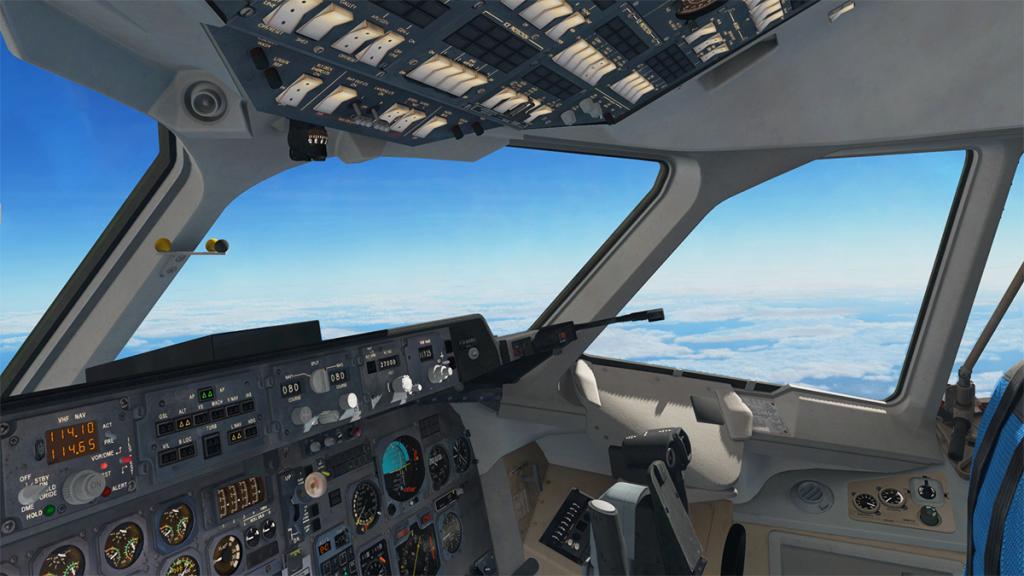














































.thumb.jpg.a237d93489d8dc27b280f2fb22342d67.jpg)
.thumb.jpg.77b4fe41bb5b96ad80028f53d9cb59a2.jpg)
.thumb.jpg.9cf1d5028f4e0485bb82f3c29ba90edd.jpg)
.thumb.jpg.15ccd4f9a1d166ff988a0cef42200541.jpg)
.thumb.jpg.948d89144427b44e9a91c0815f1f4047.jpg)
.thumb.jpg.43067c1815a94a4d638ec91a00c9c341.jpg)
.thumb.jpg.79bb4237e663bb1d8bcd00003a7567ad.jpg)
.thumb.jpg.b40894a8dedb851c4f10dfb493ac49b6.jpg)
.thumb.jpg.7d3af827662c9767513a0f9b062f28ce.jpg)
.thumb.jpg.b17151b540a187c24c4d2683669f692d.jpg)

.thumb.jpg.8e4c4c13d023e62359d20c31c08cc42f.jpg)
.thumb.jpg.756ba4242a757f8fc4ceed276cbe22d2.jpg)
.thumb.jpg.b4a999941d7d384367e83e7cffe6542f.jpg)
.thumb.jpg.cac56dcffb982e01bc29fe8a5ab2cf80.jpg)
.thumb.jpg.fca0a3eab7c42d0146be7763dd69931b.jpg)
.thumb.jpg.86ea5388e04818377cf5203c36fb5a73.jpg)


